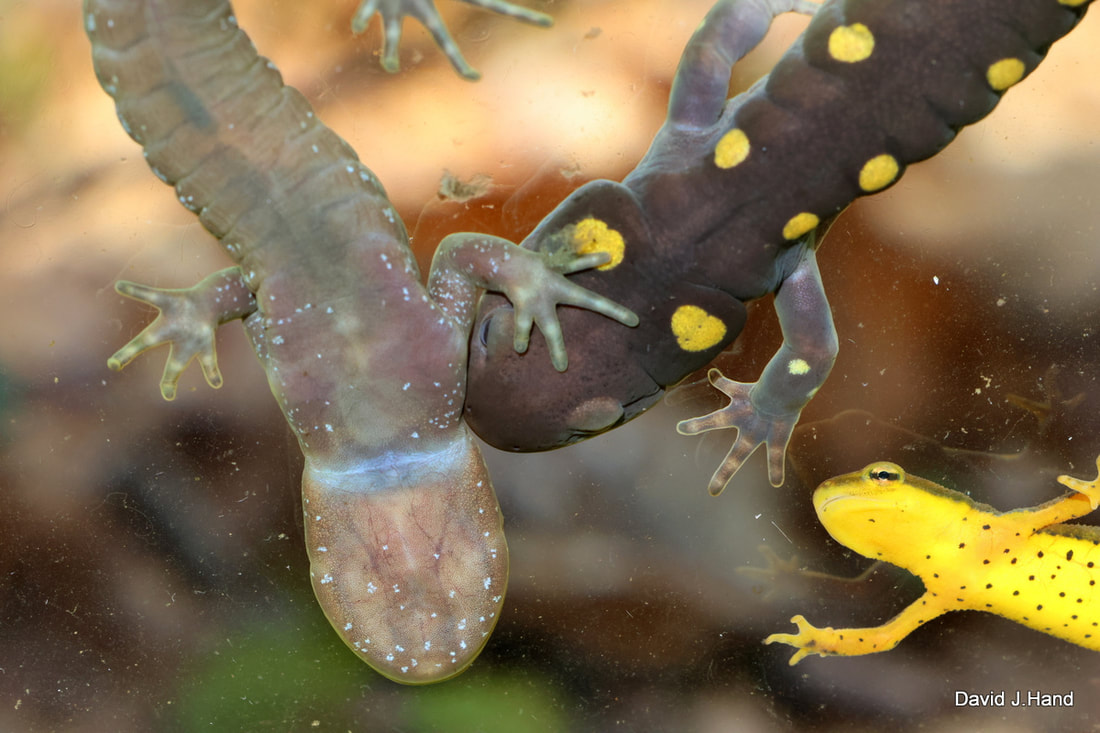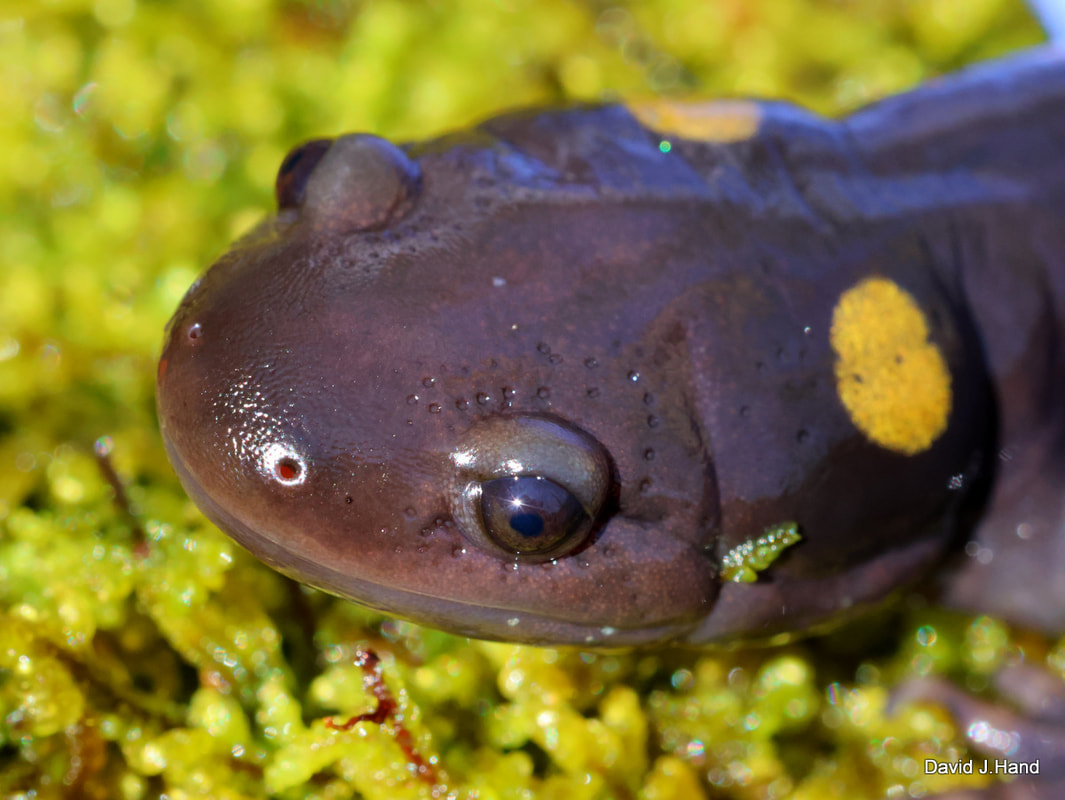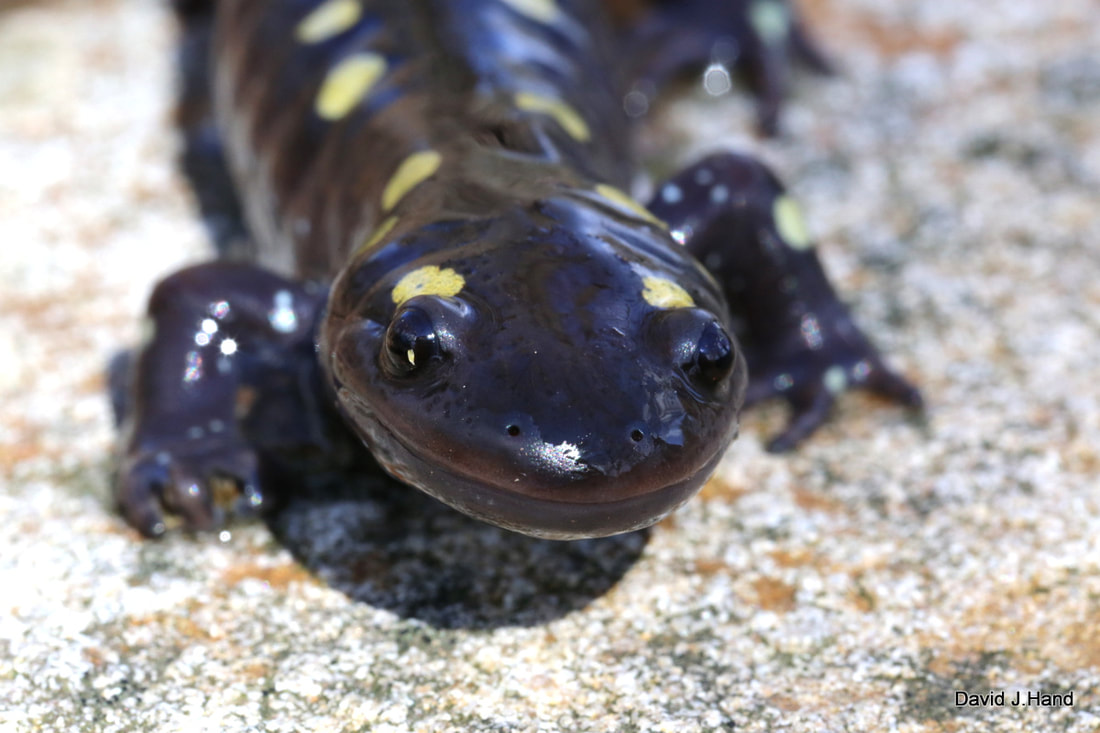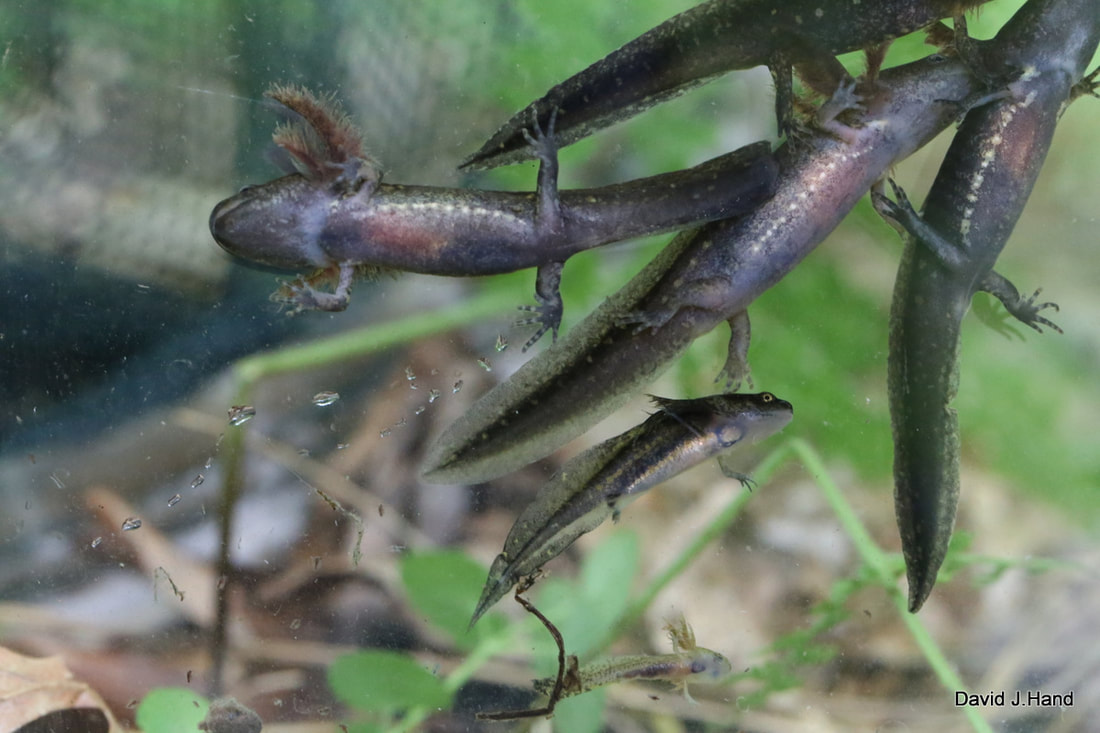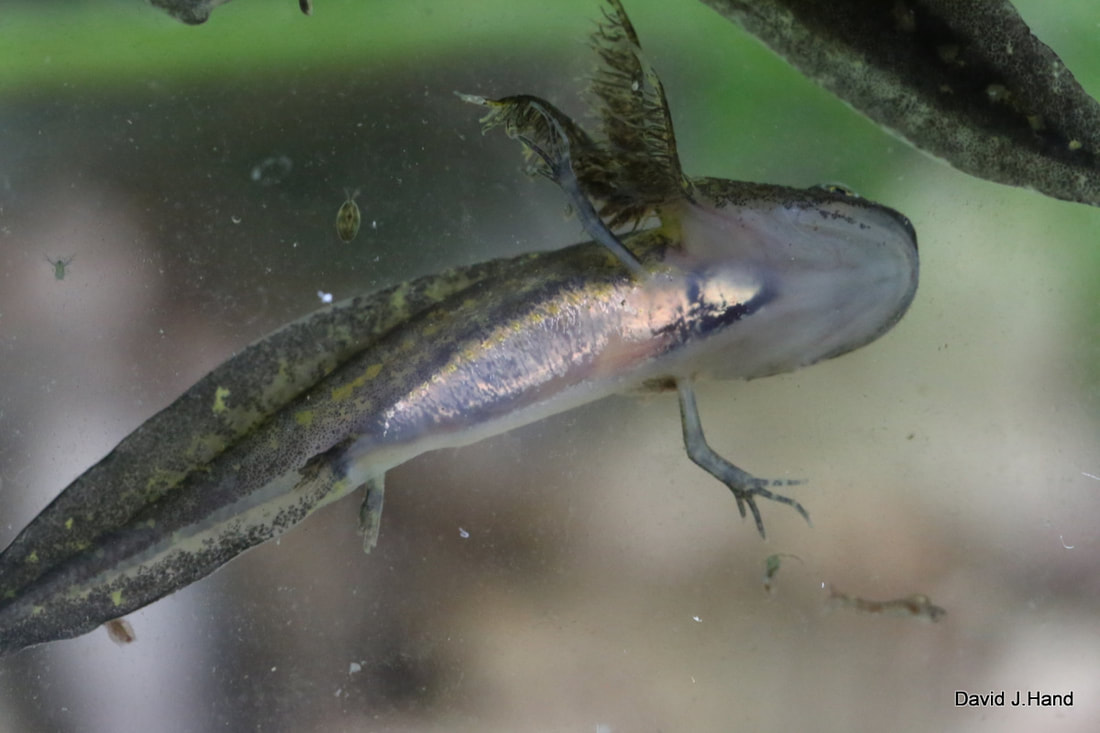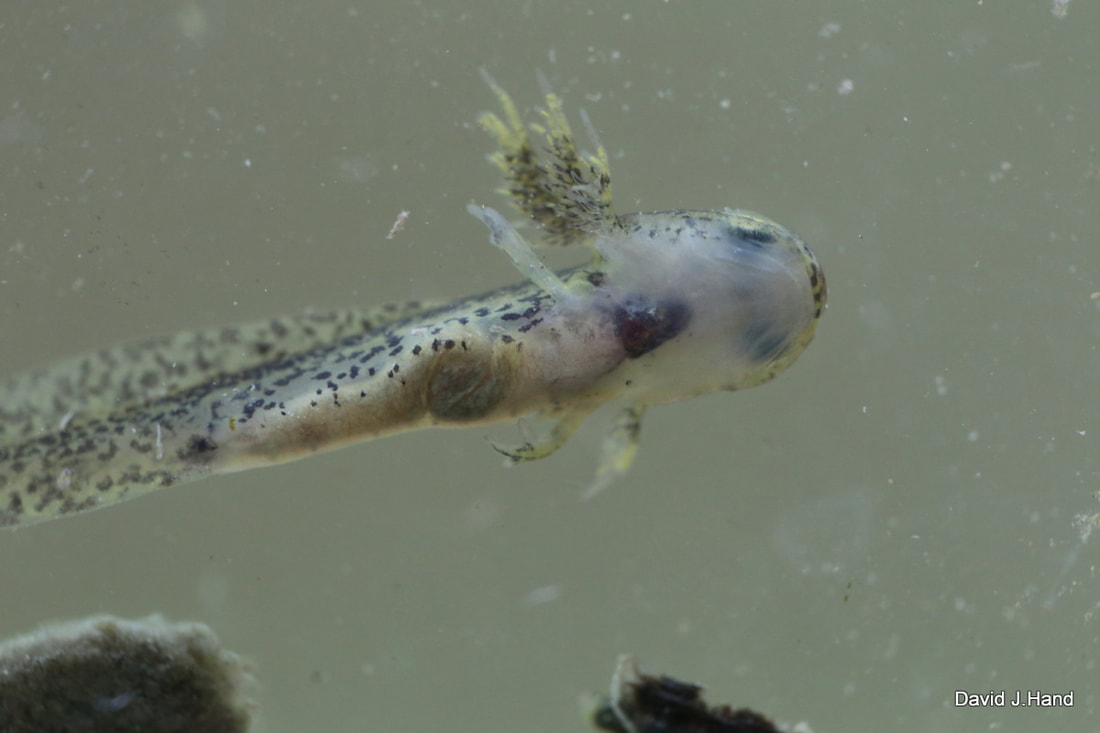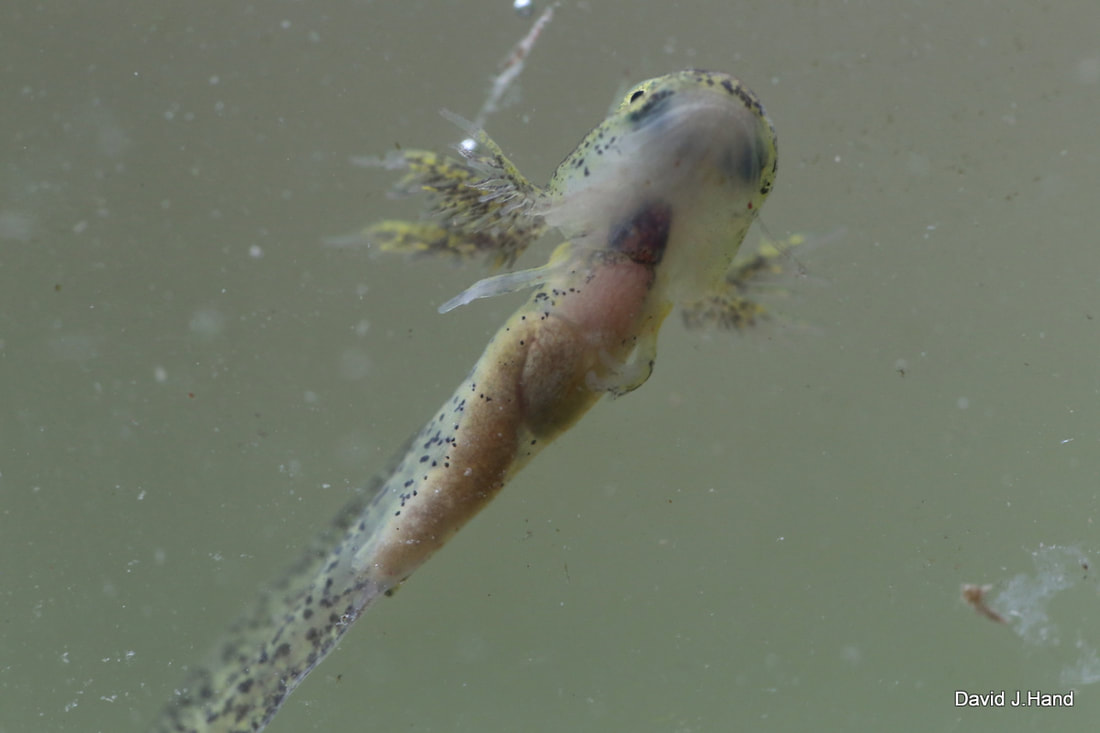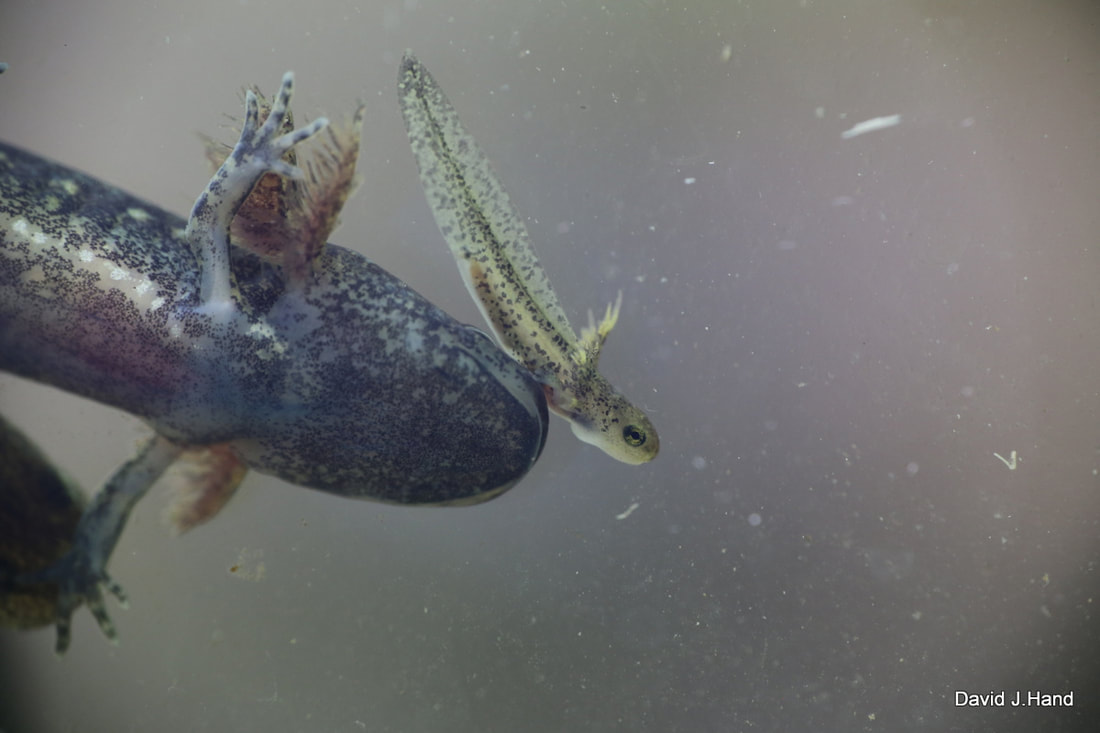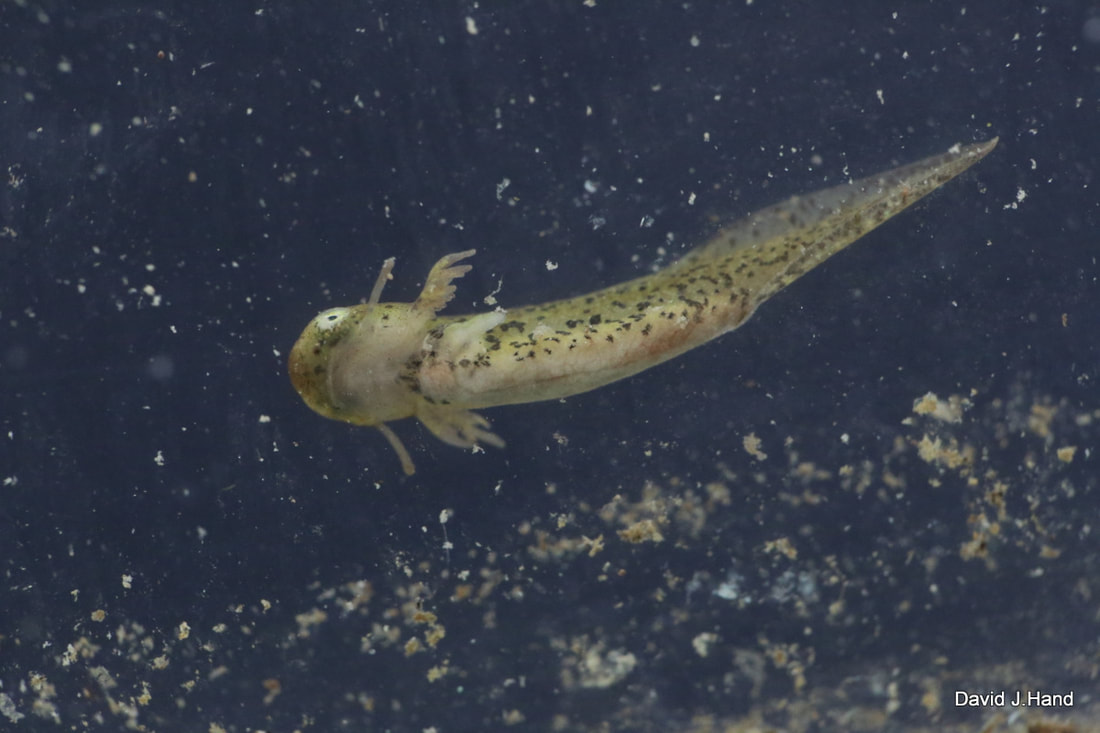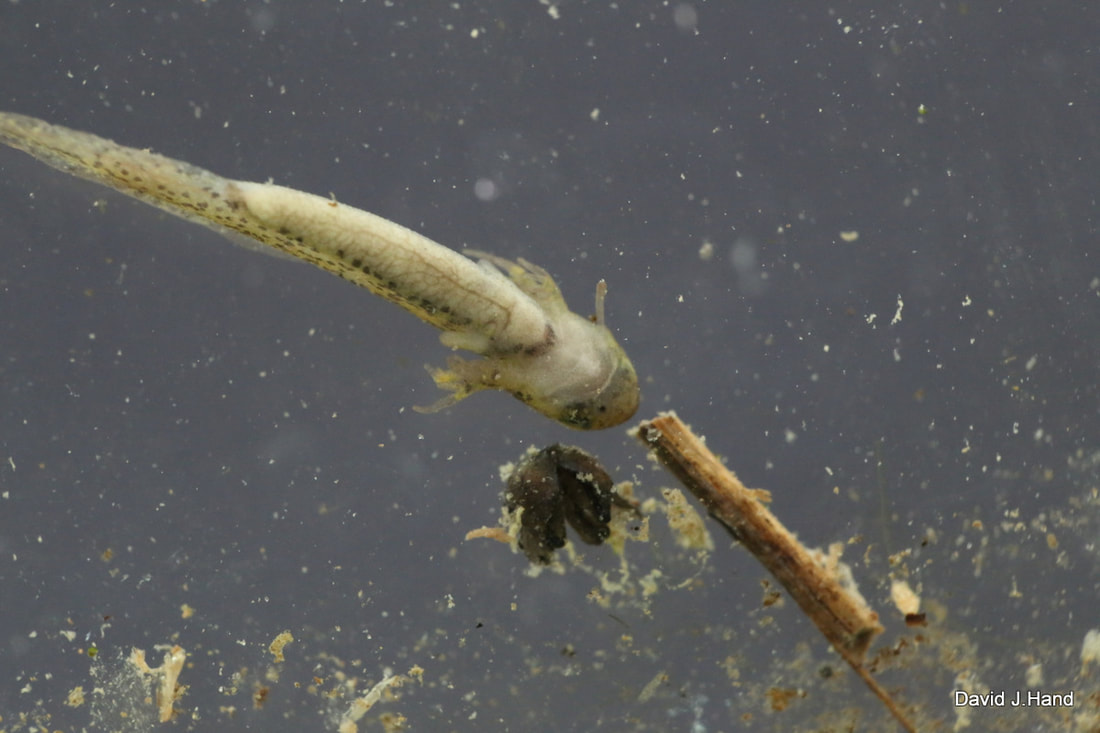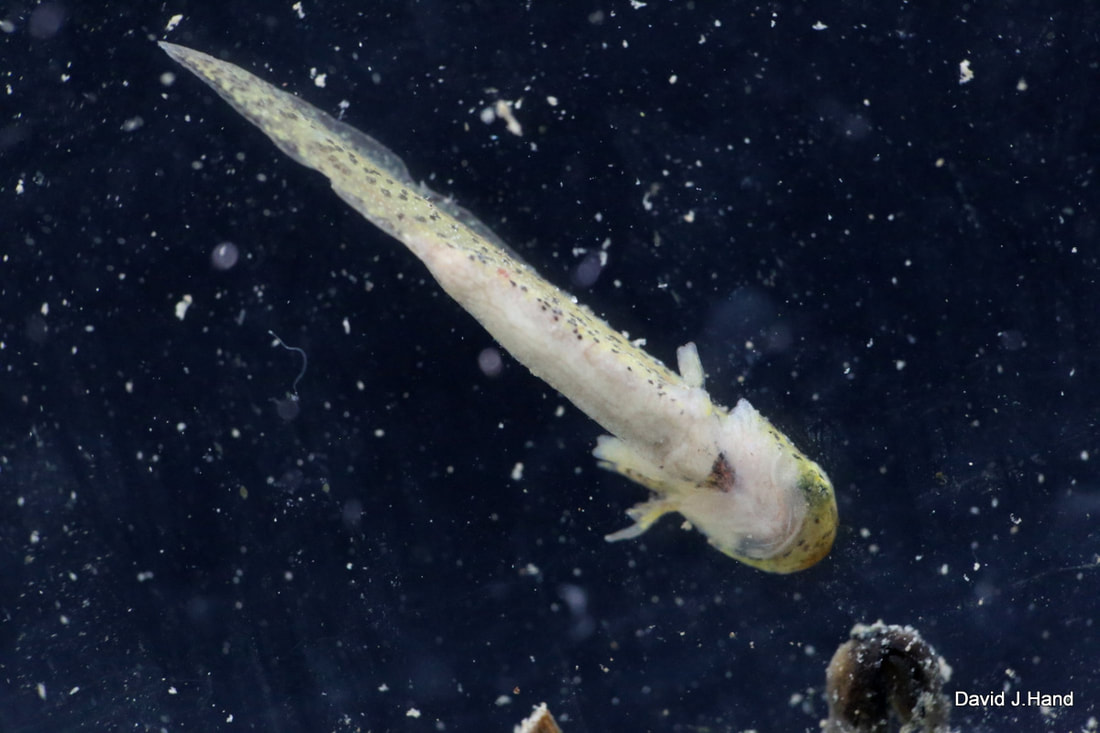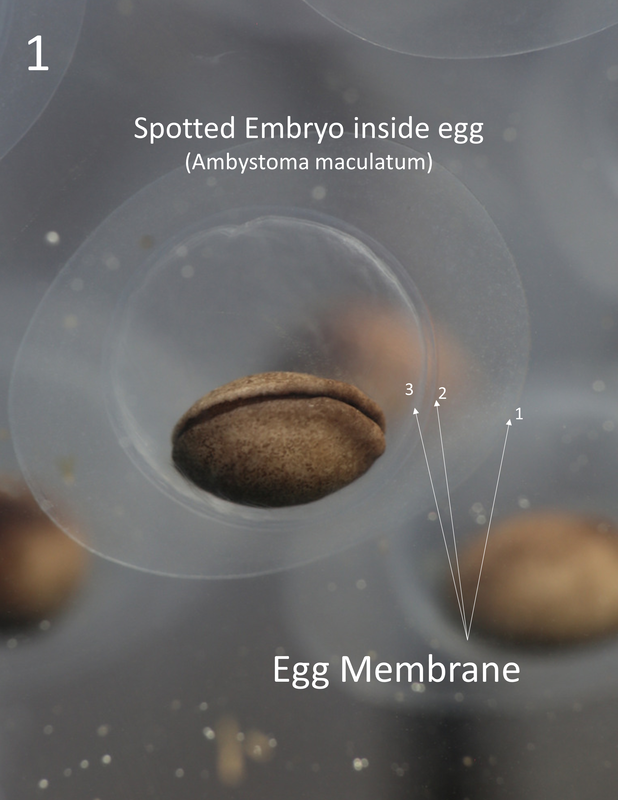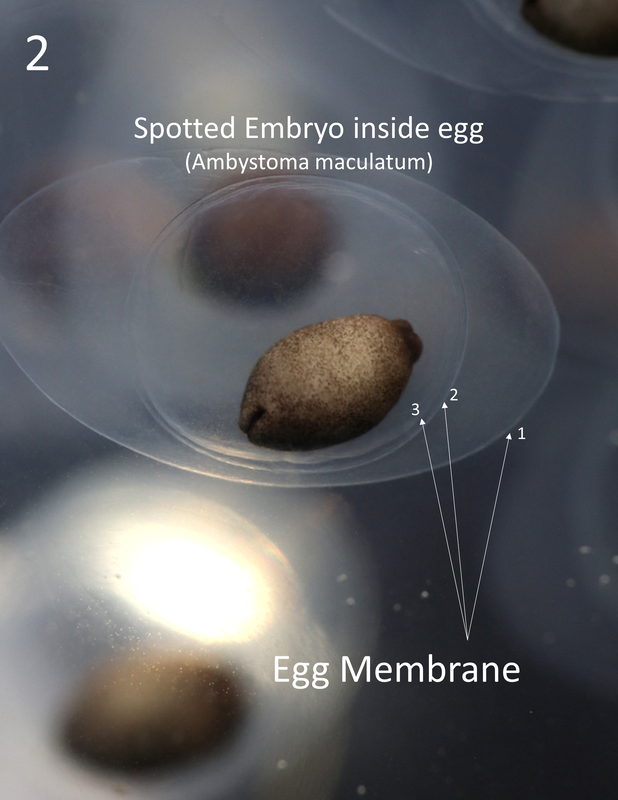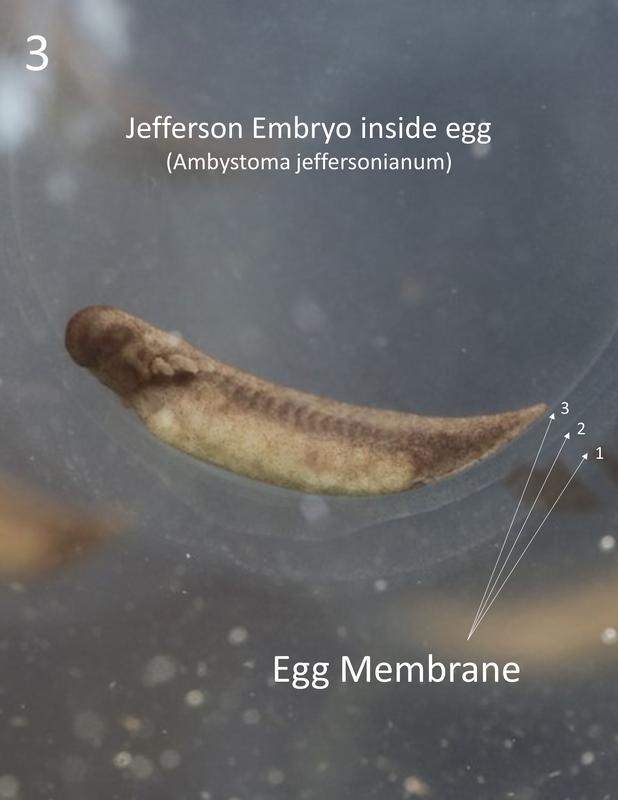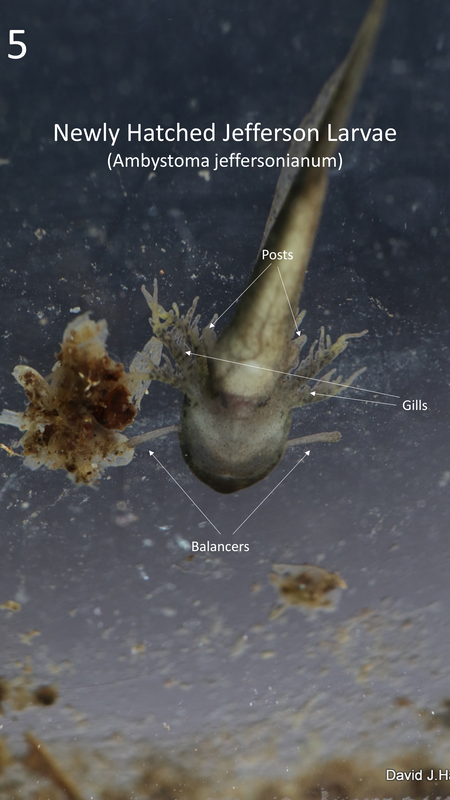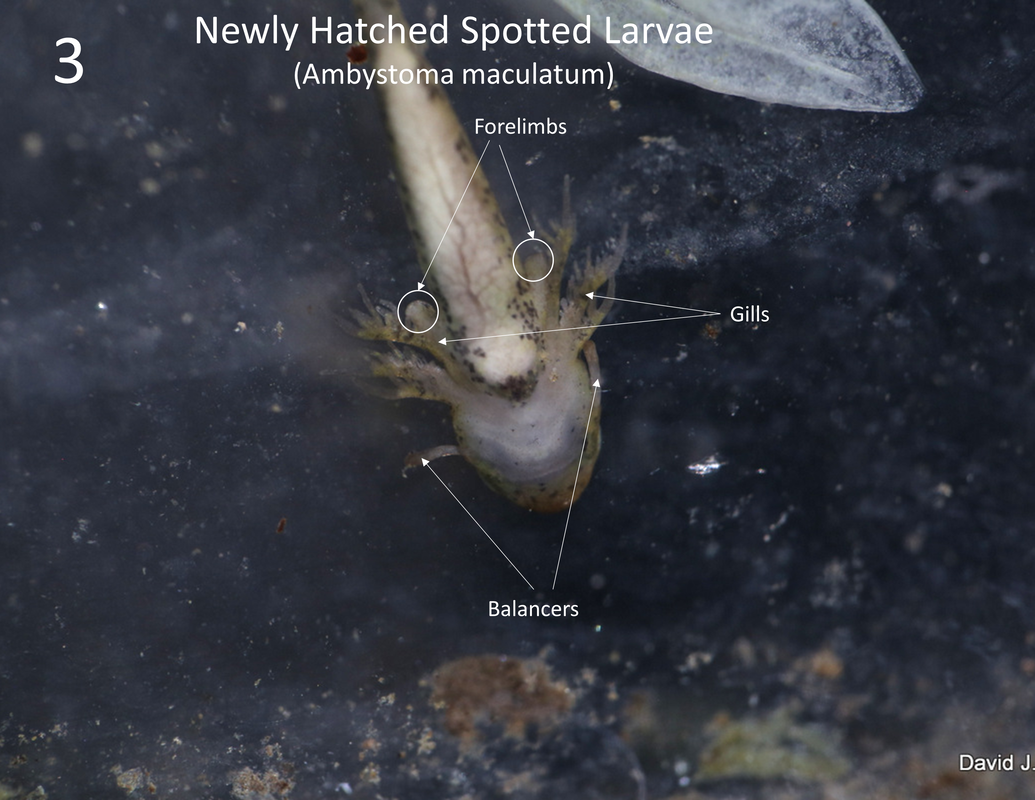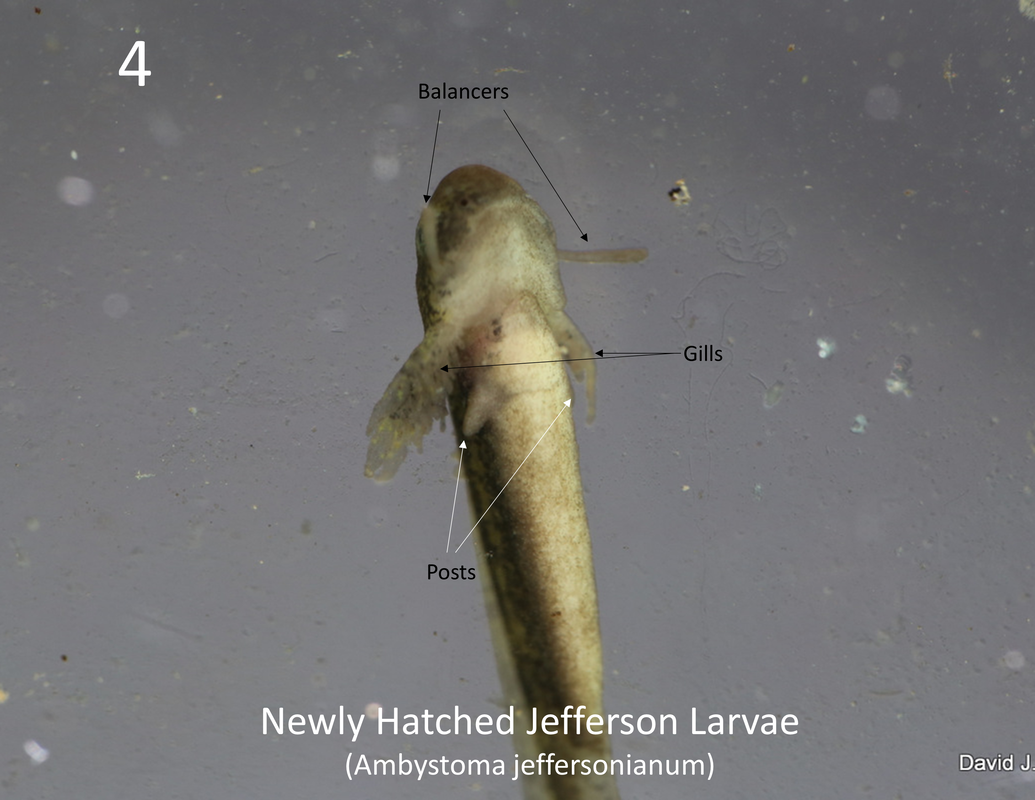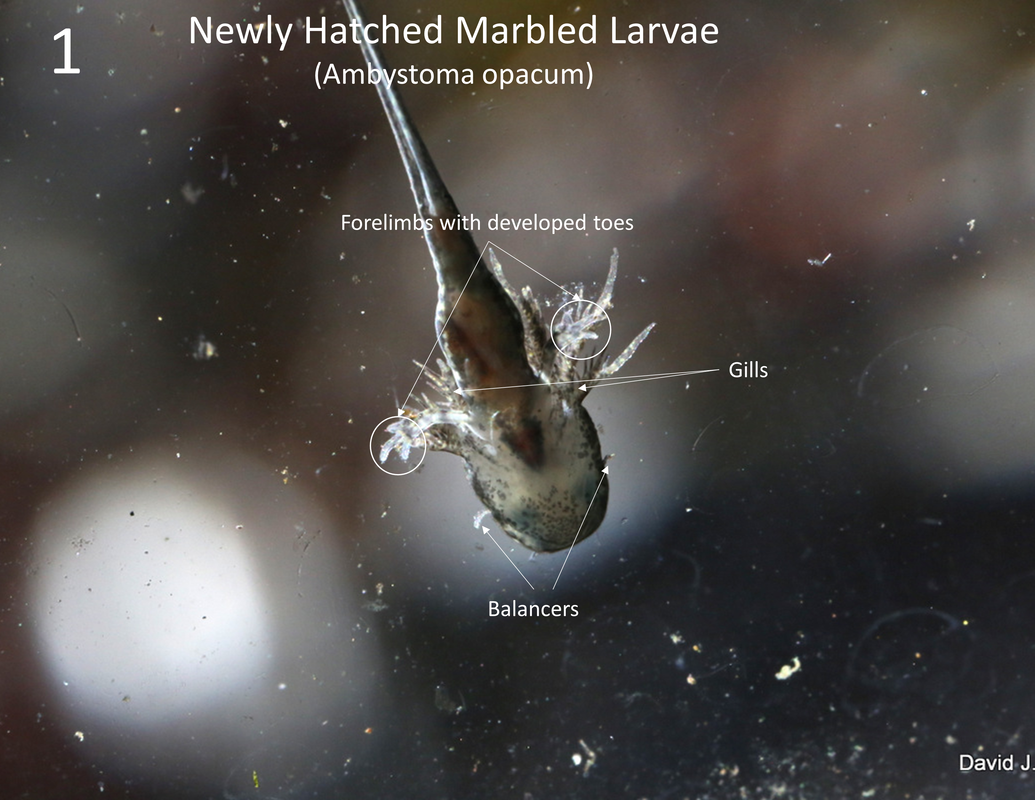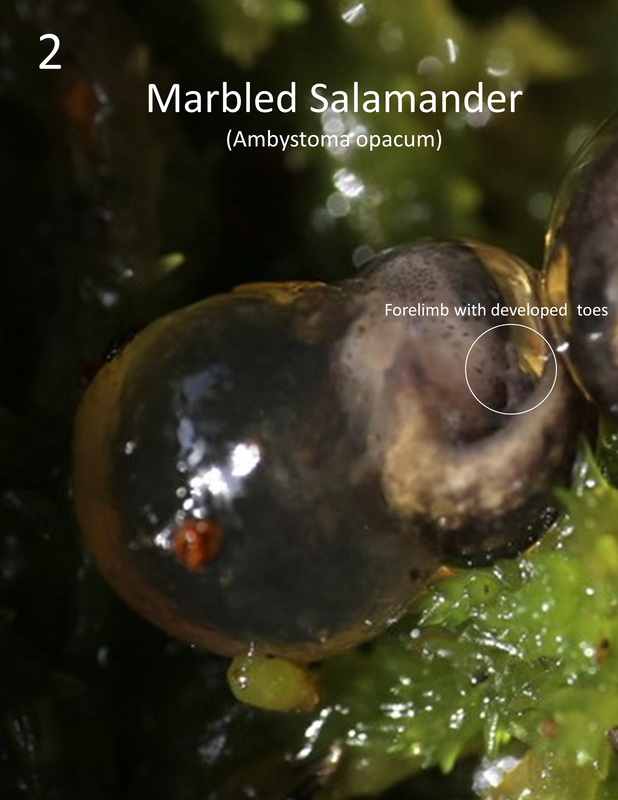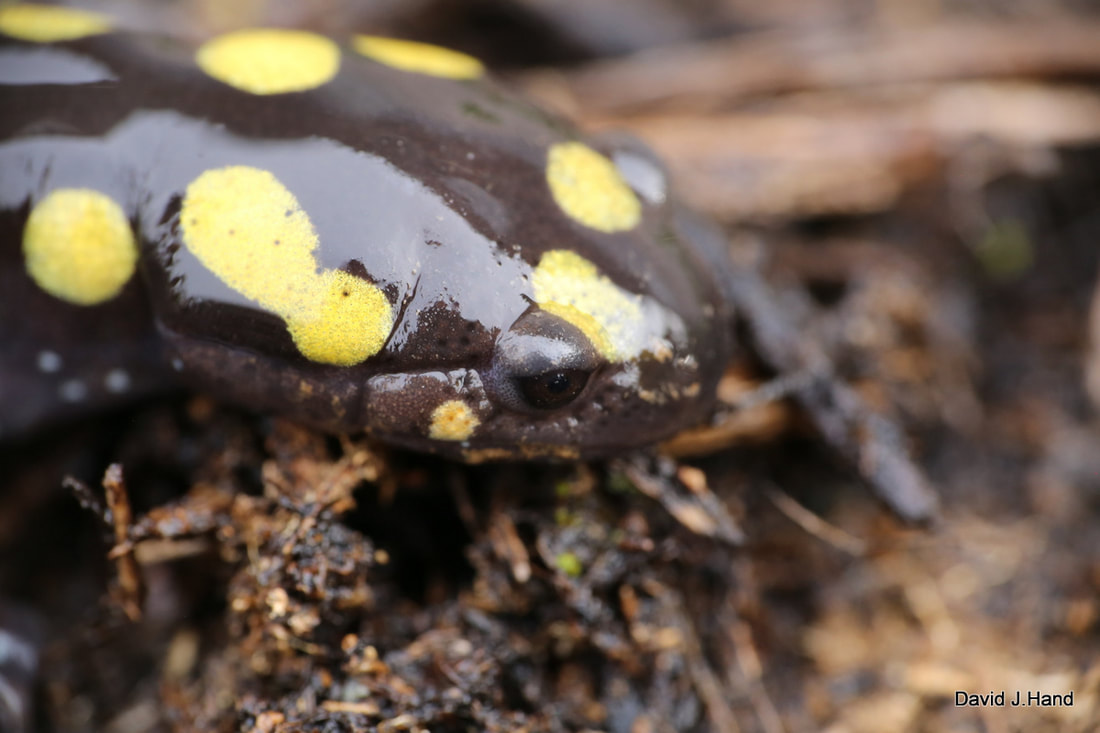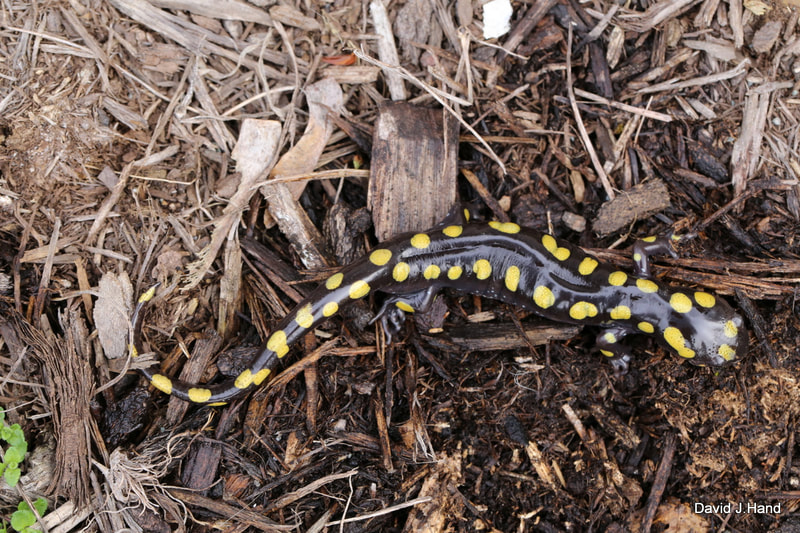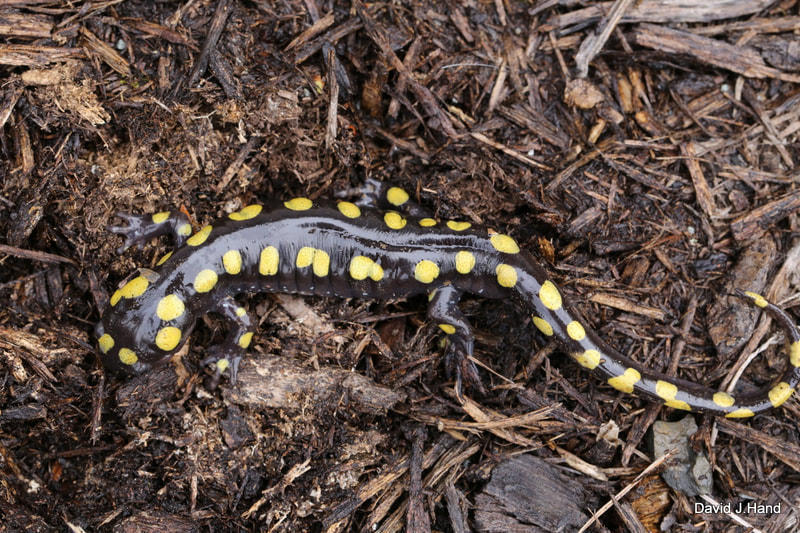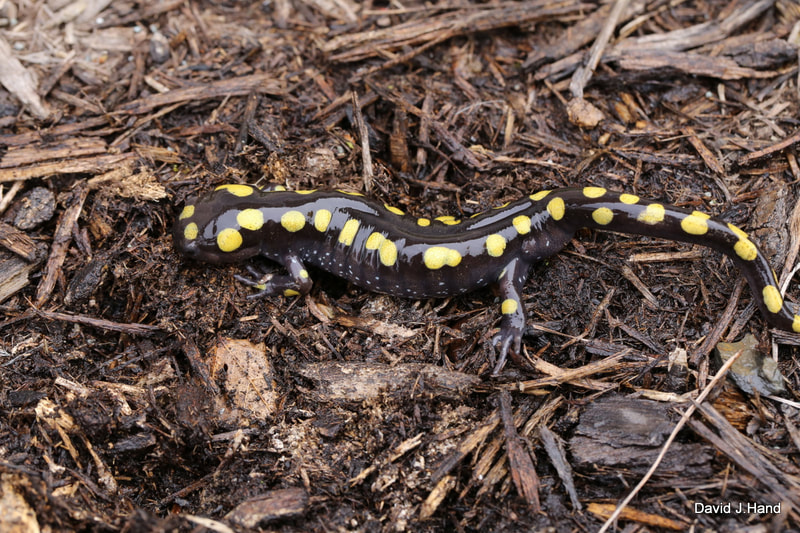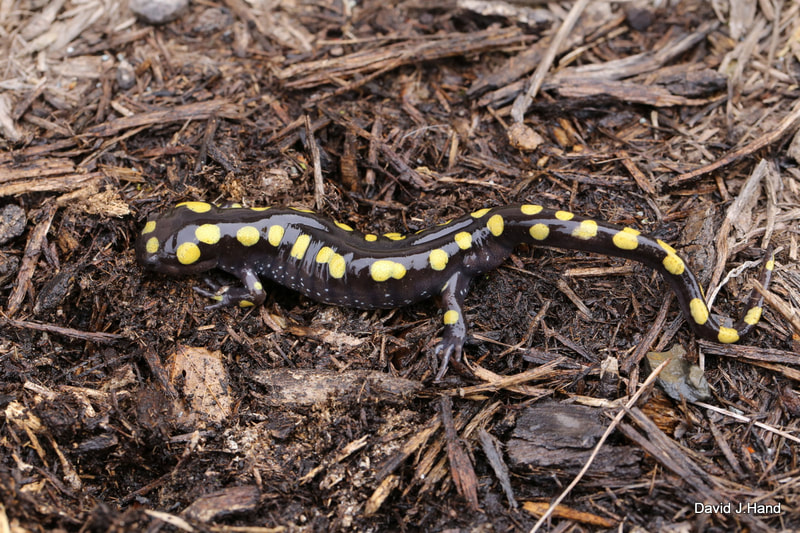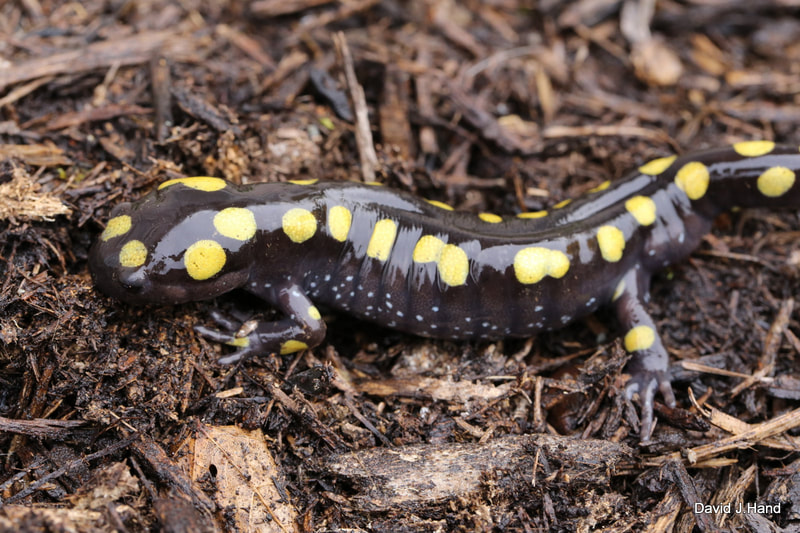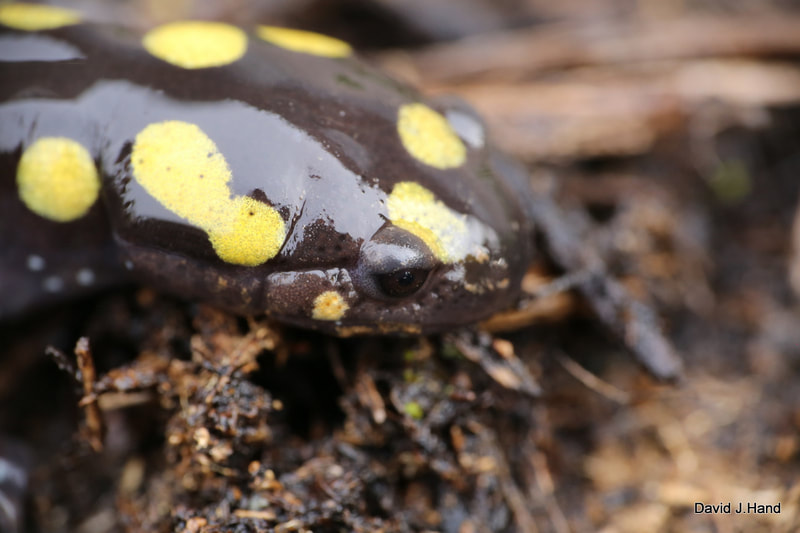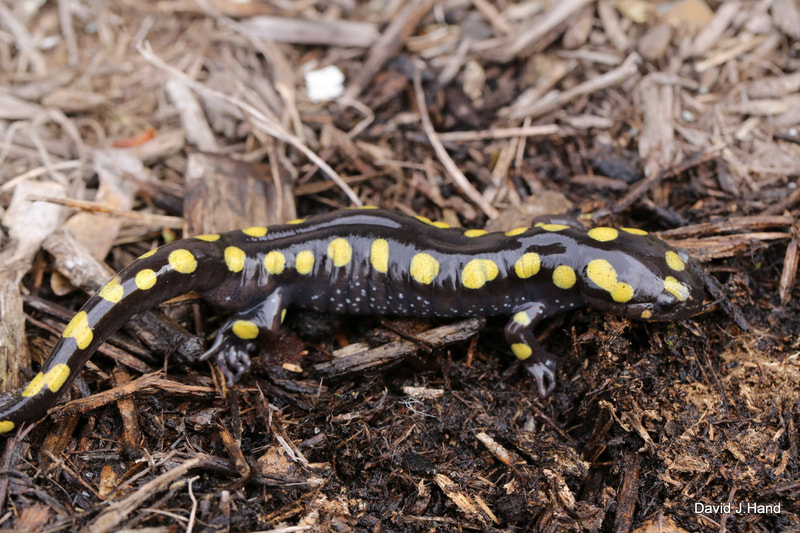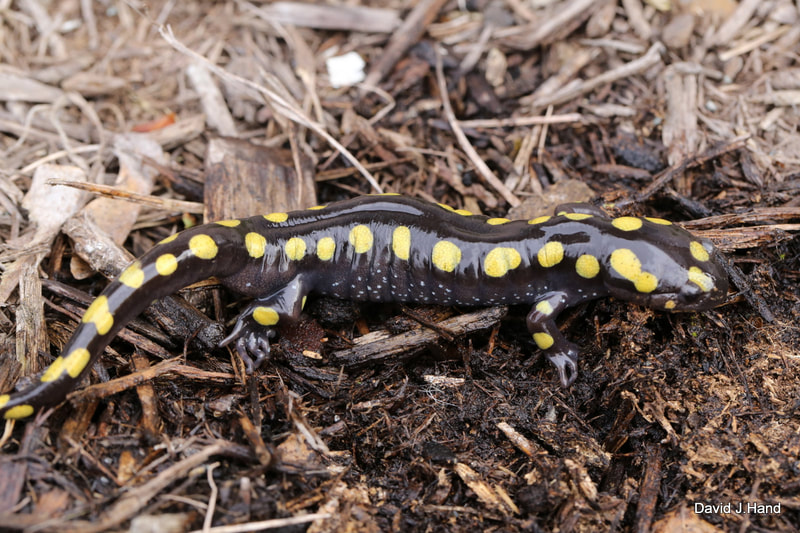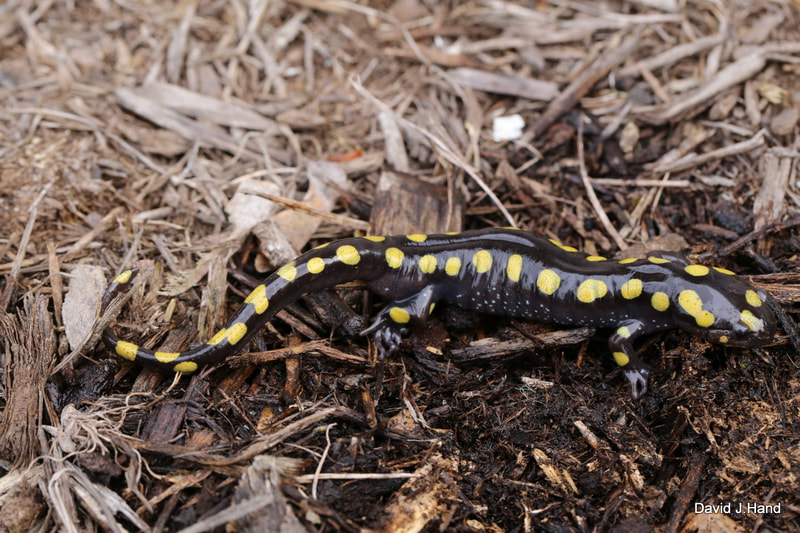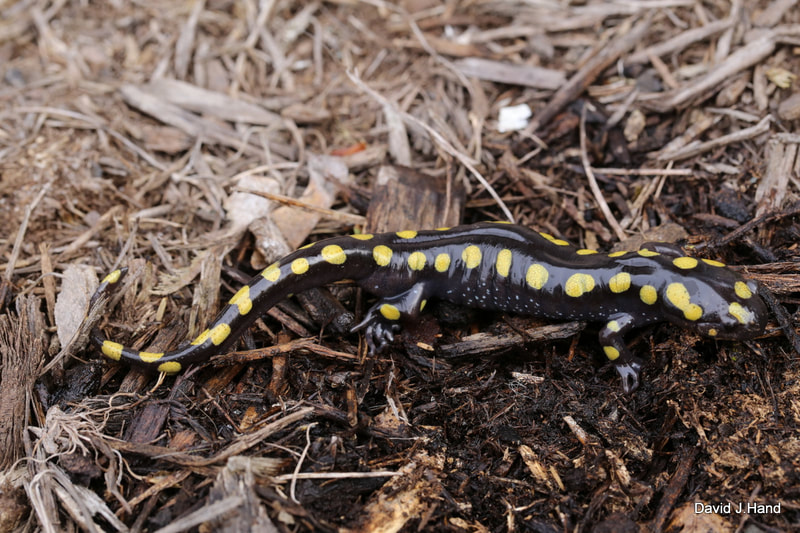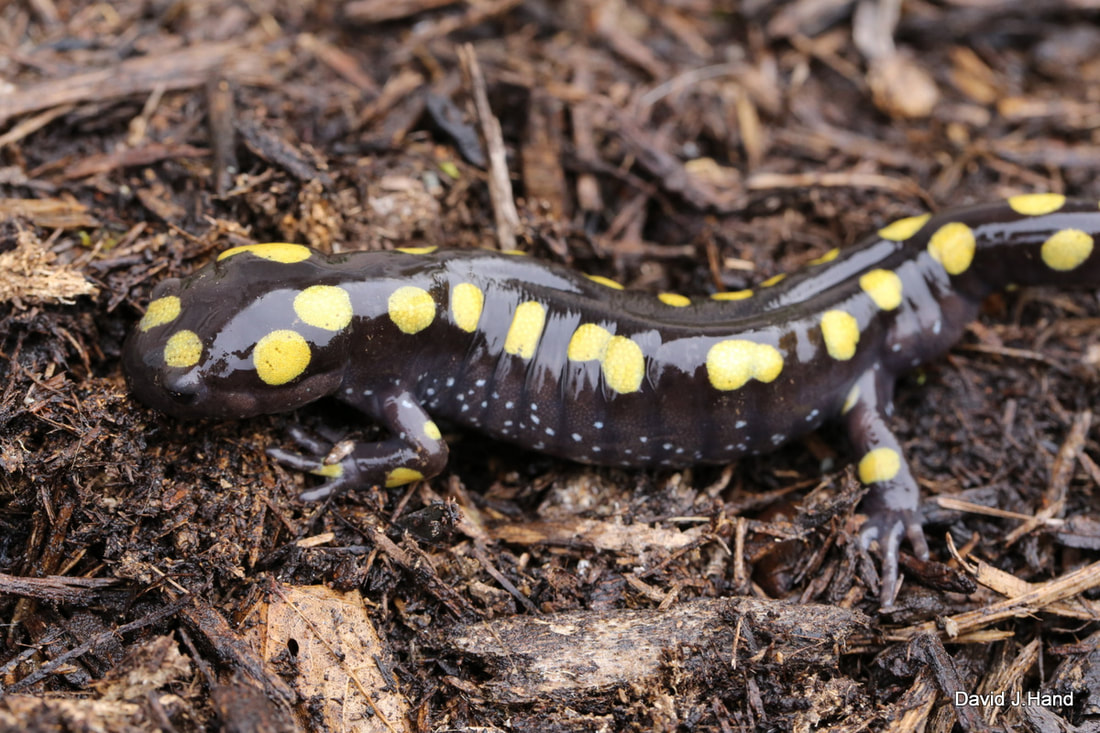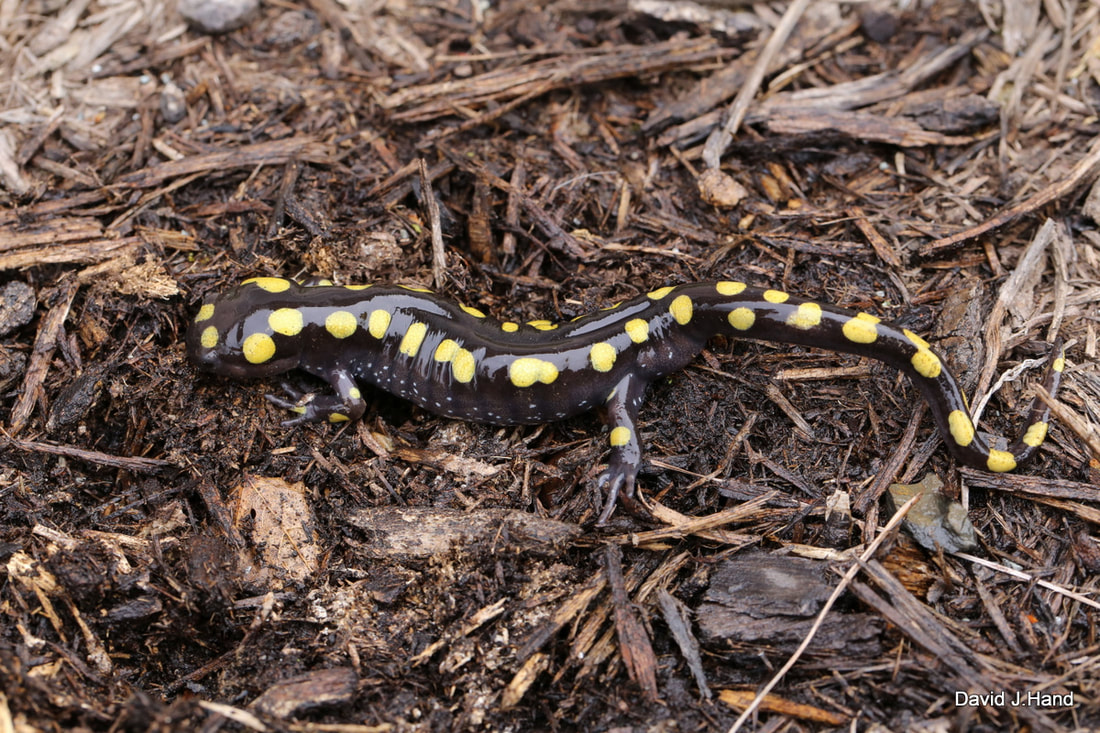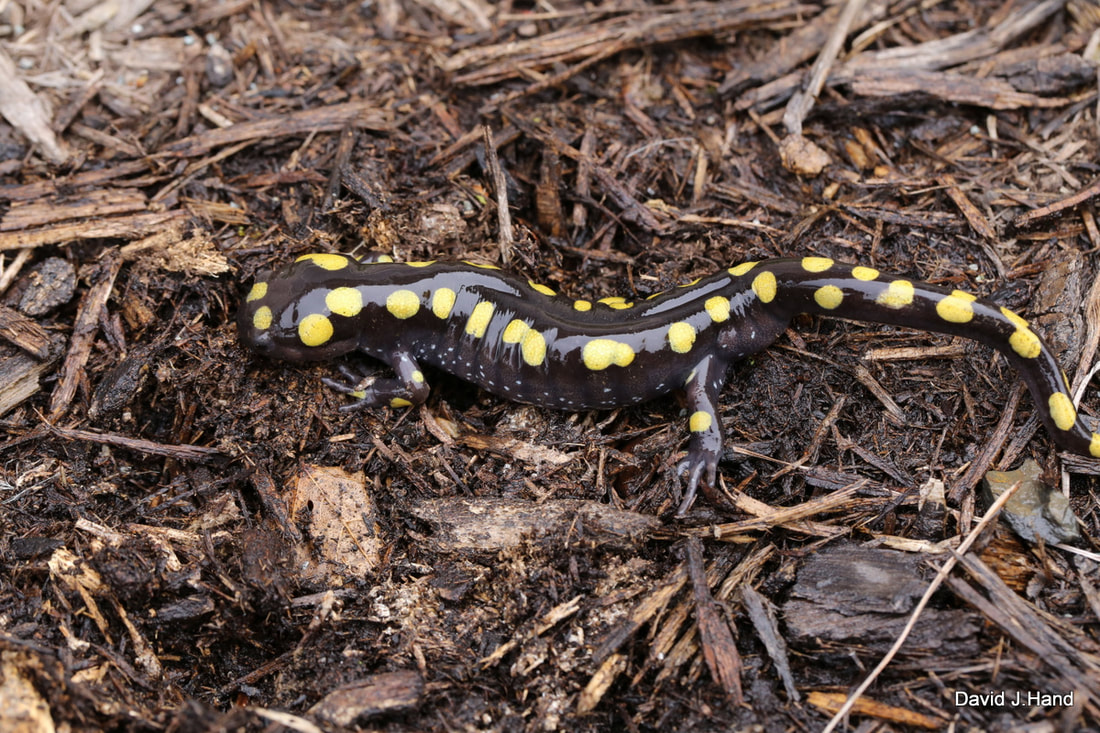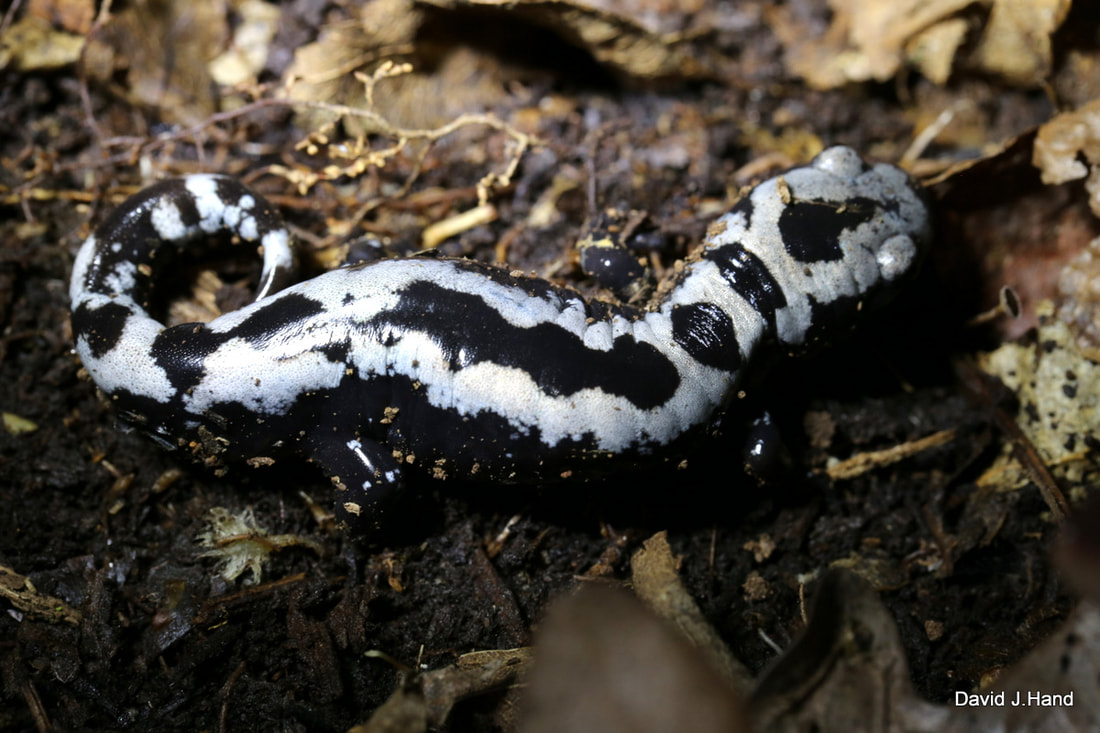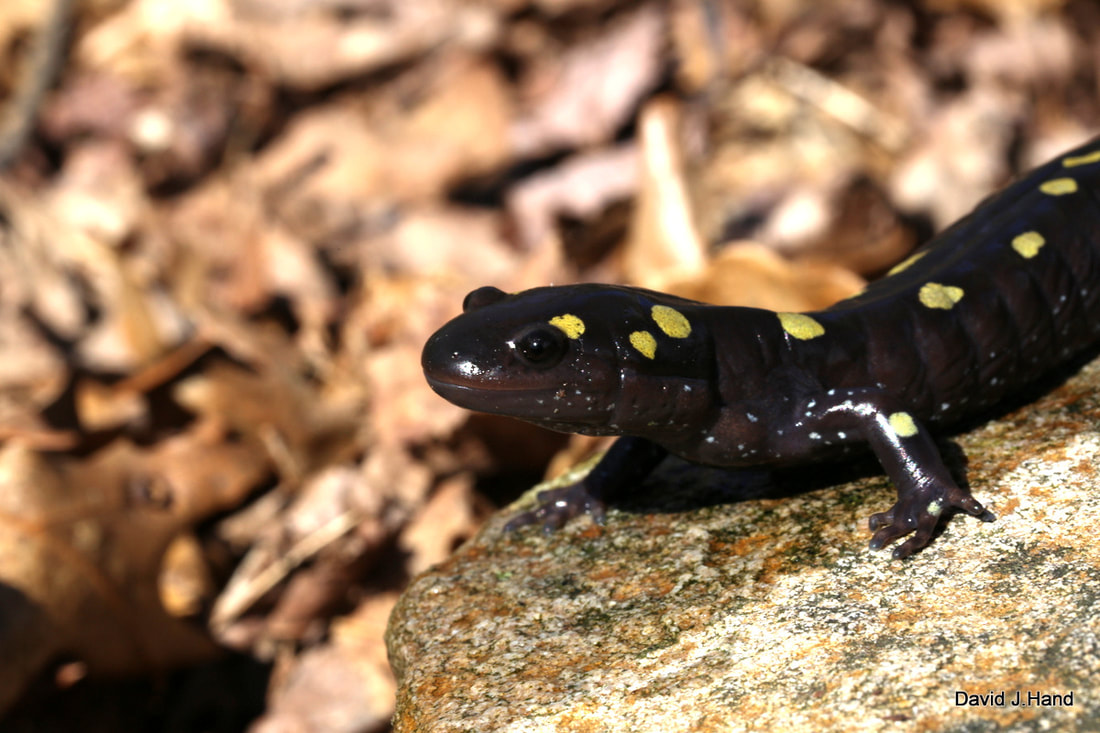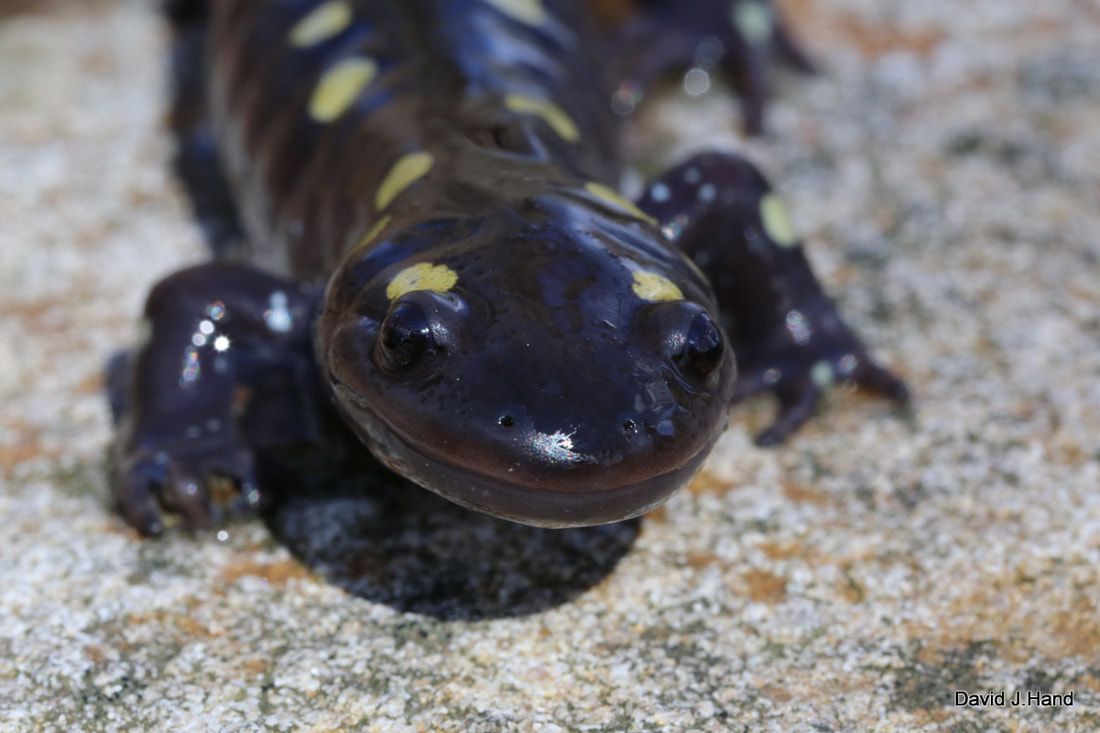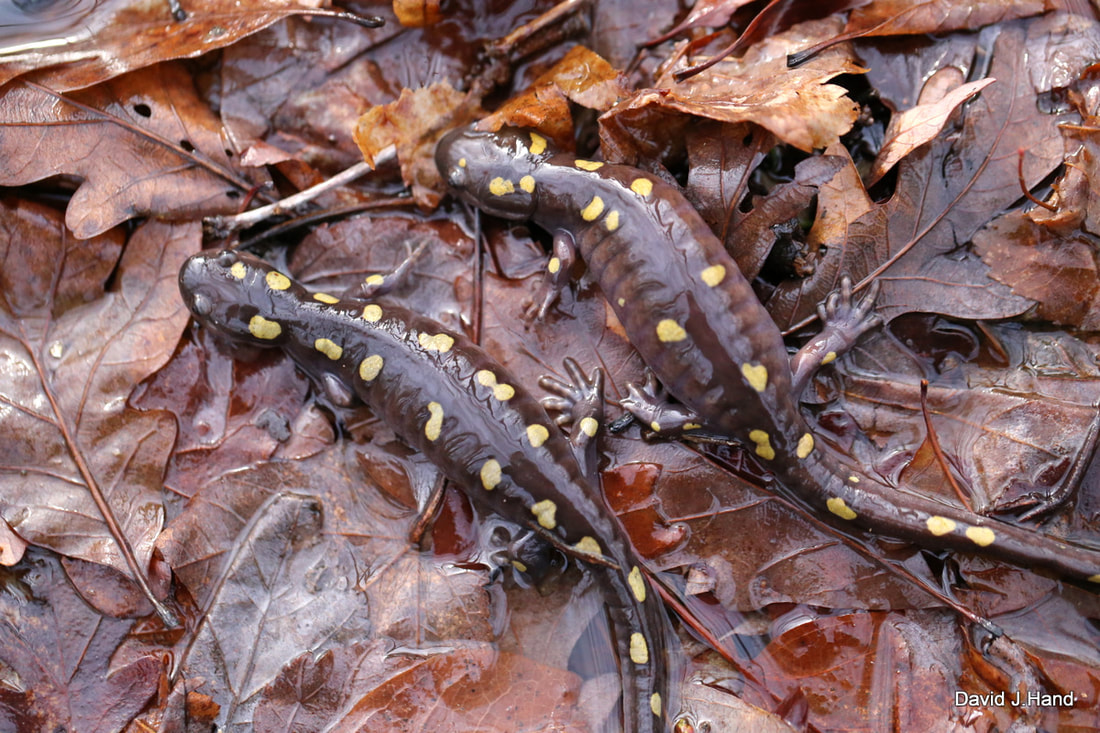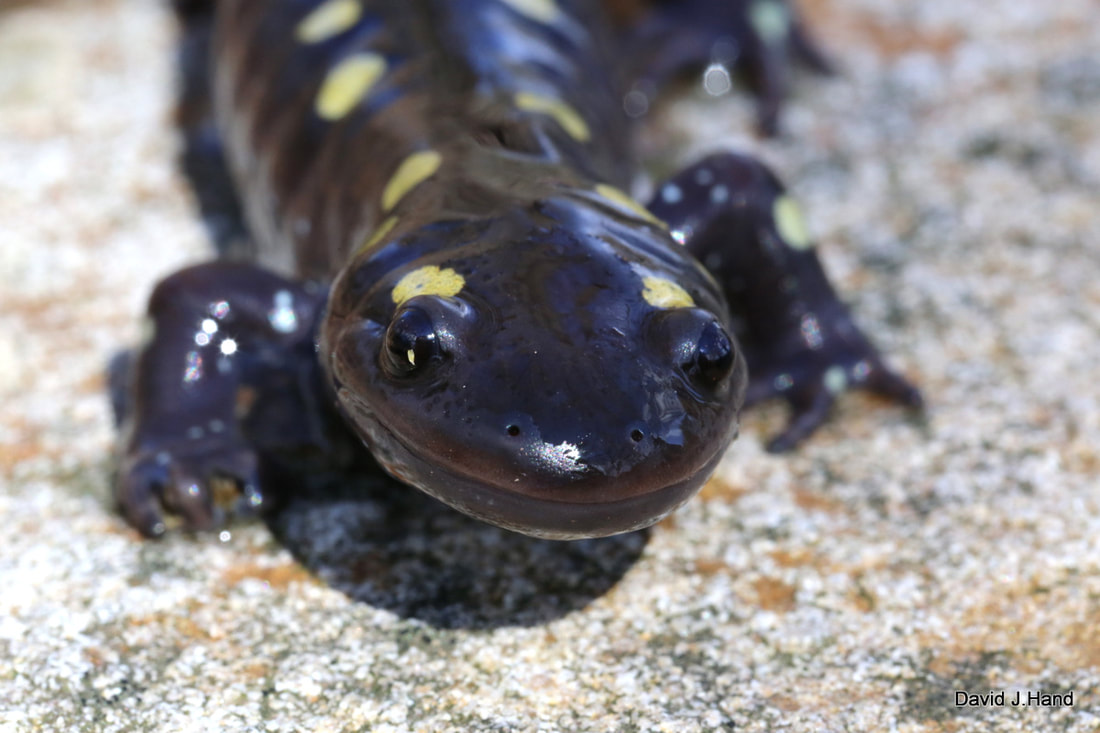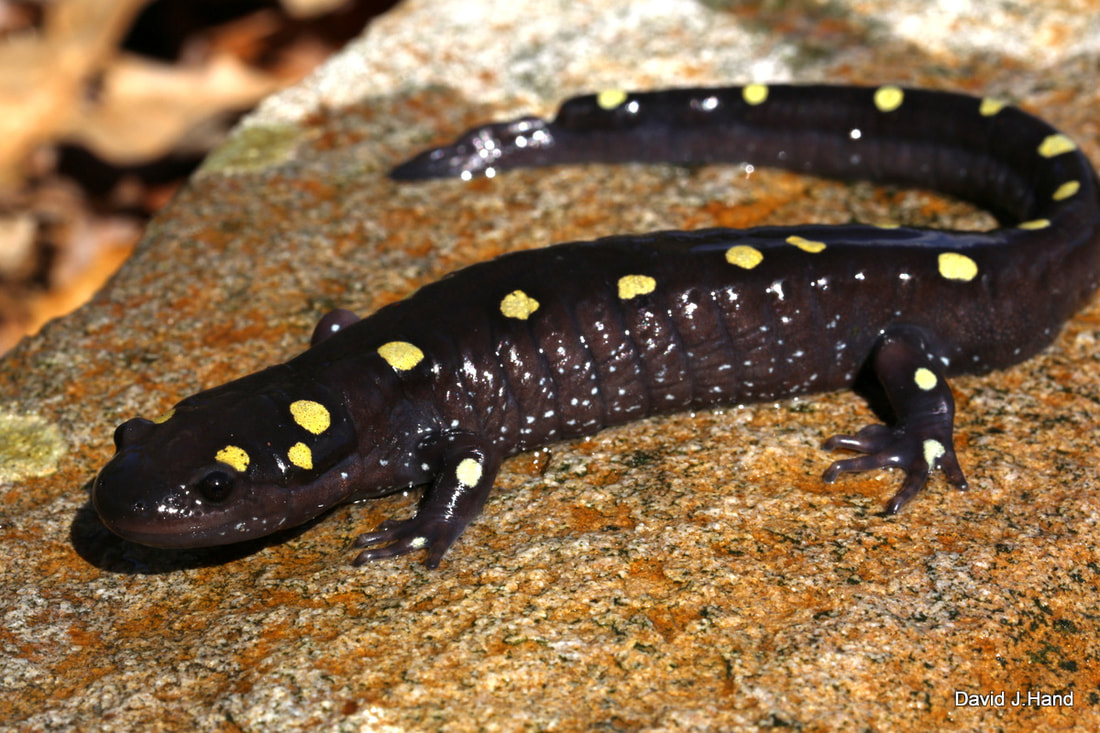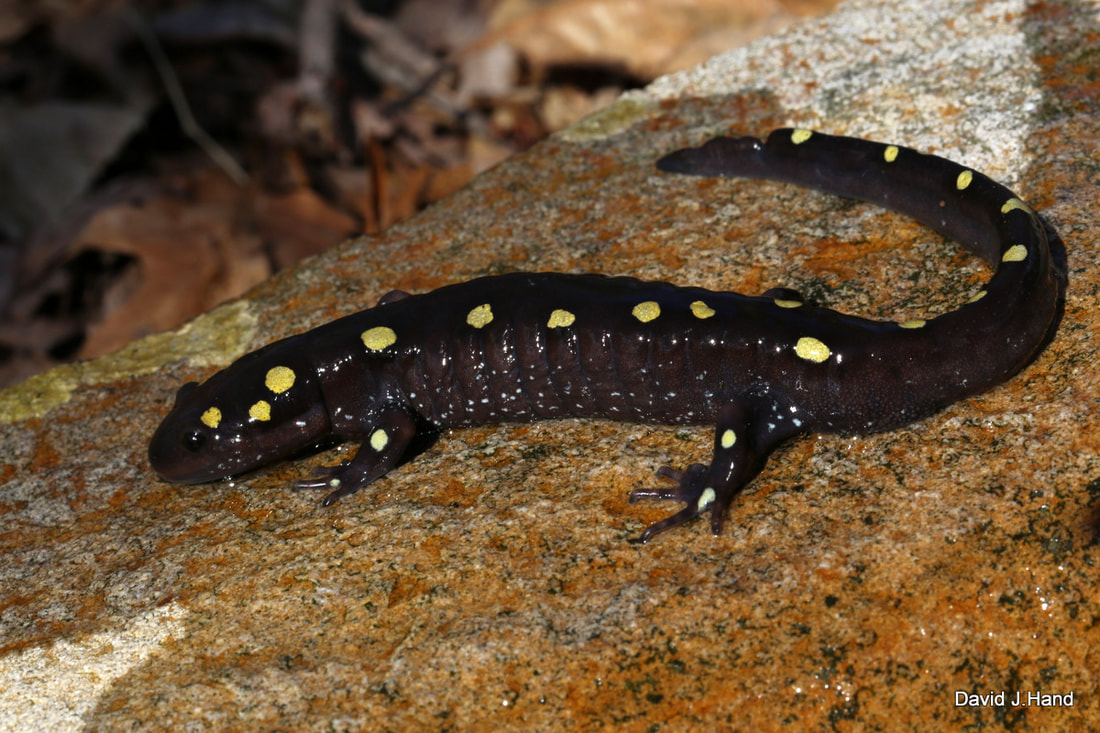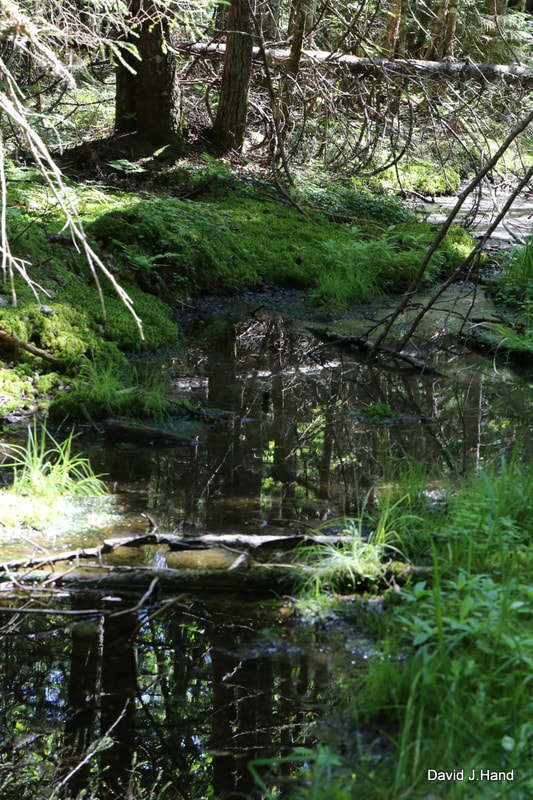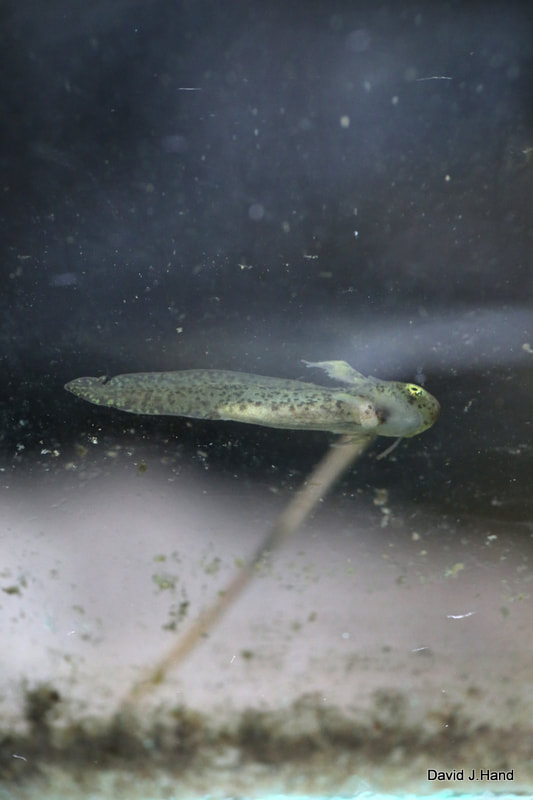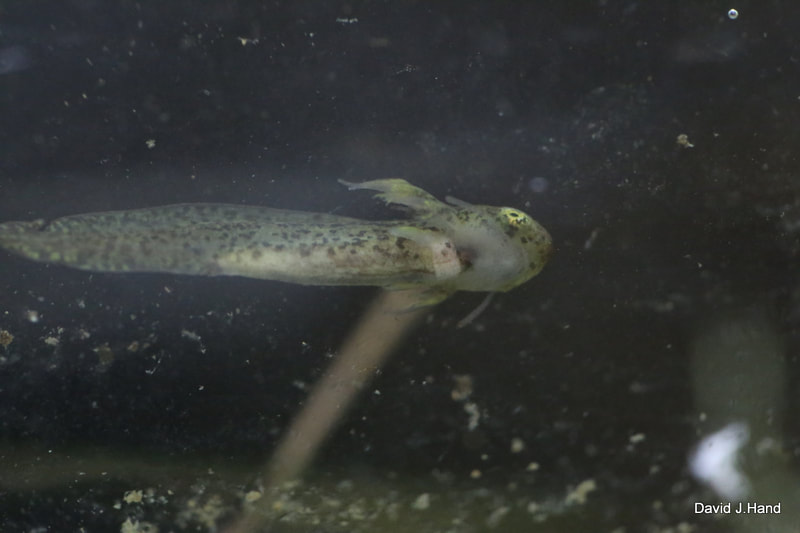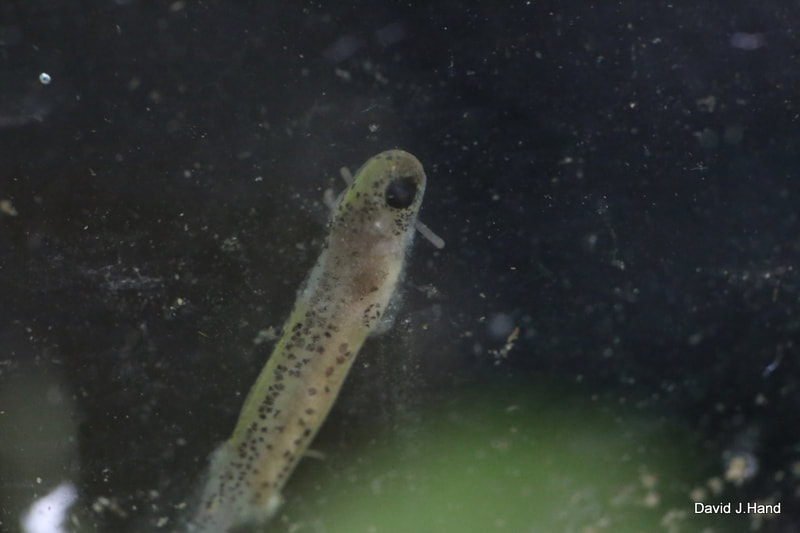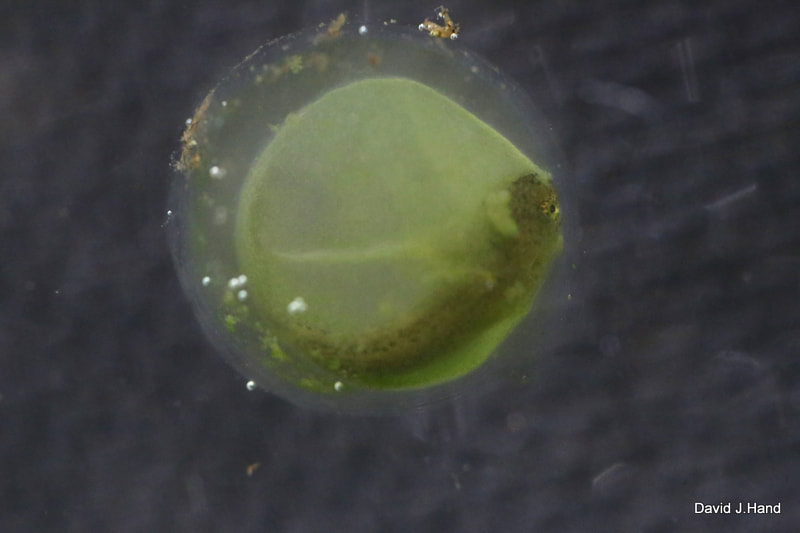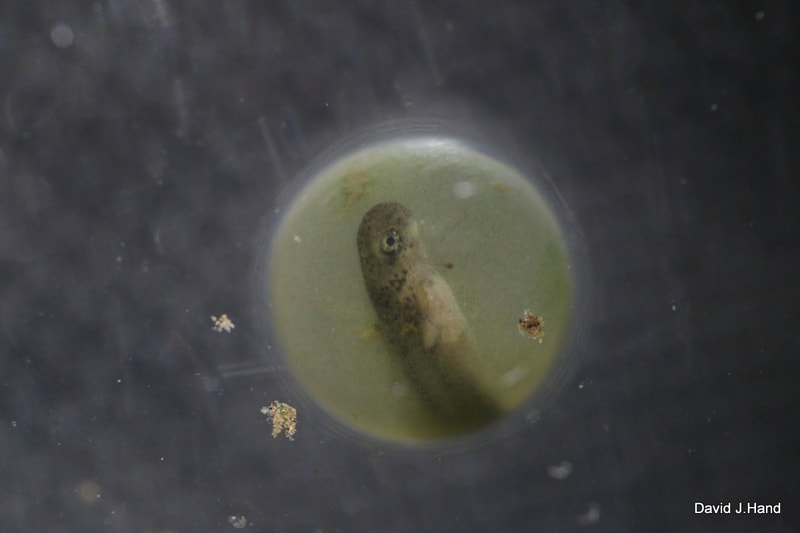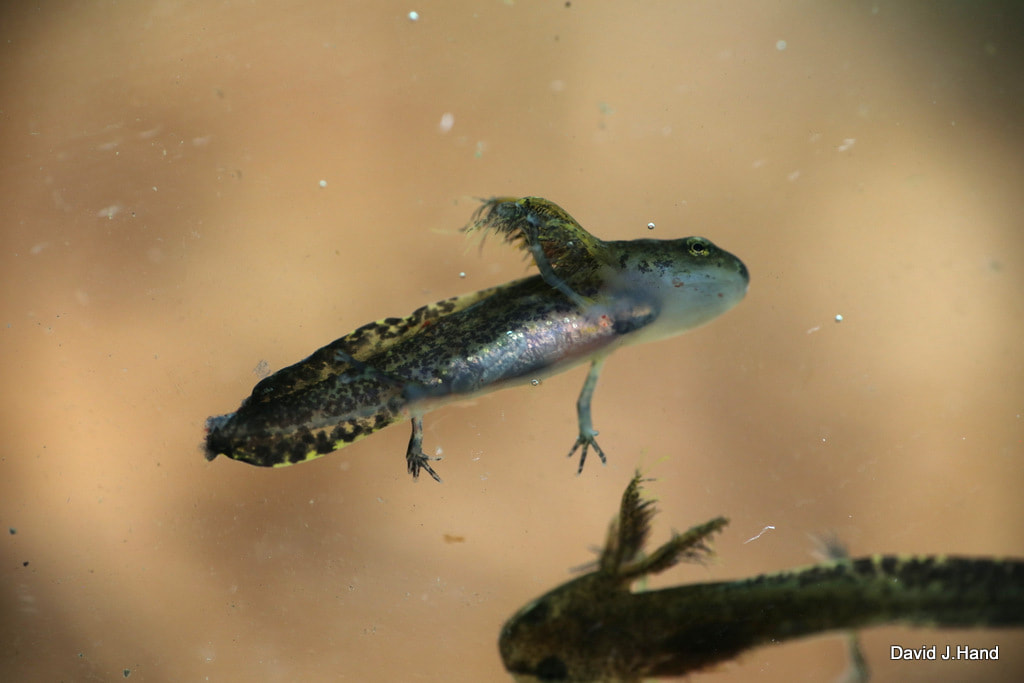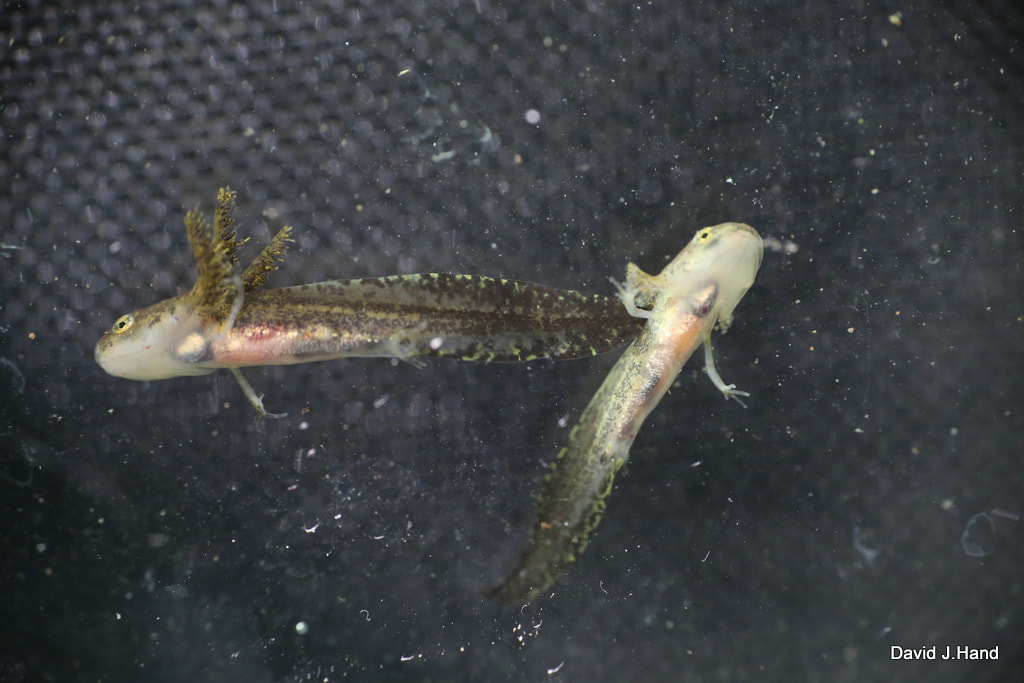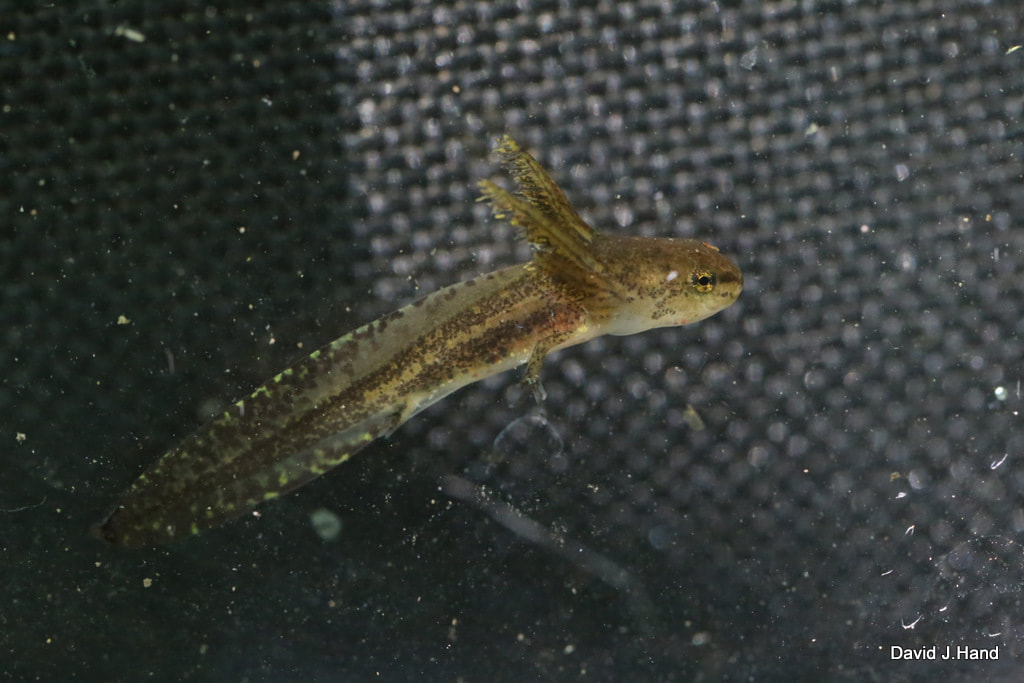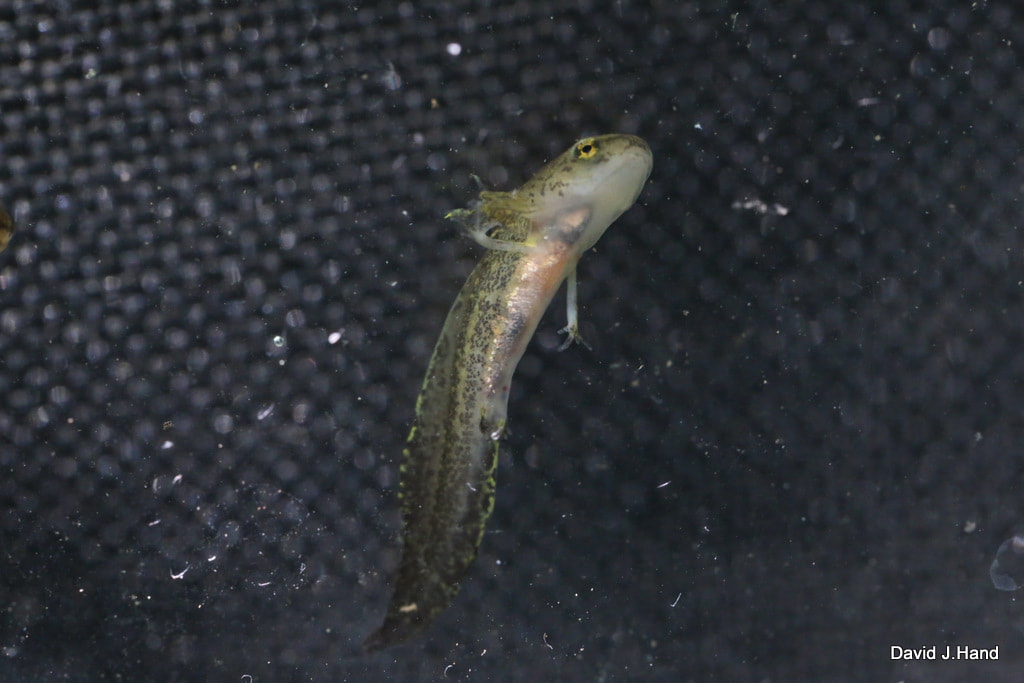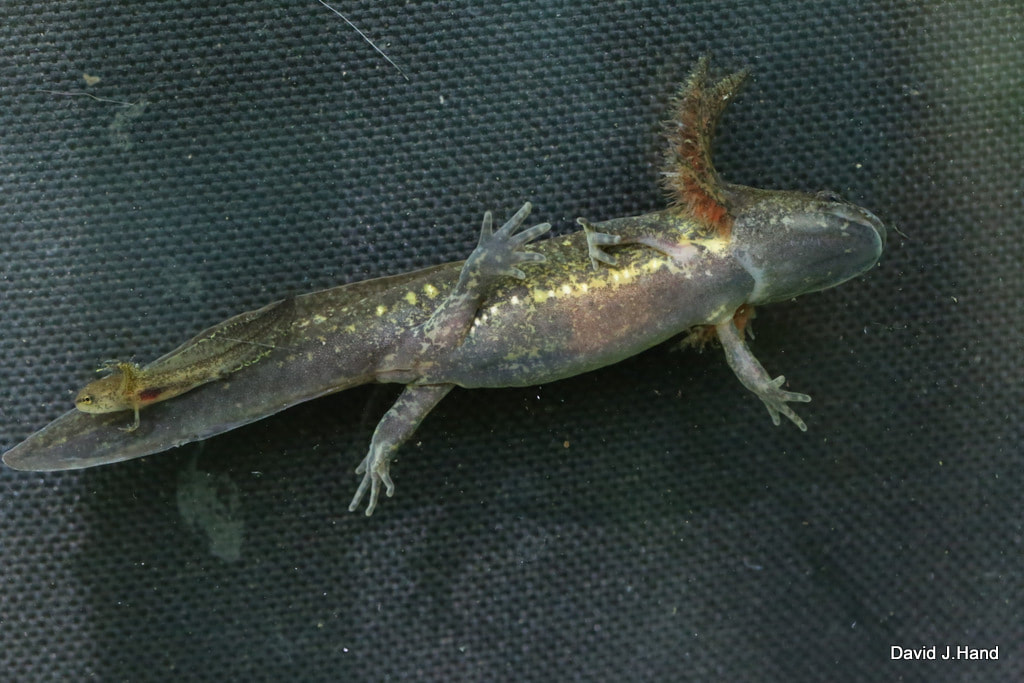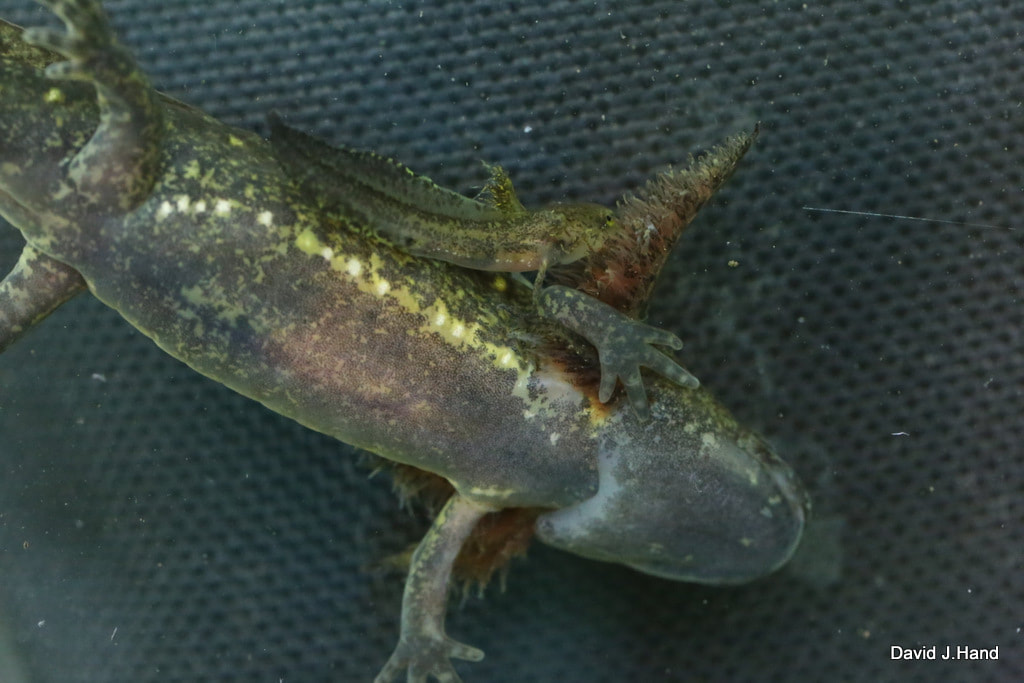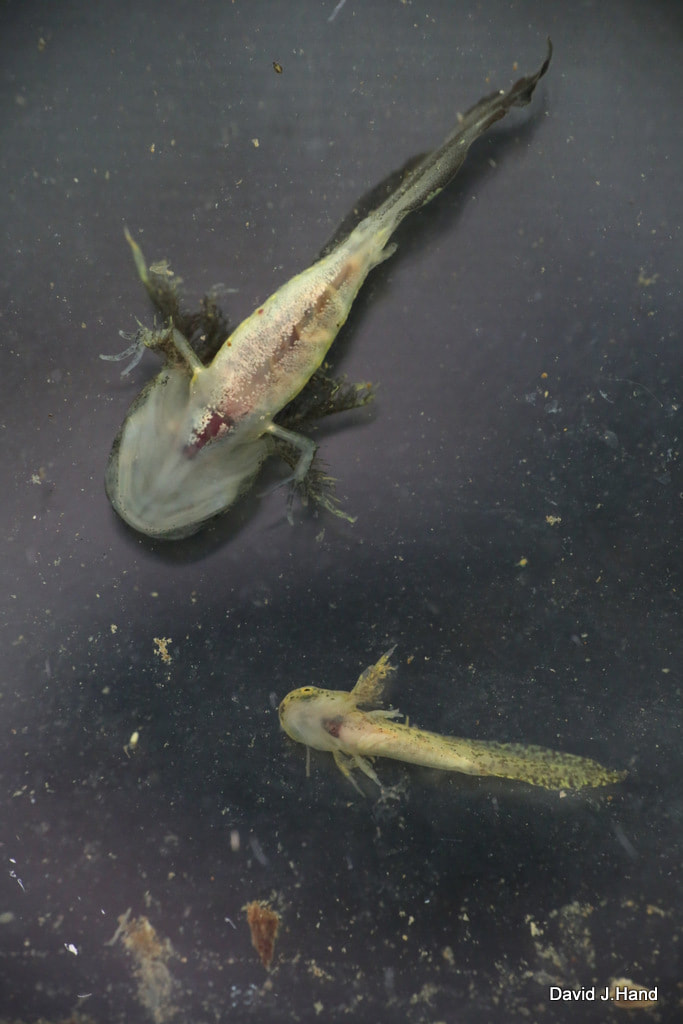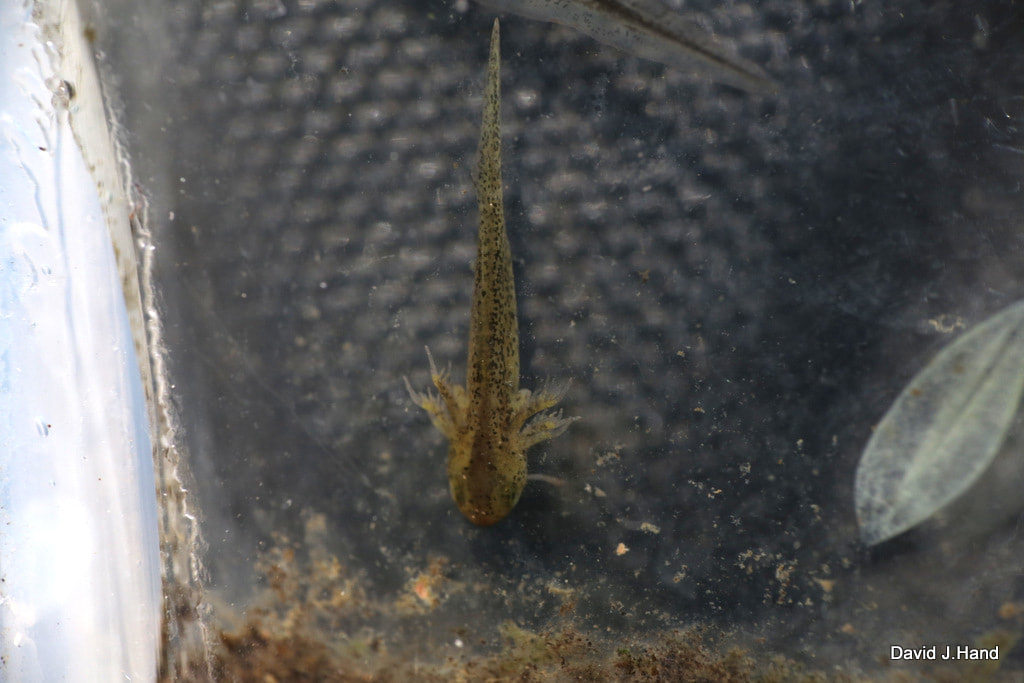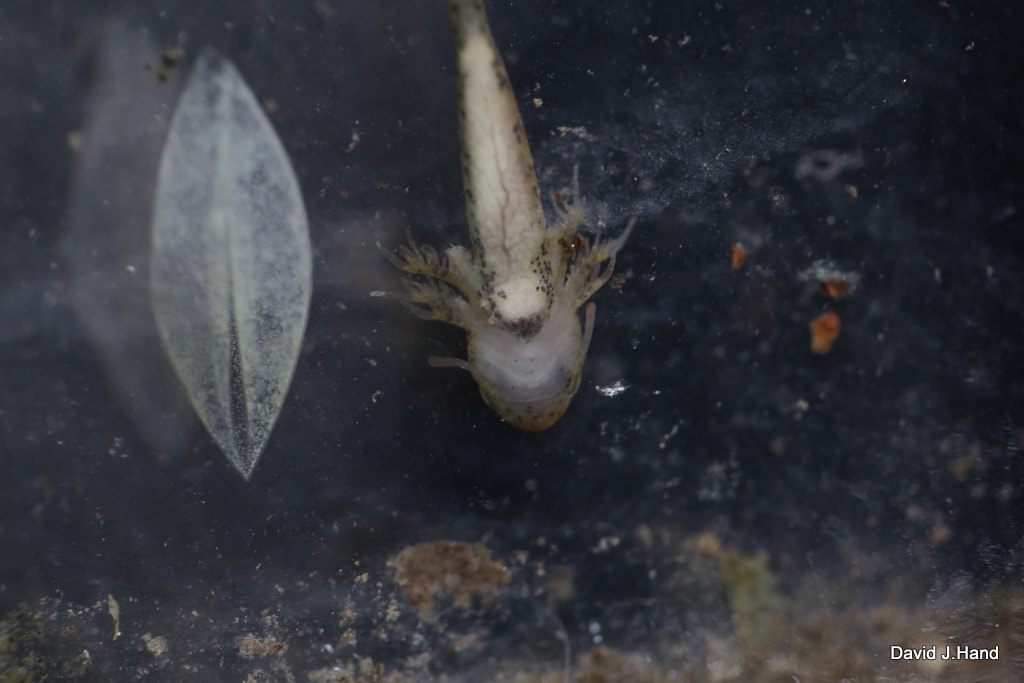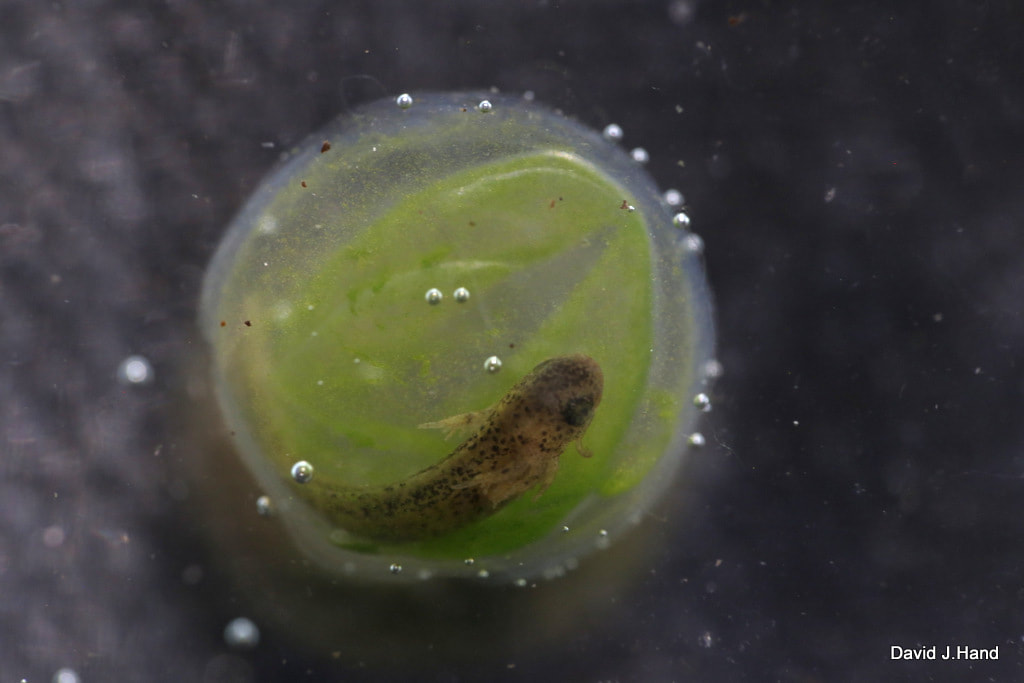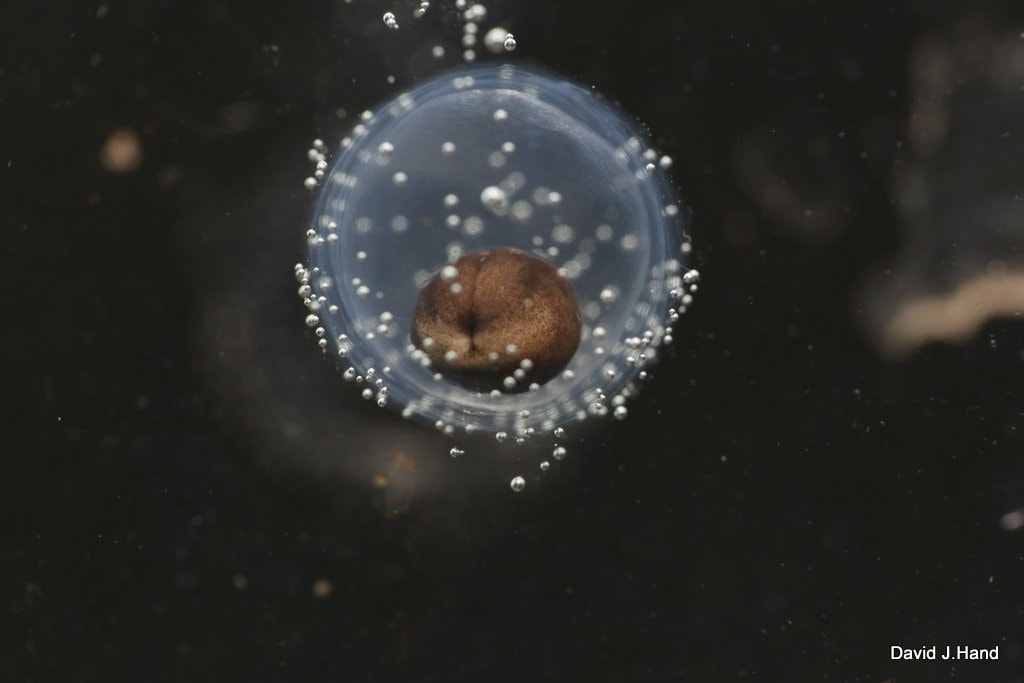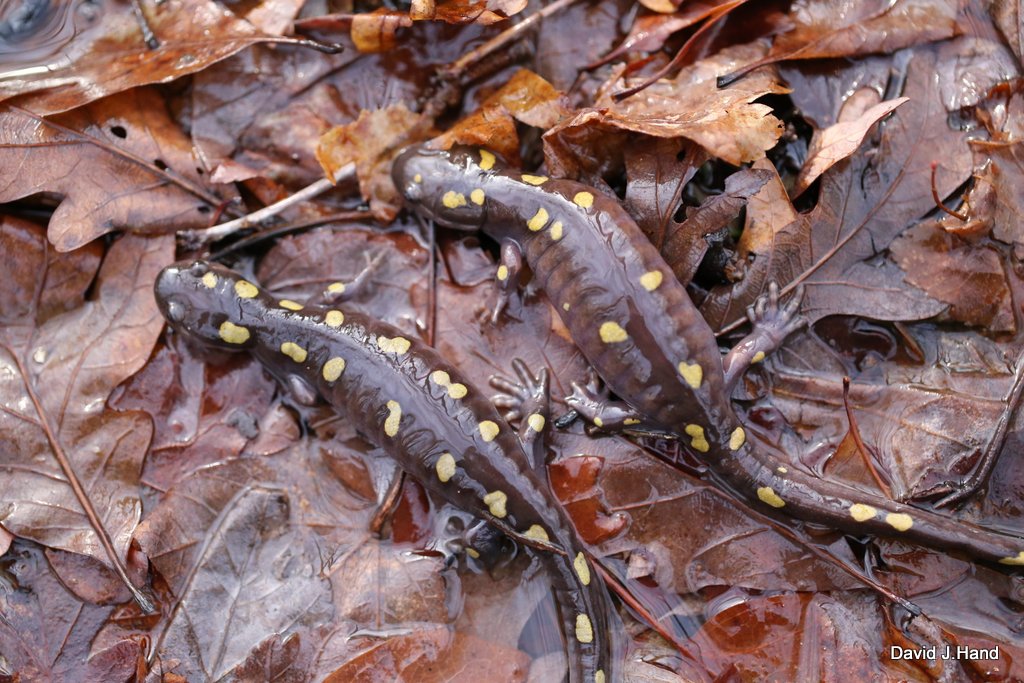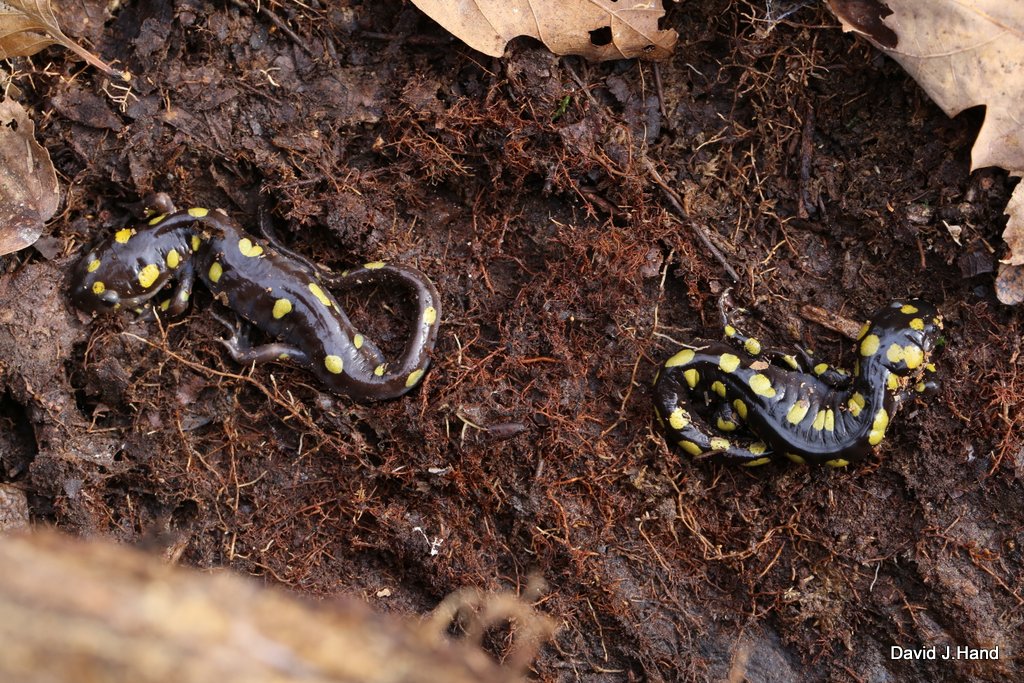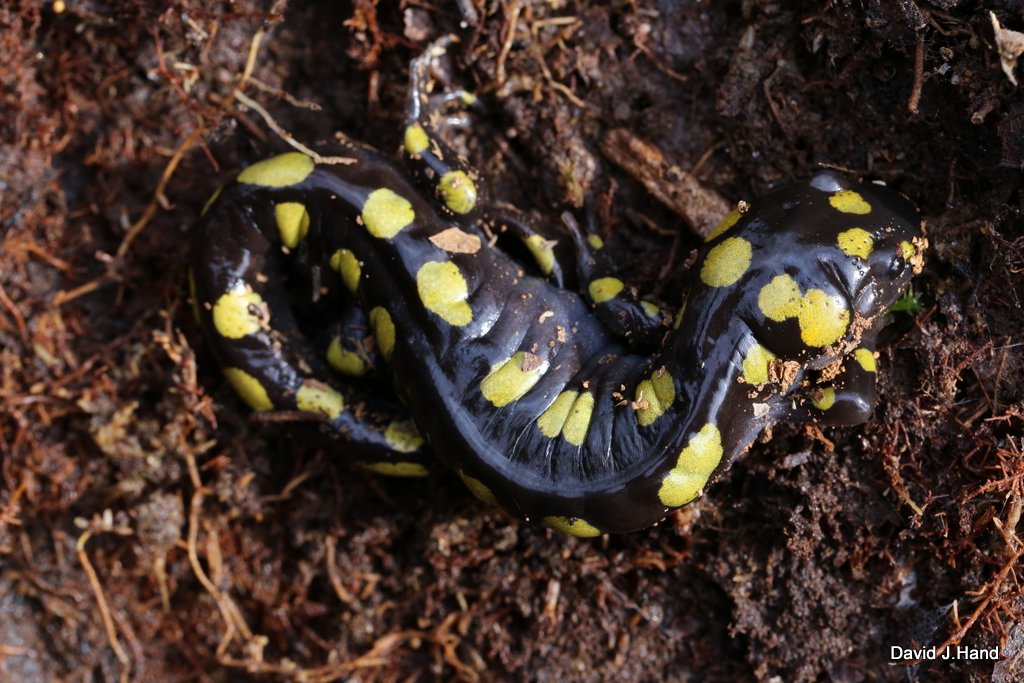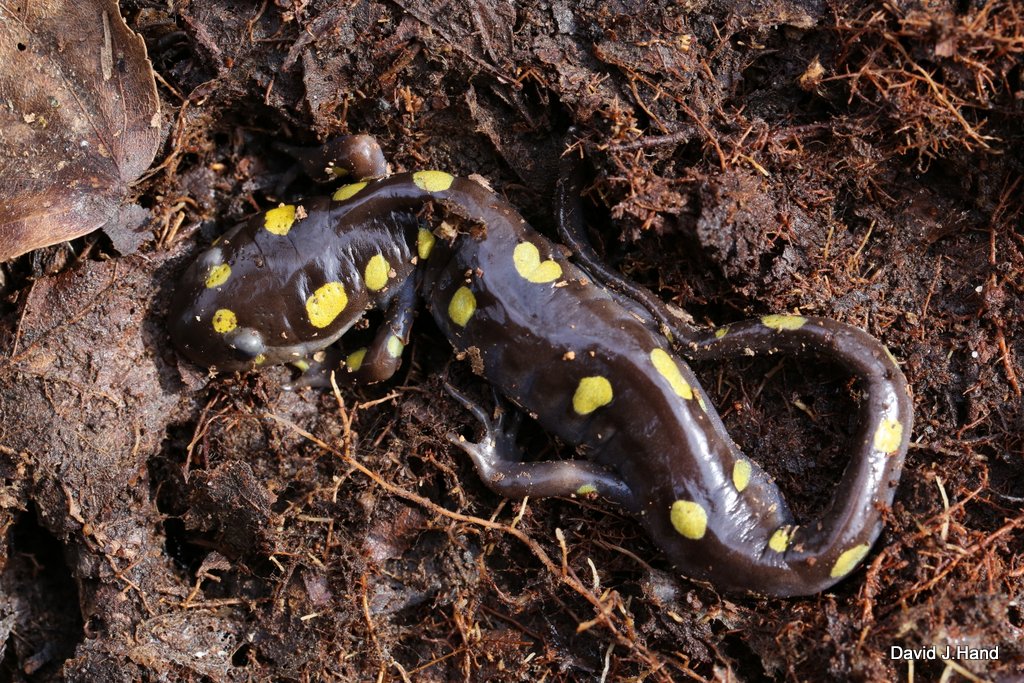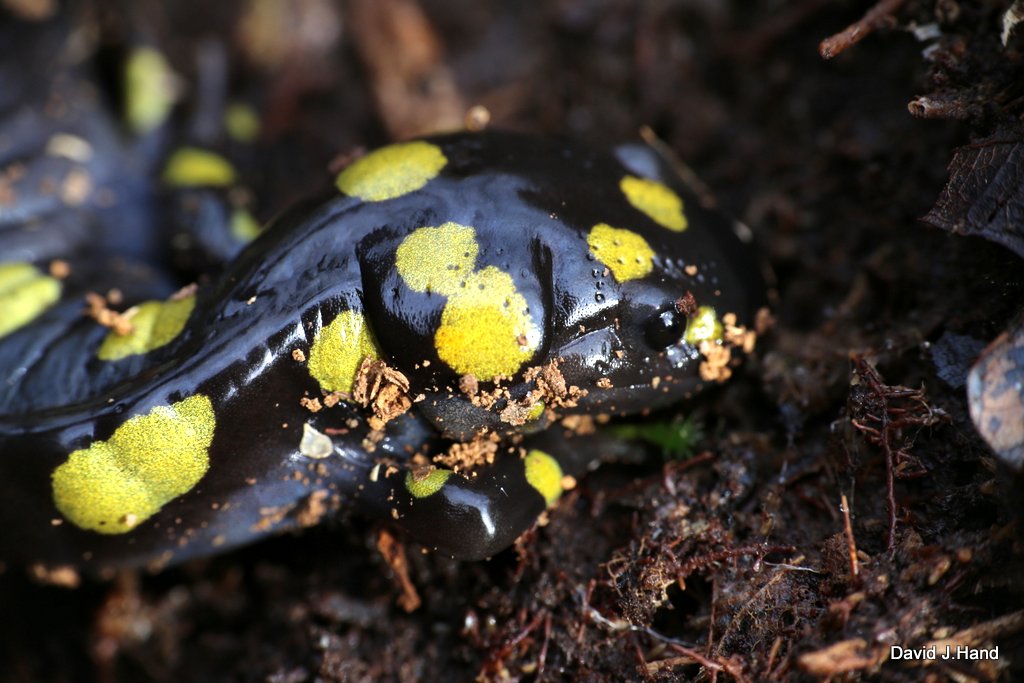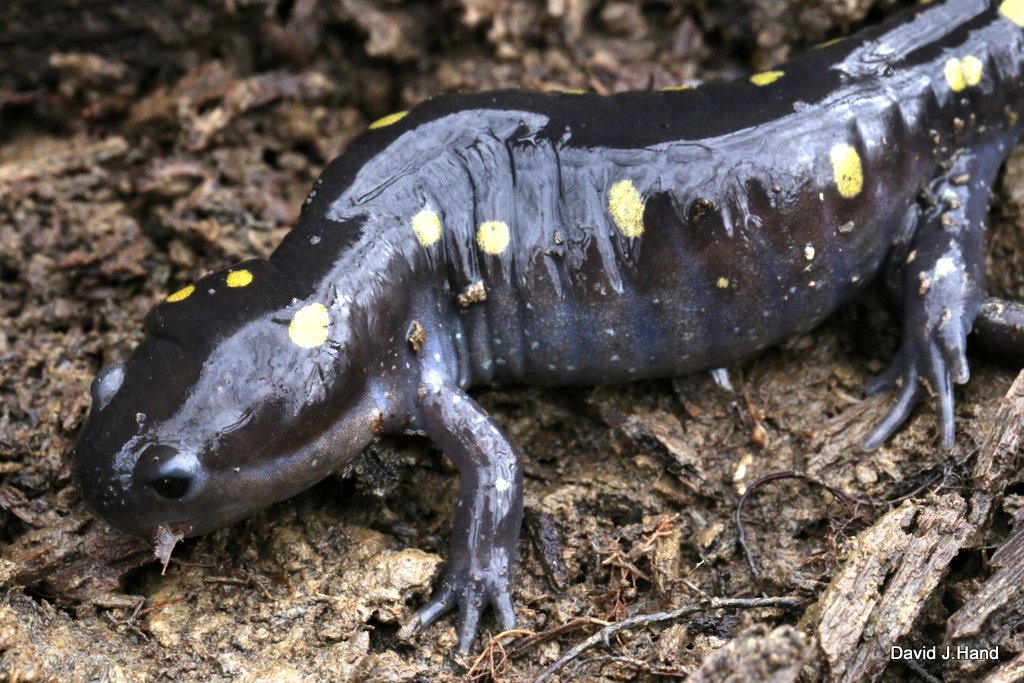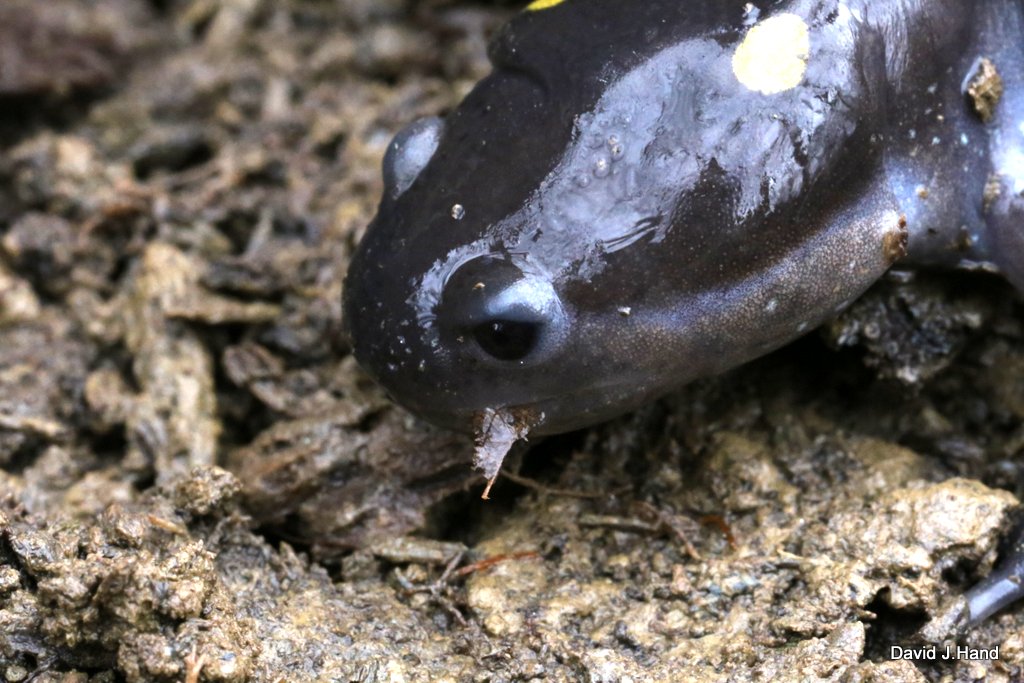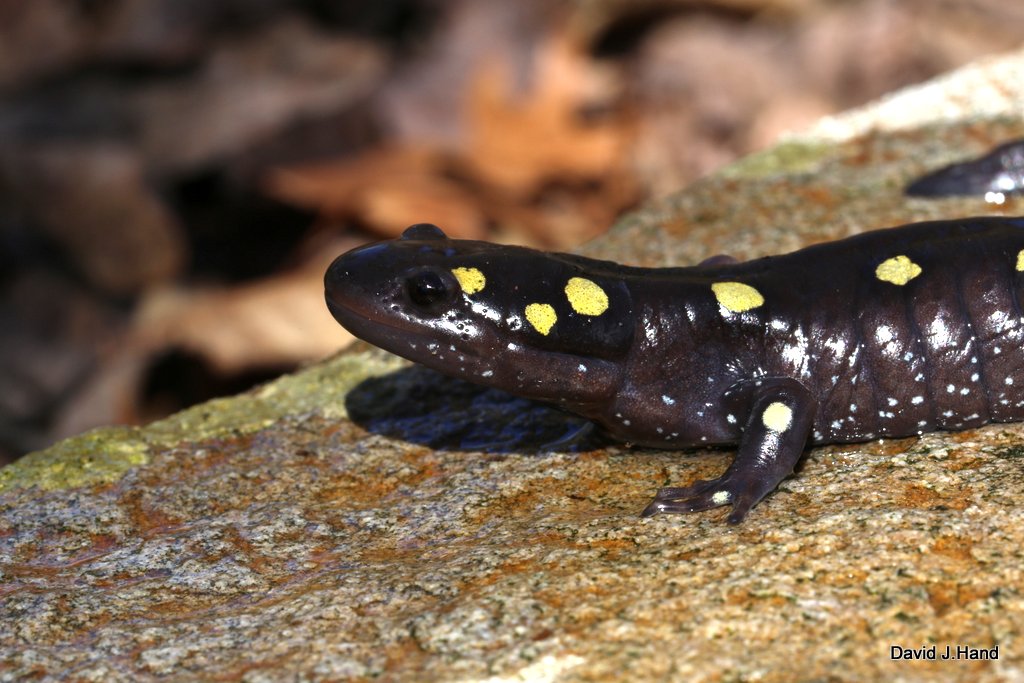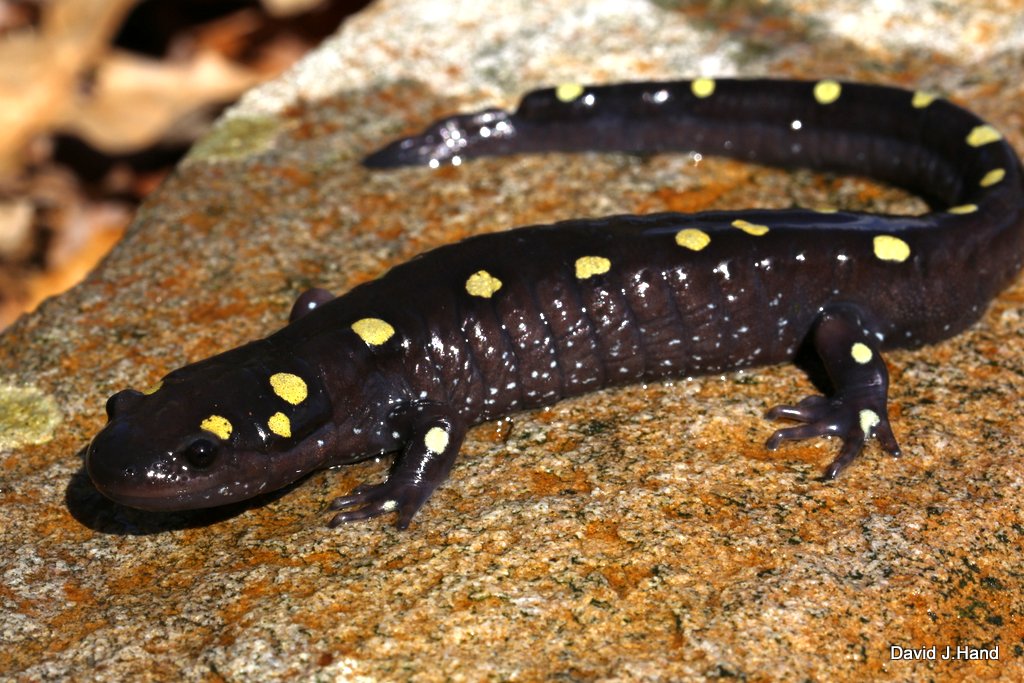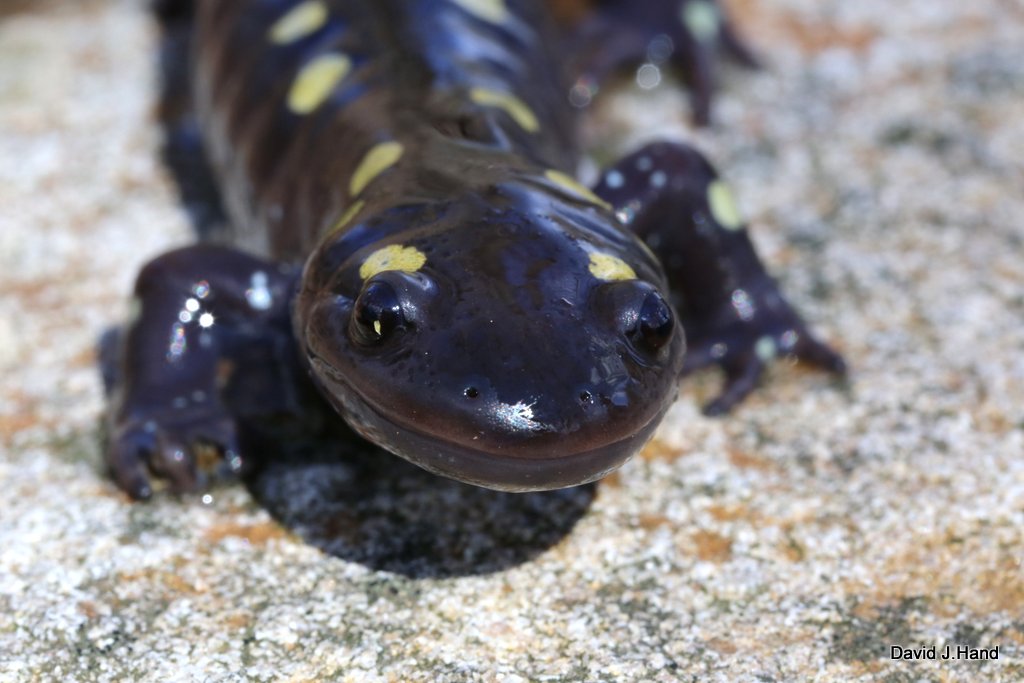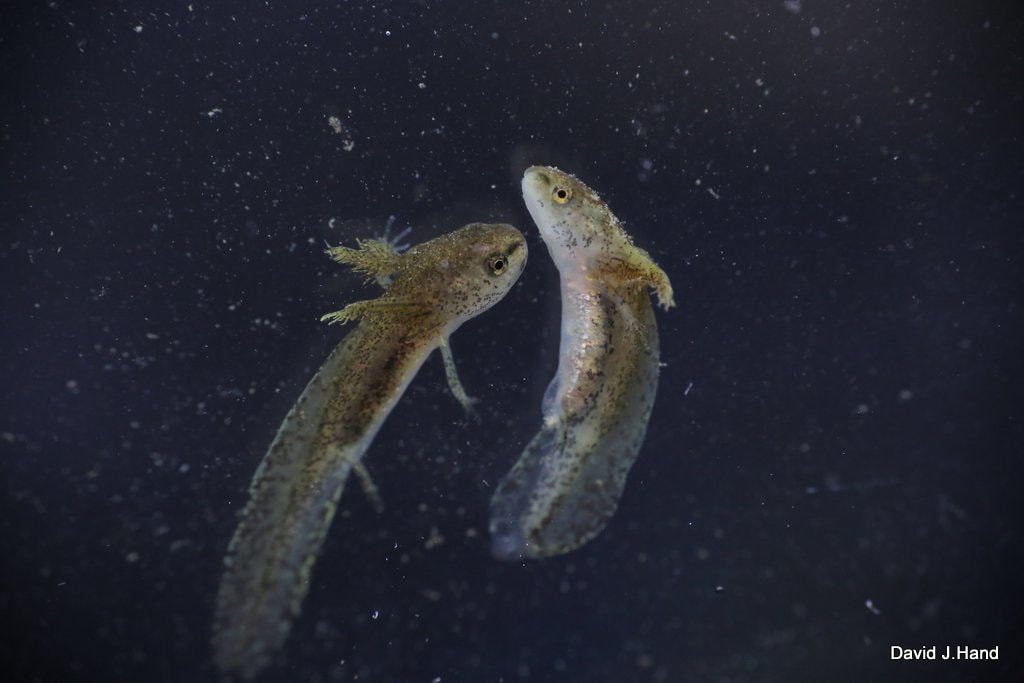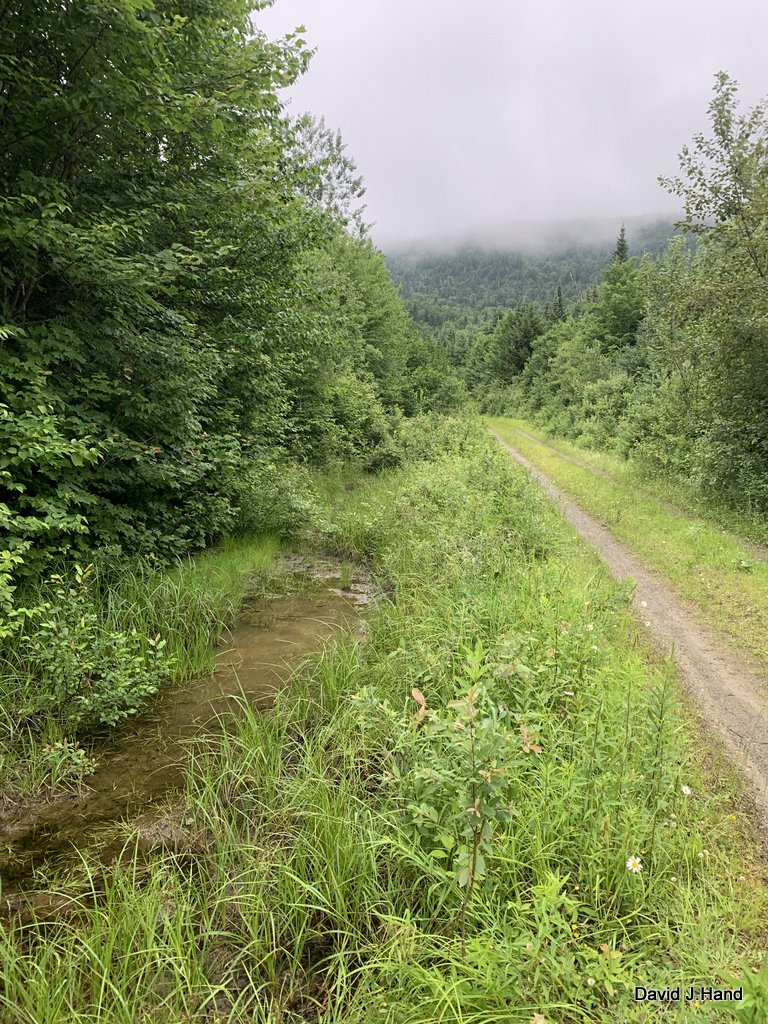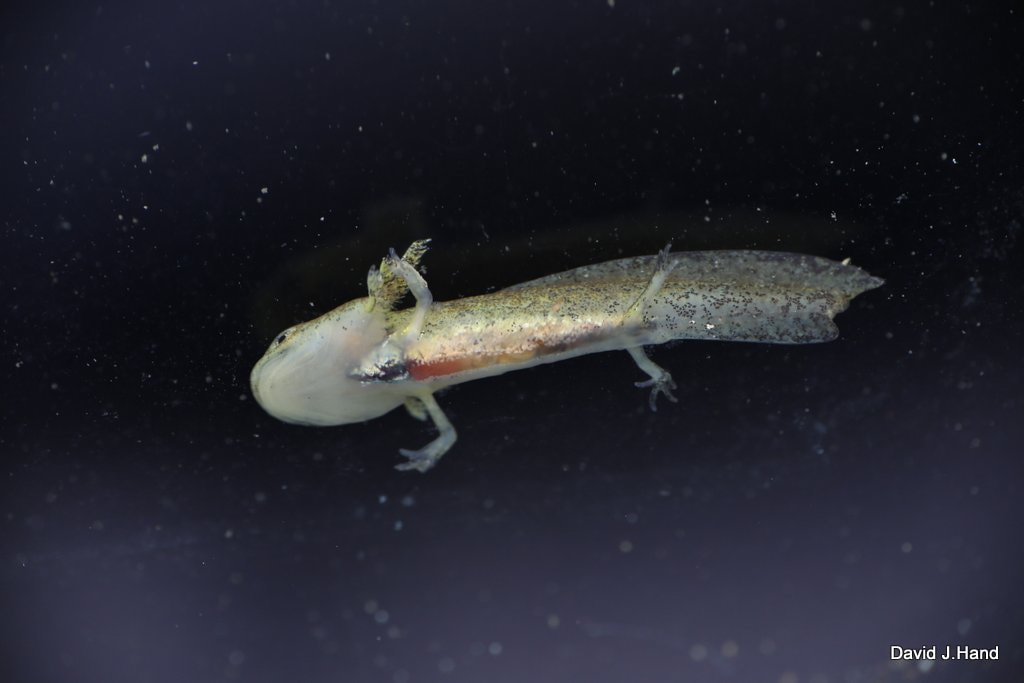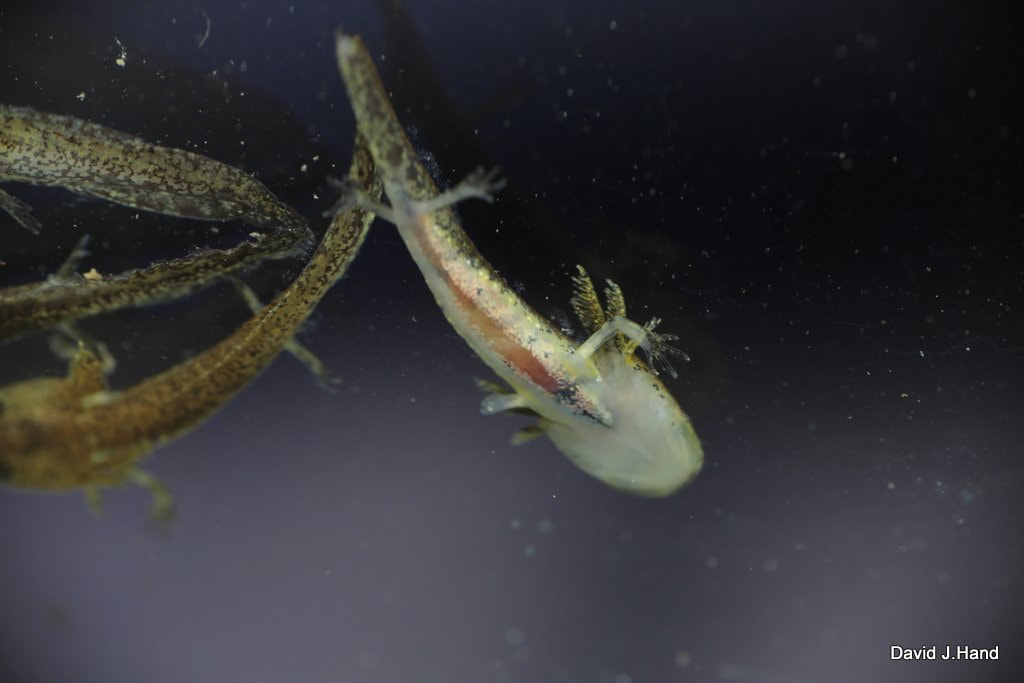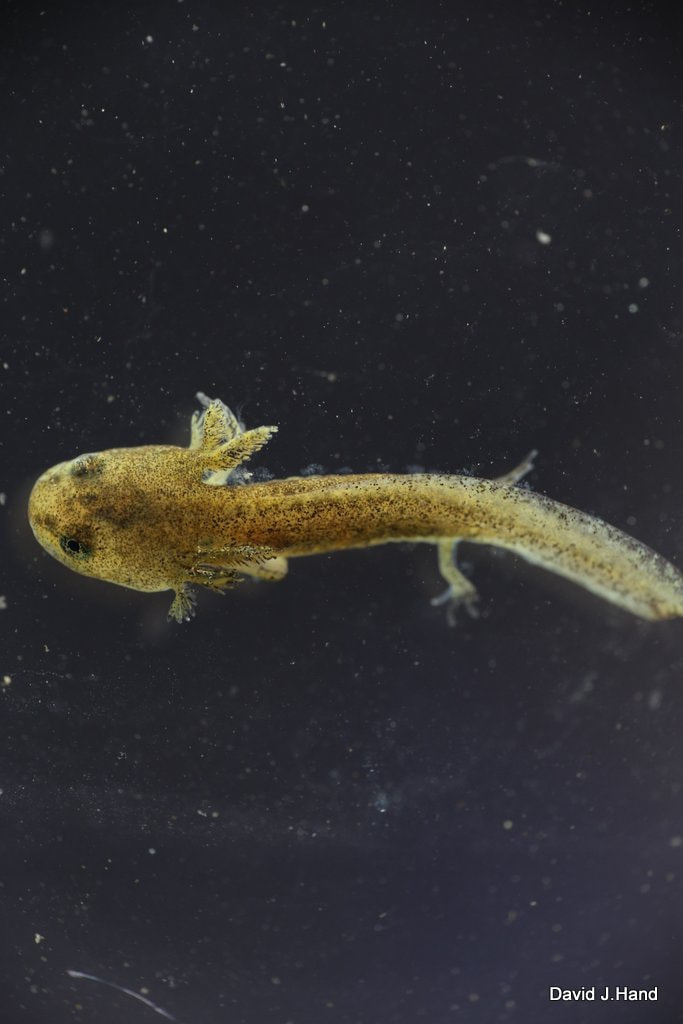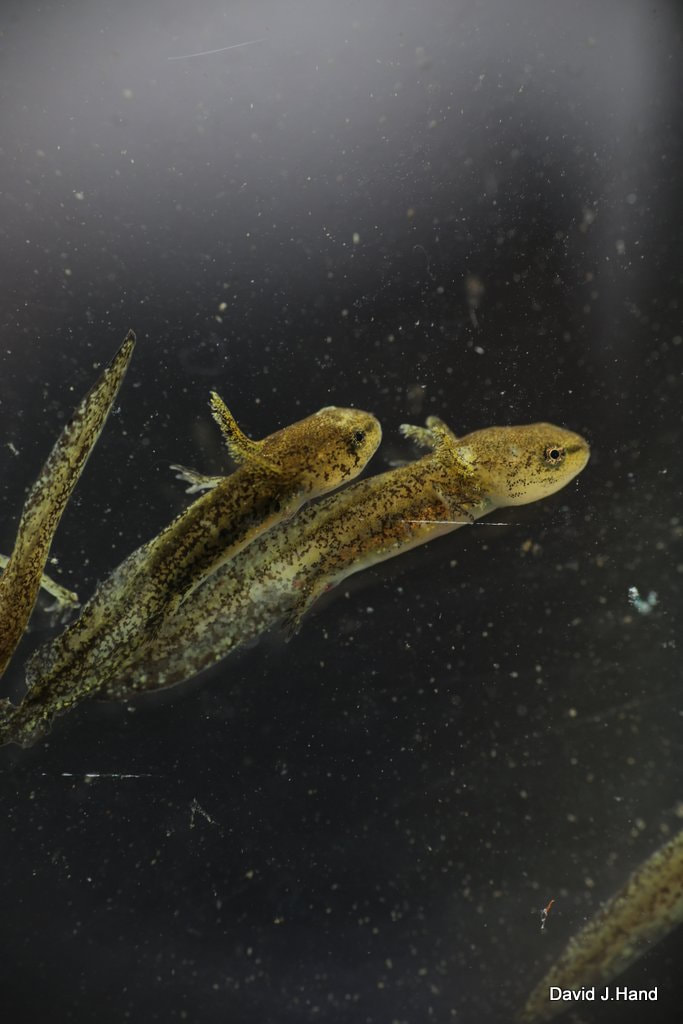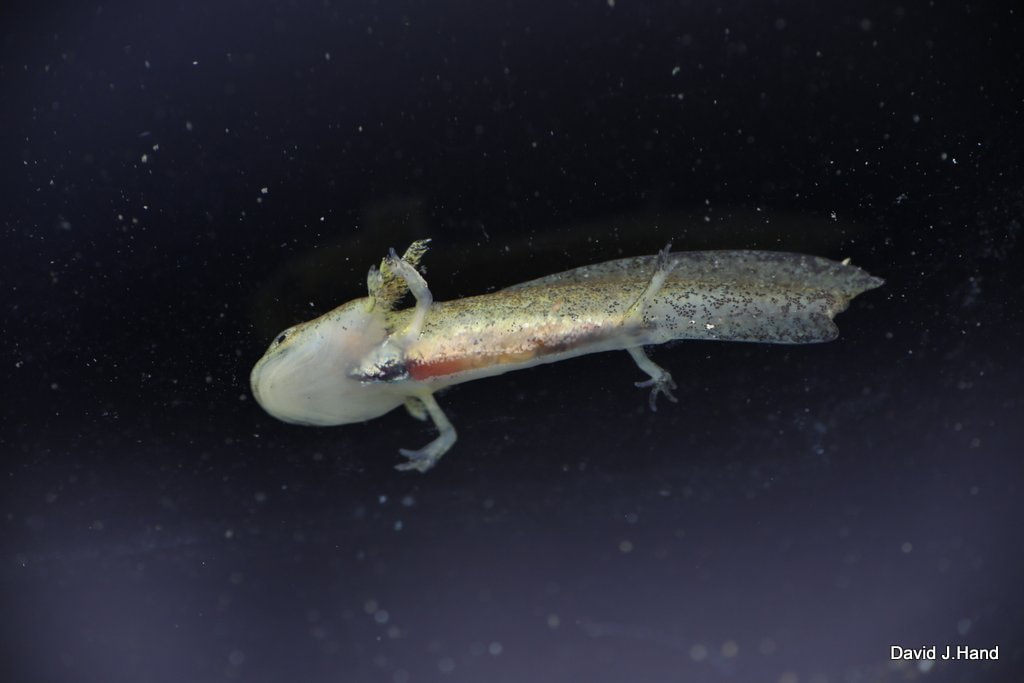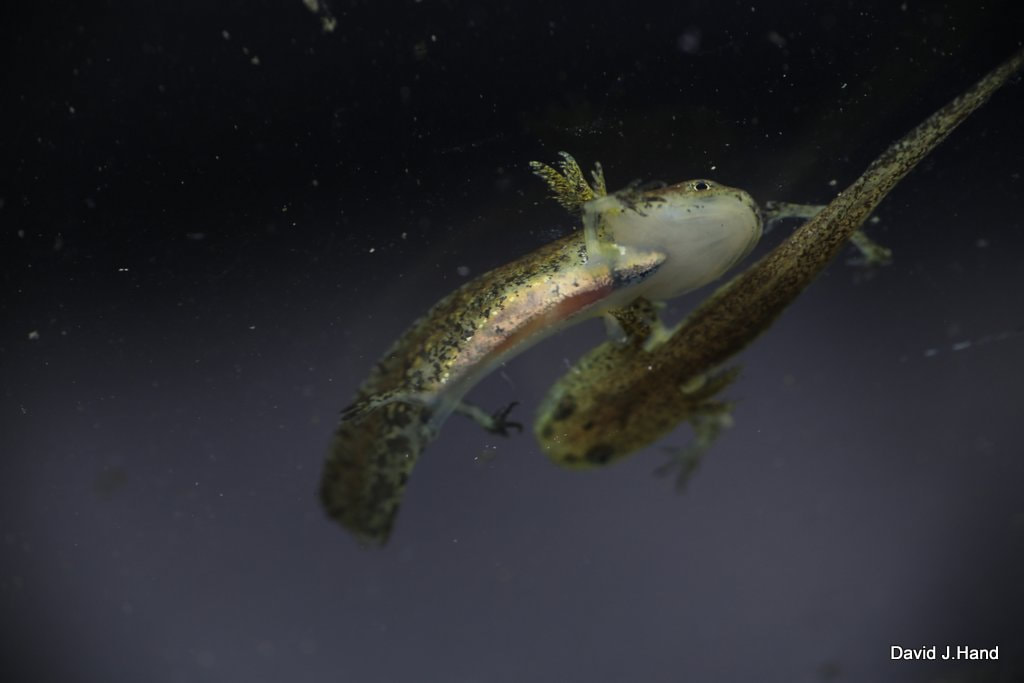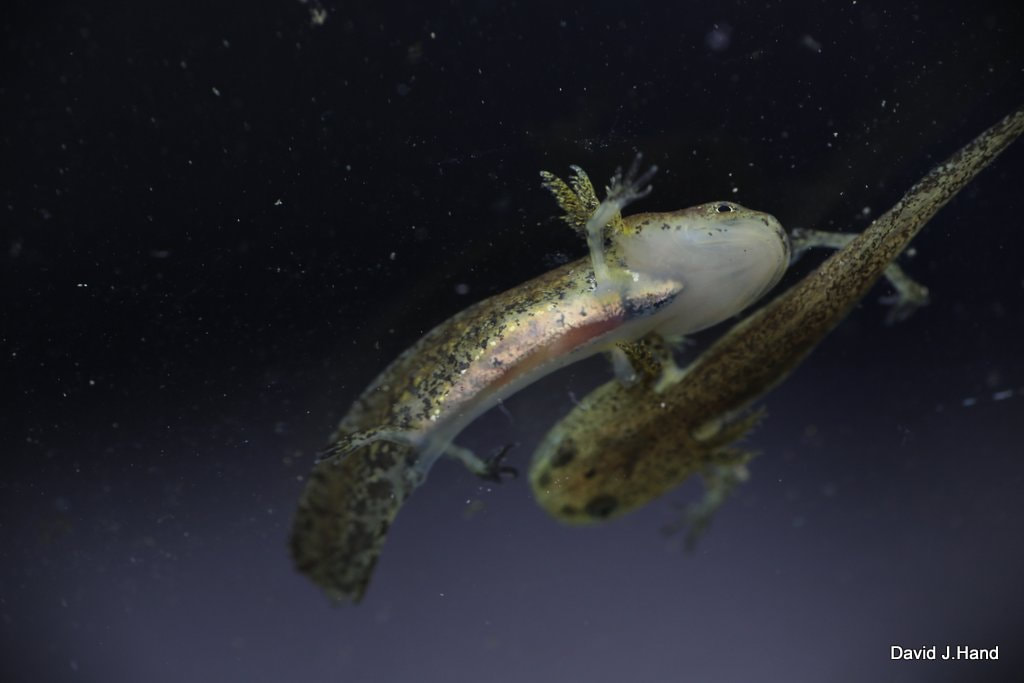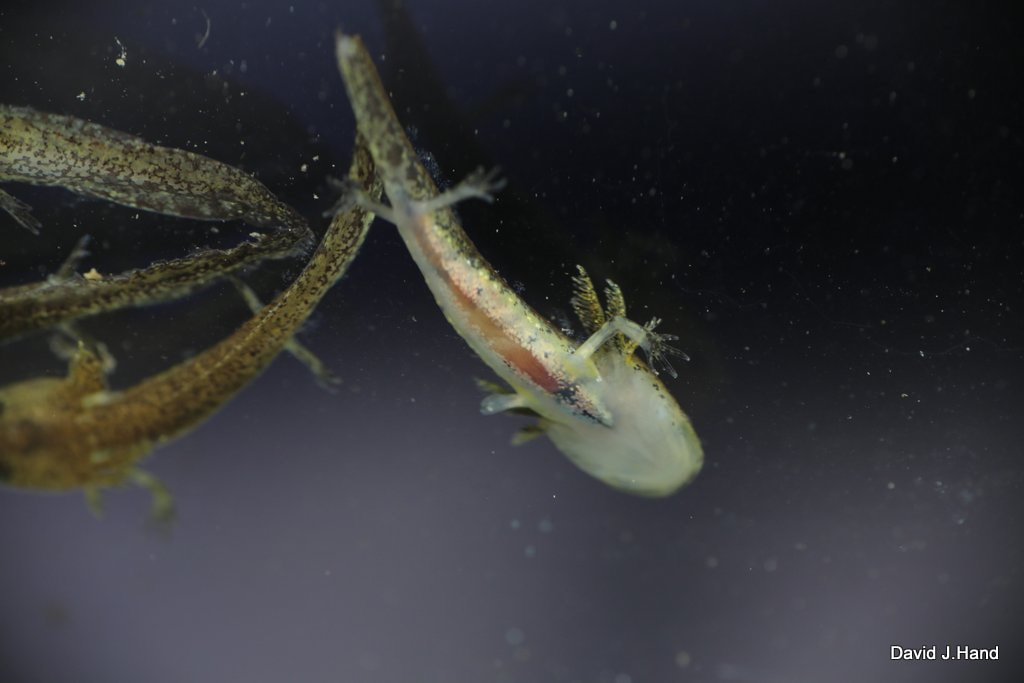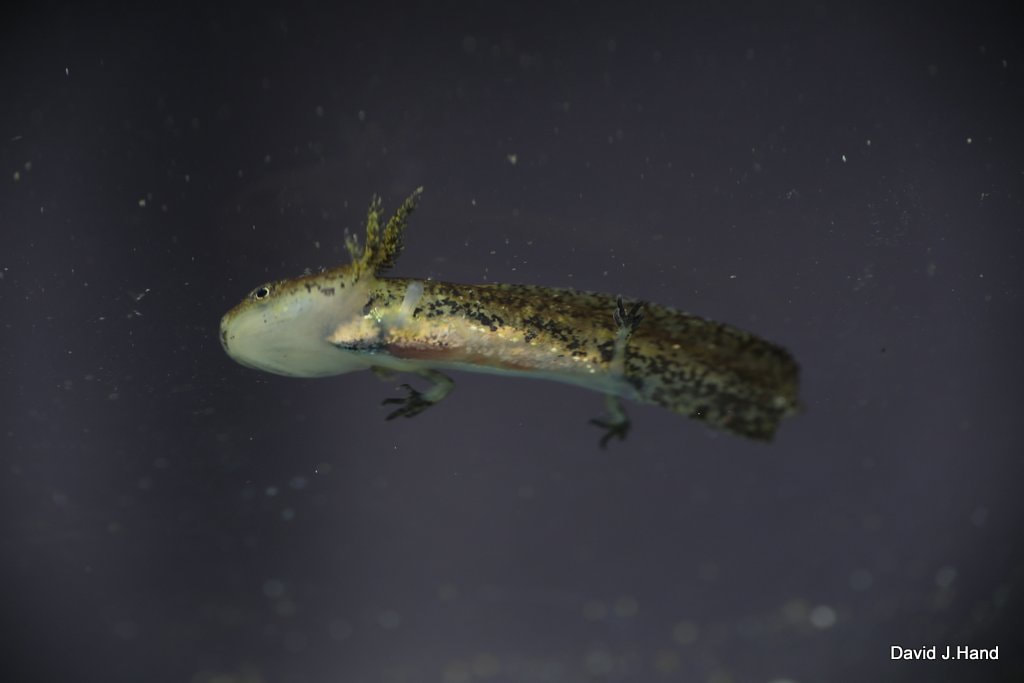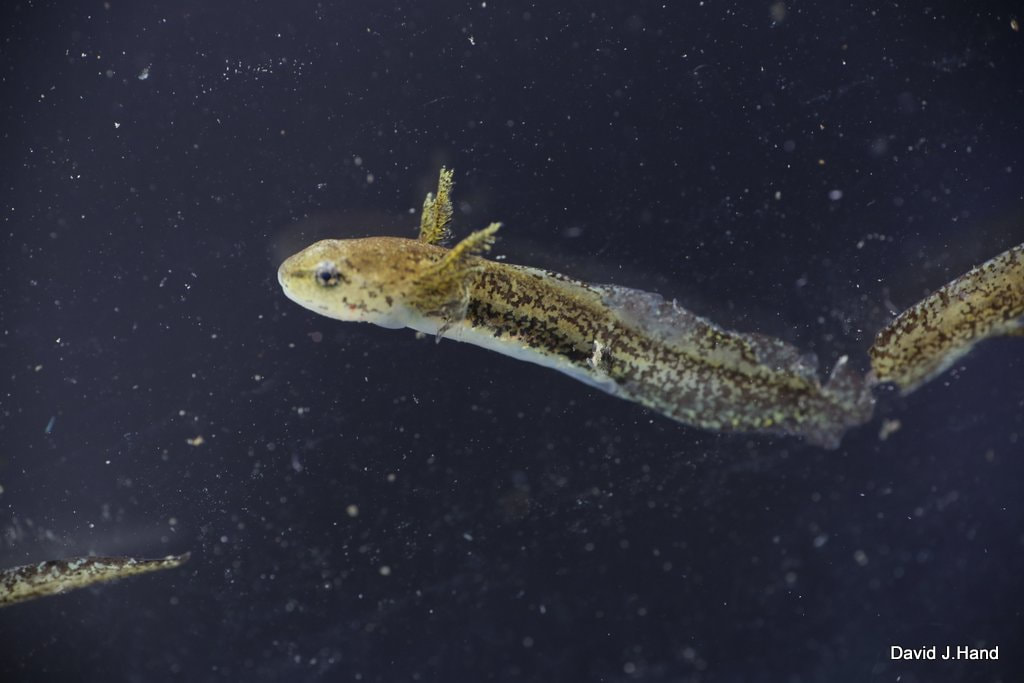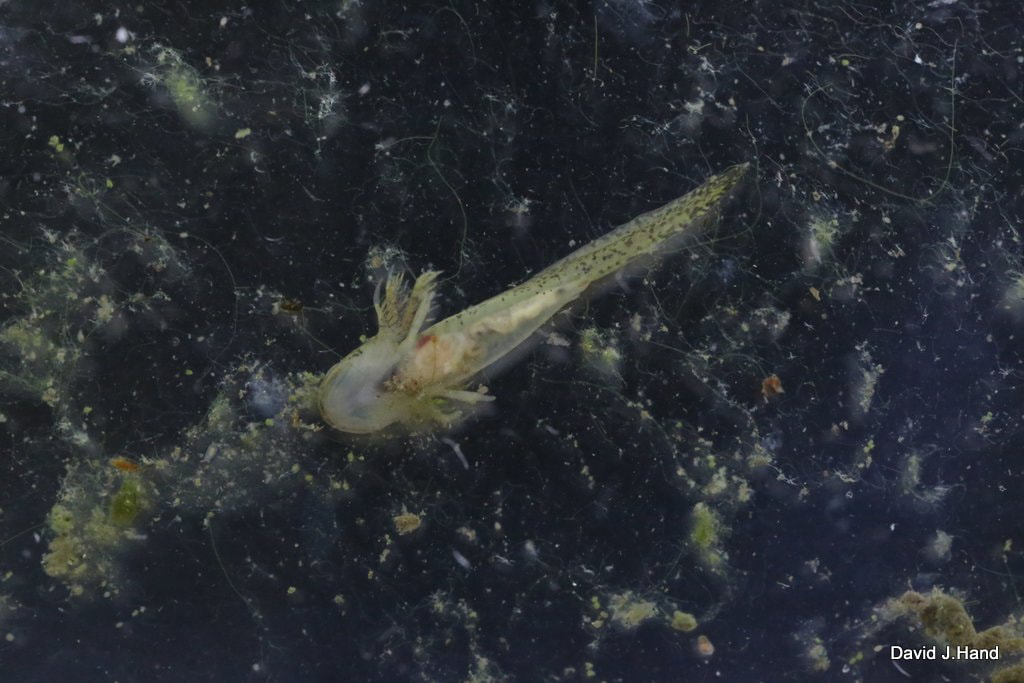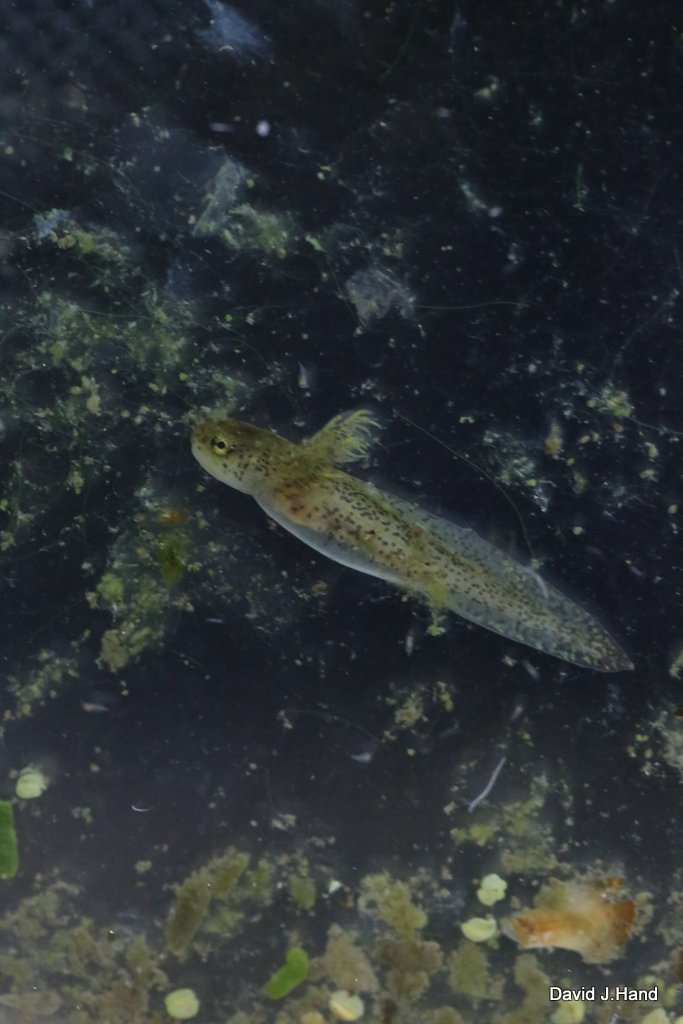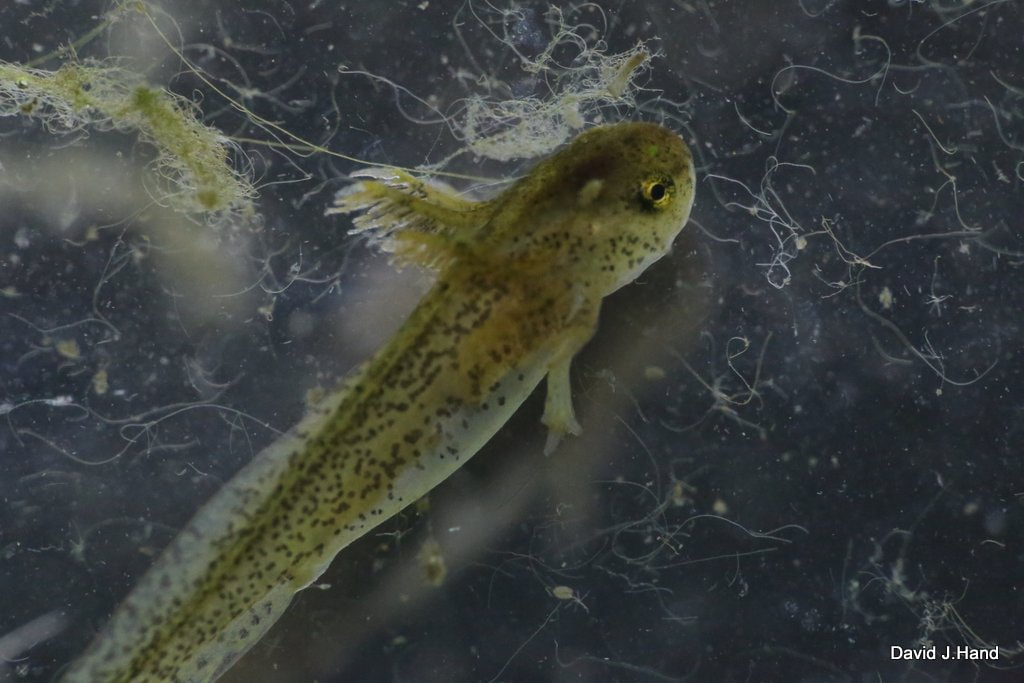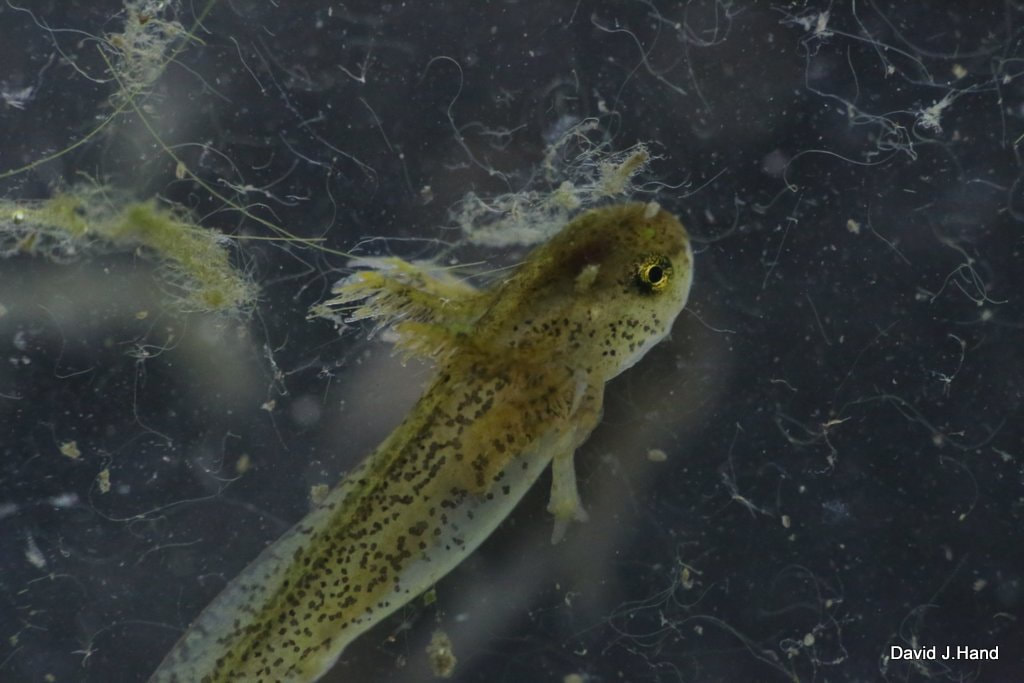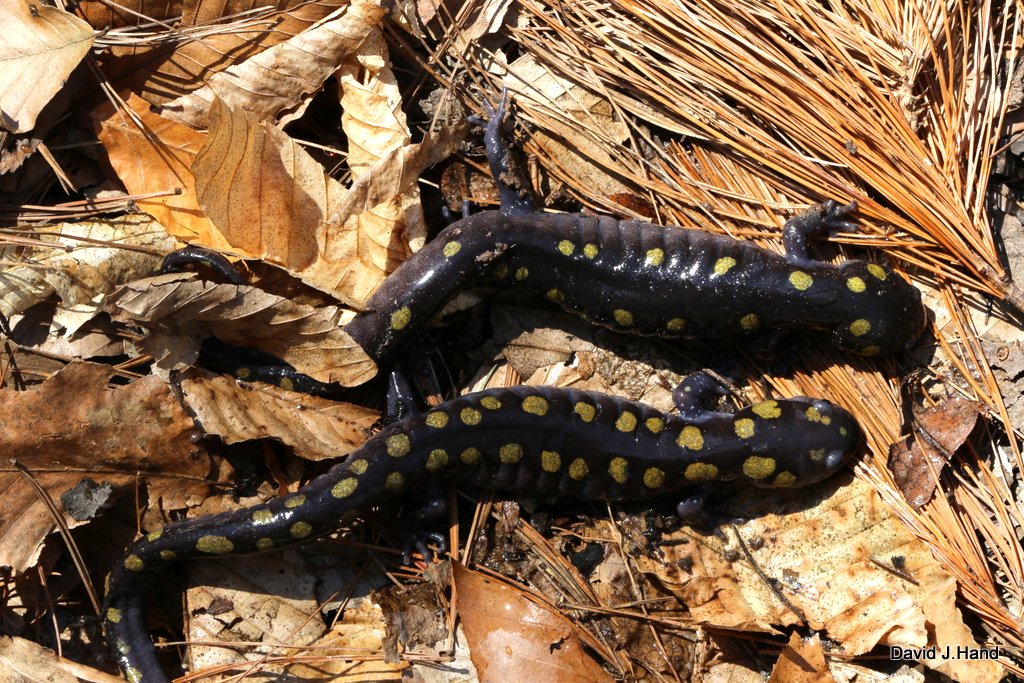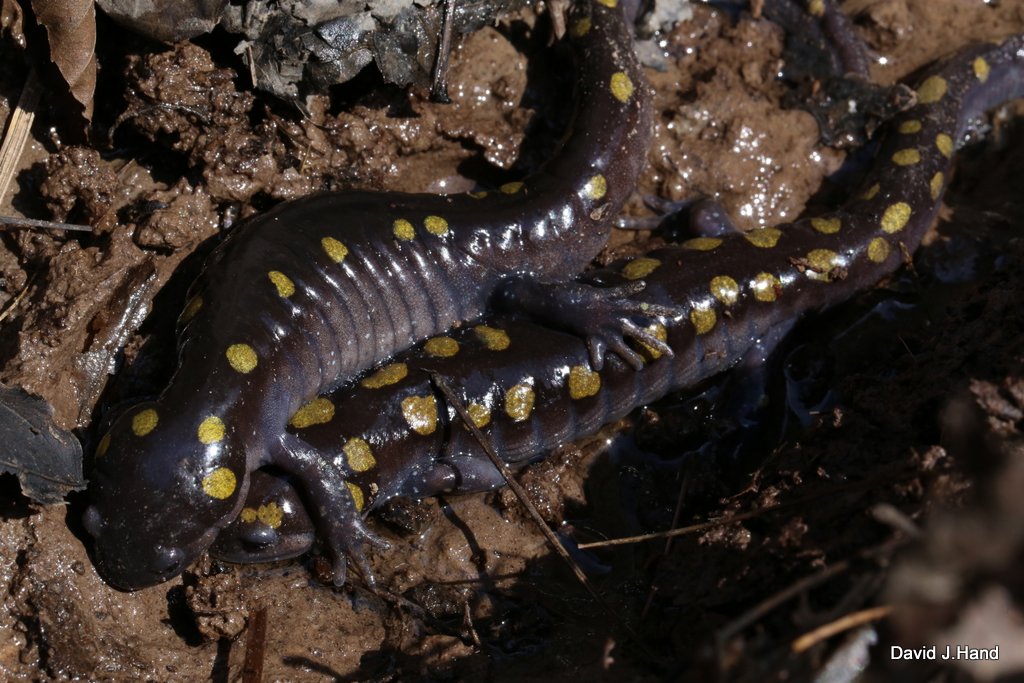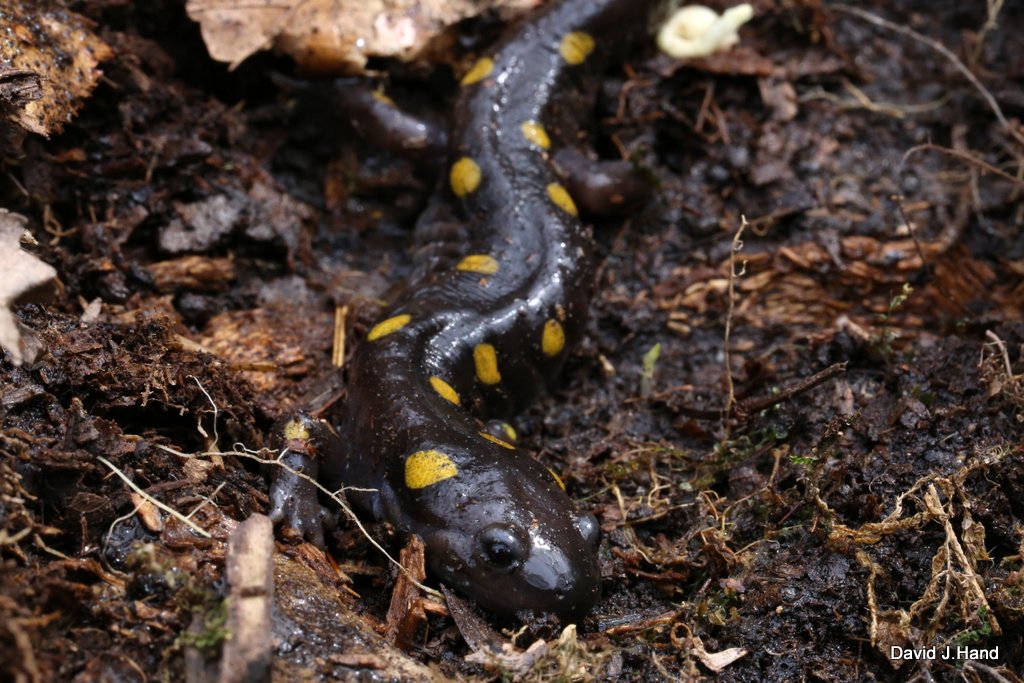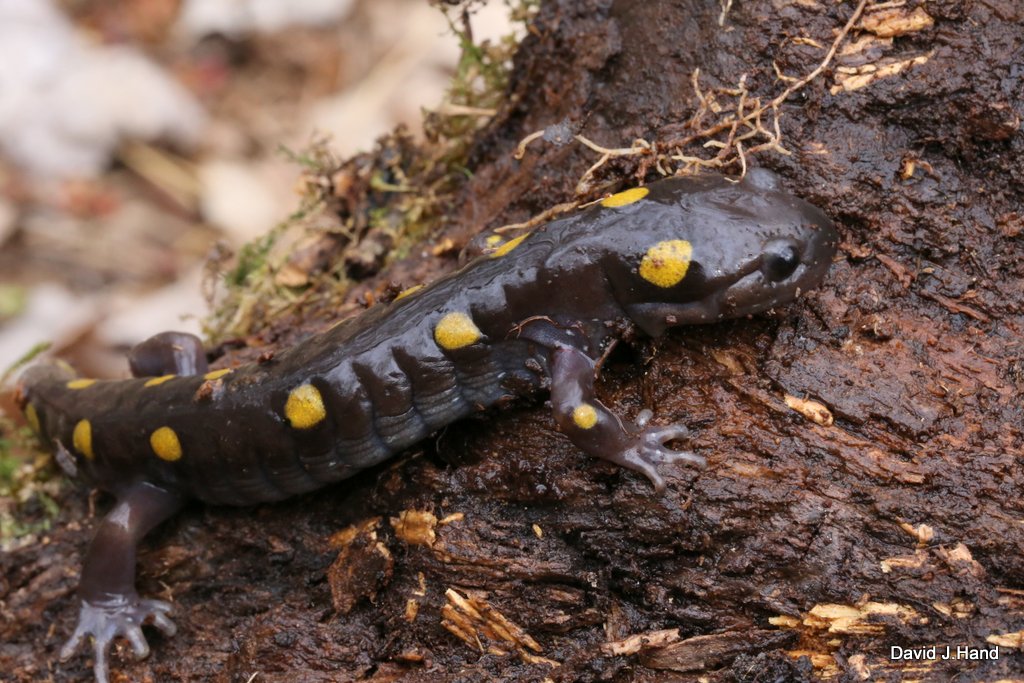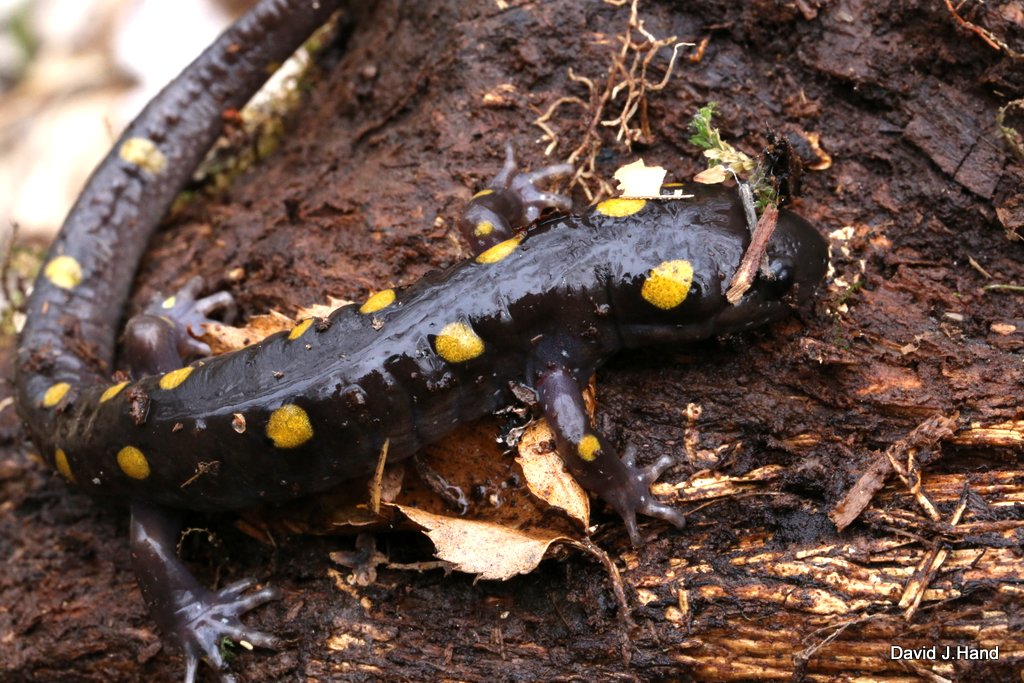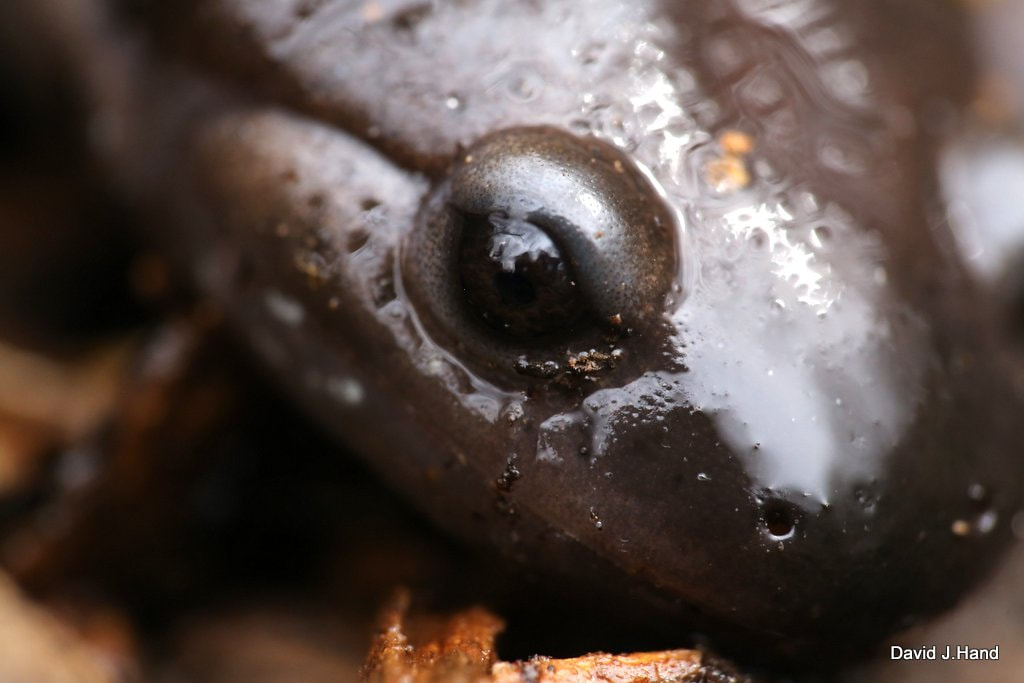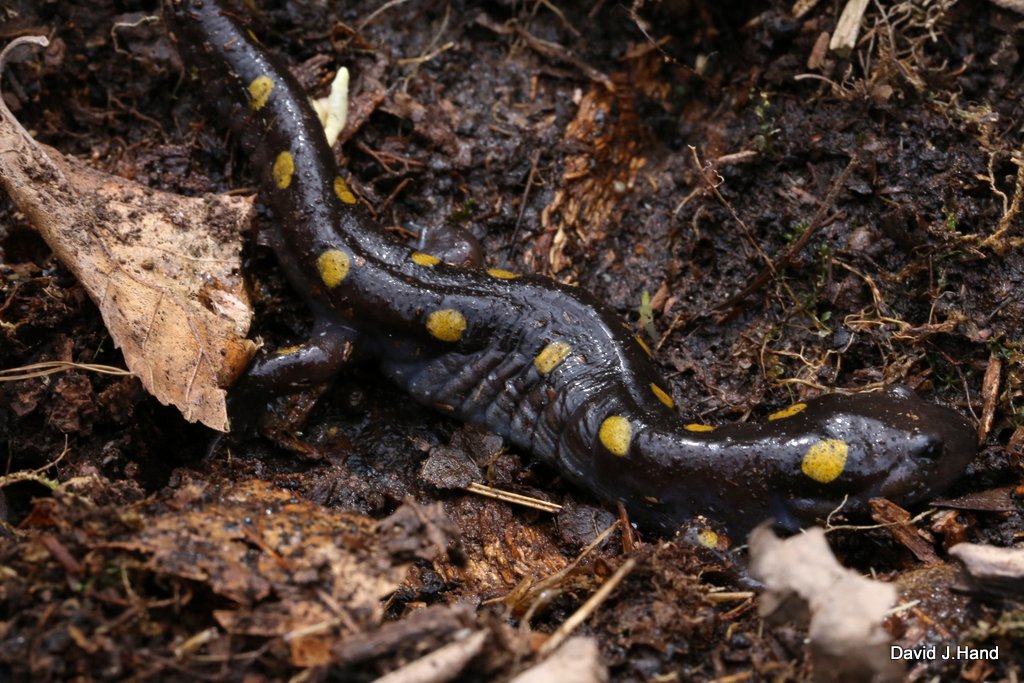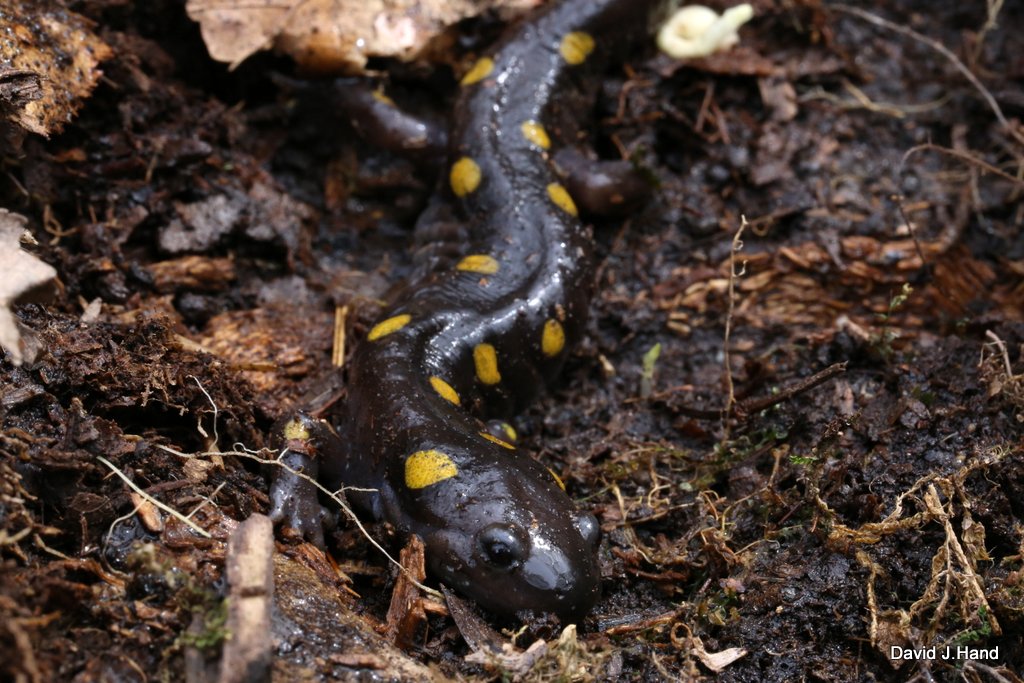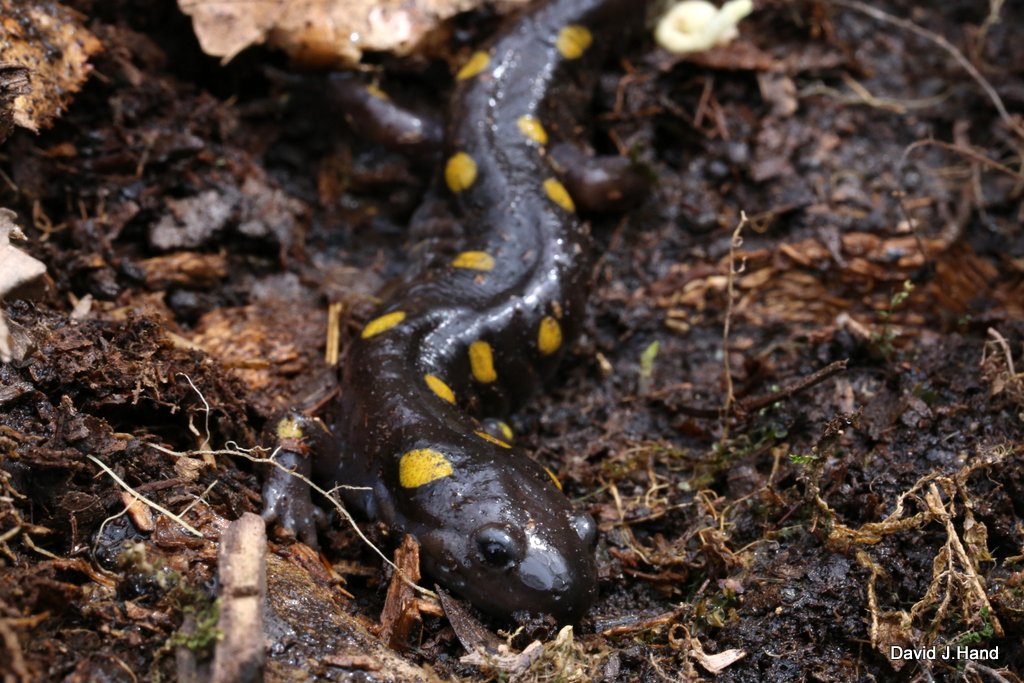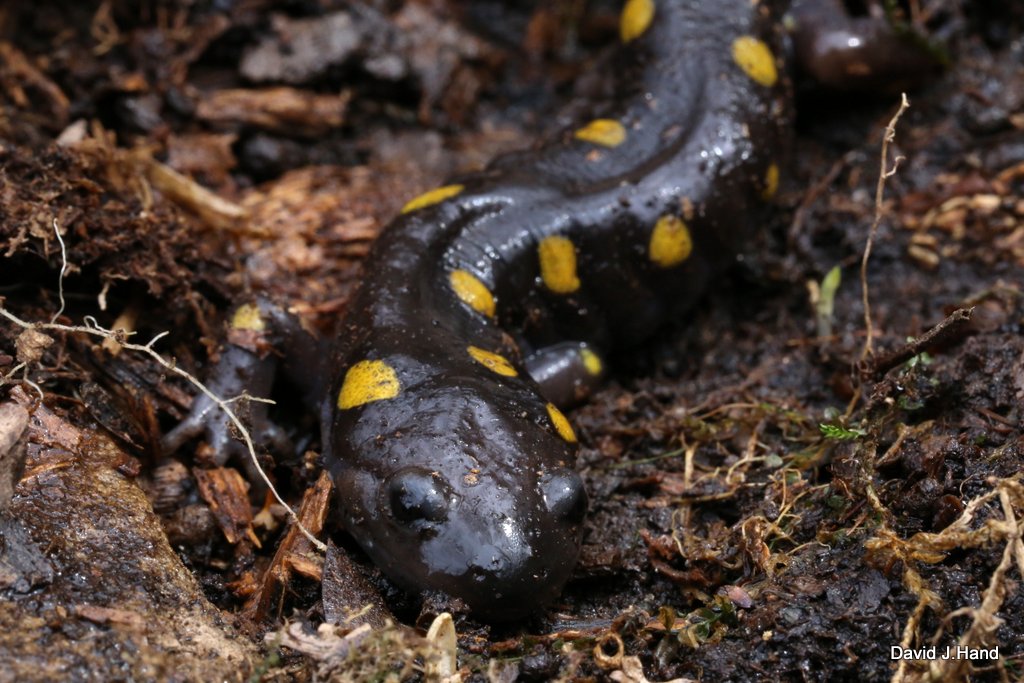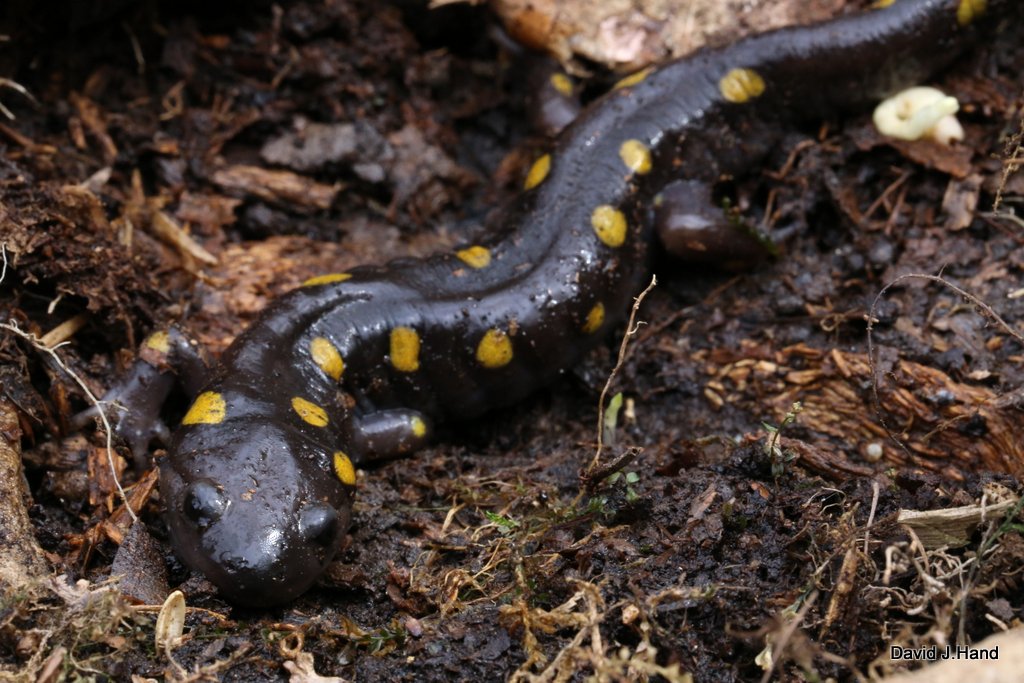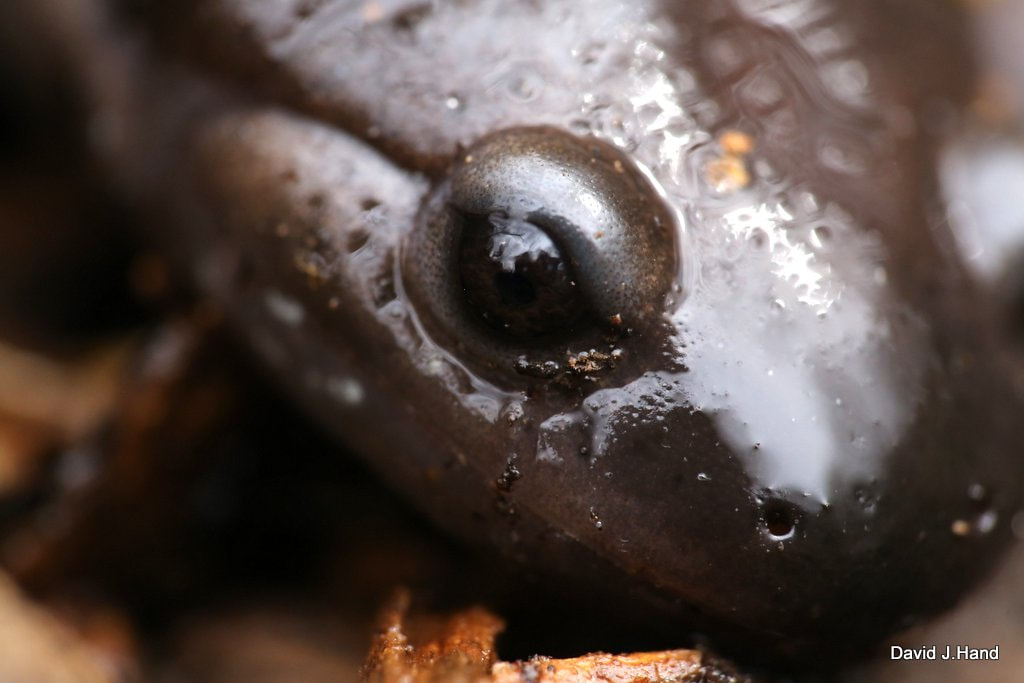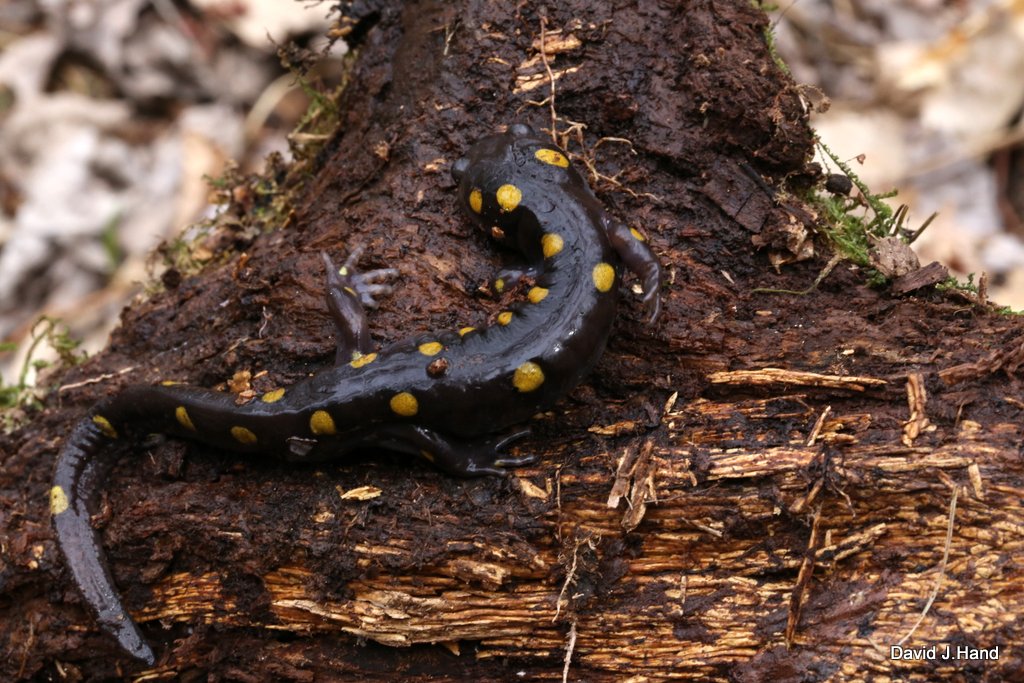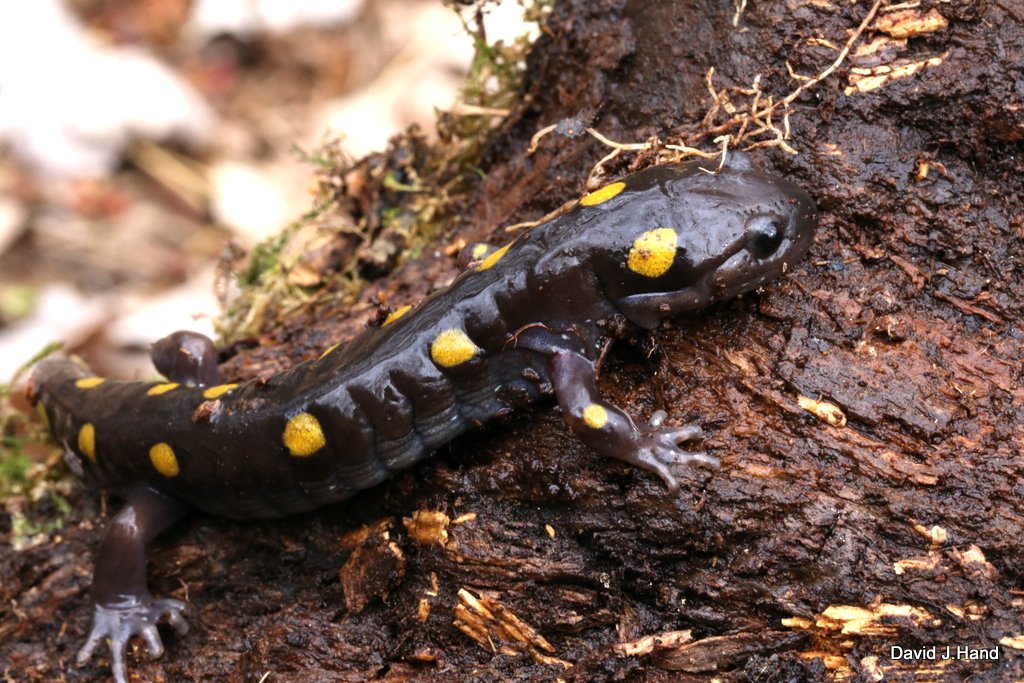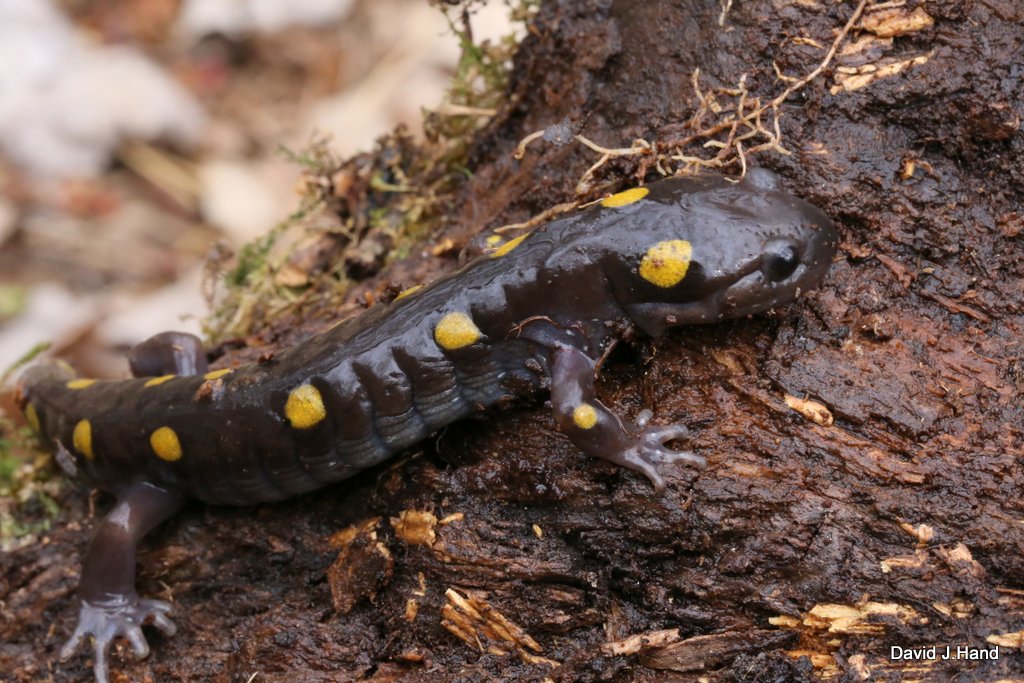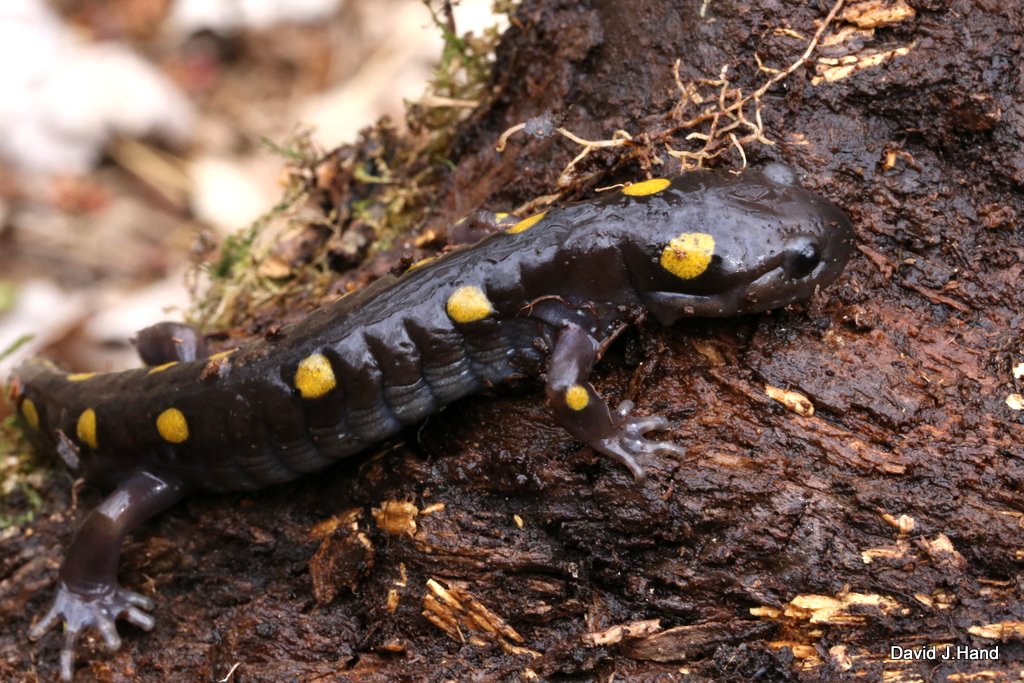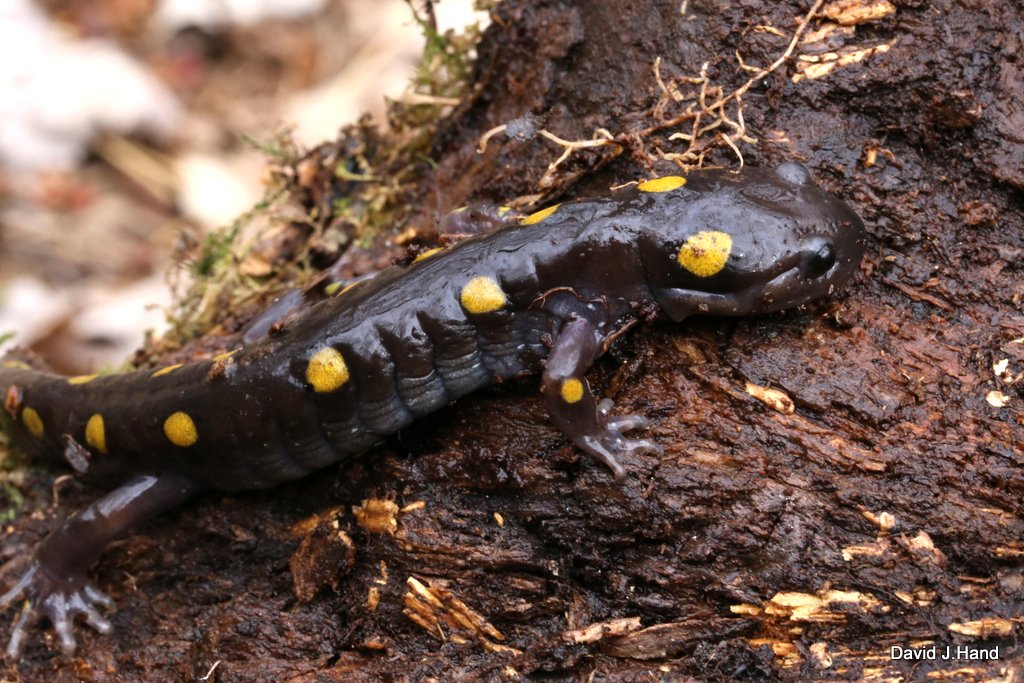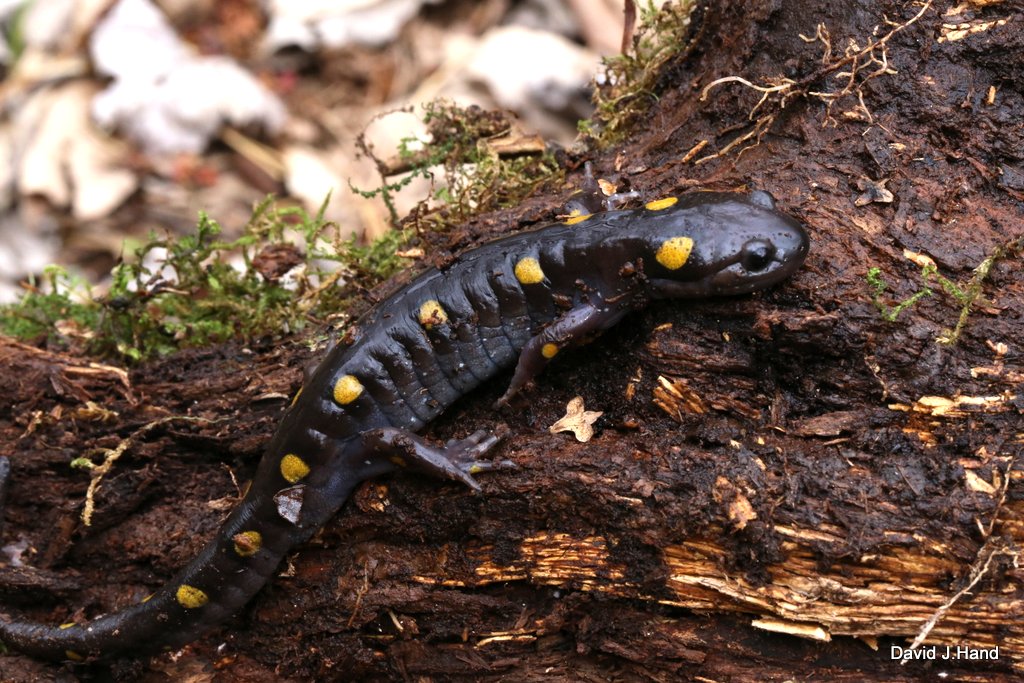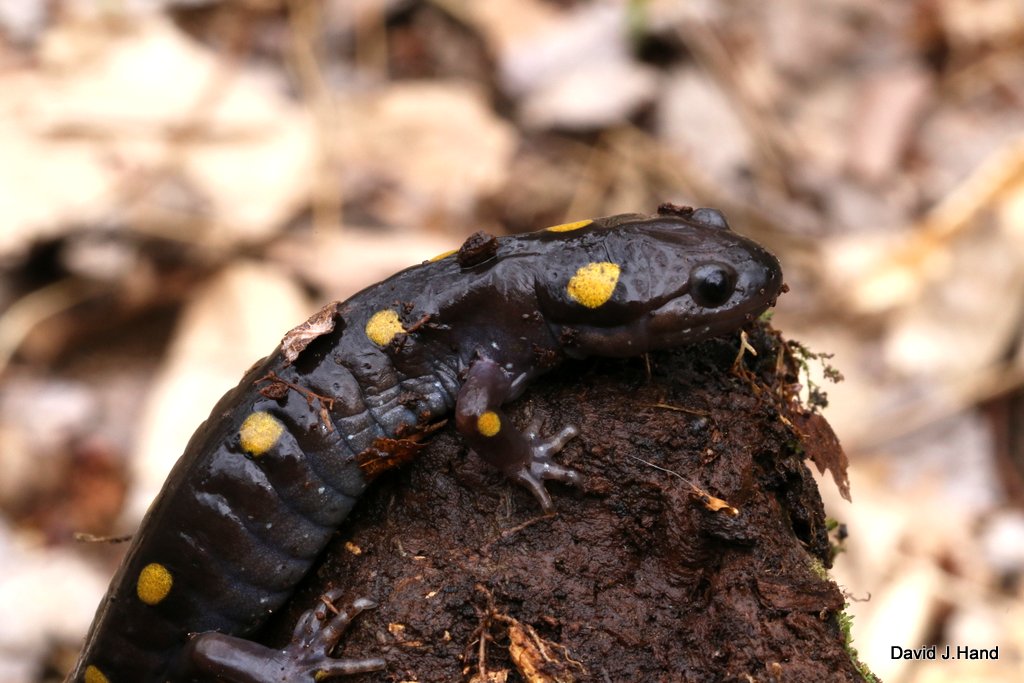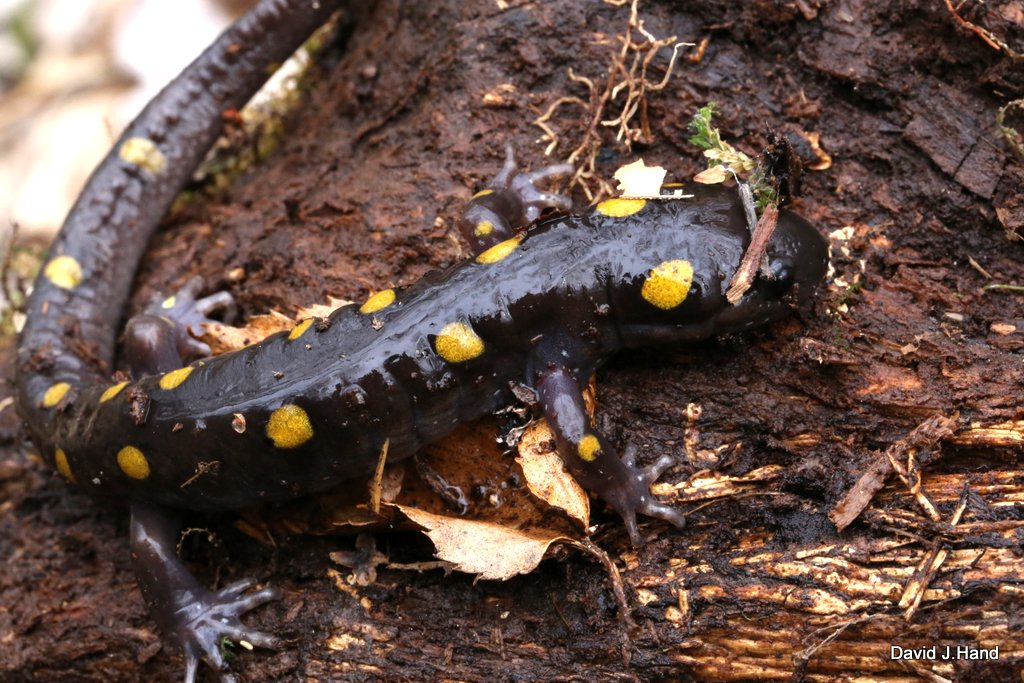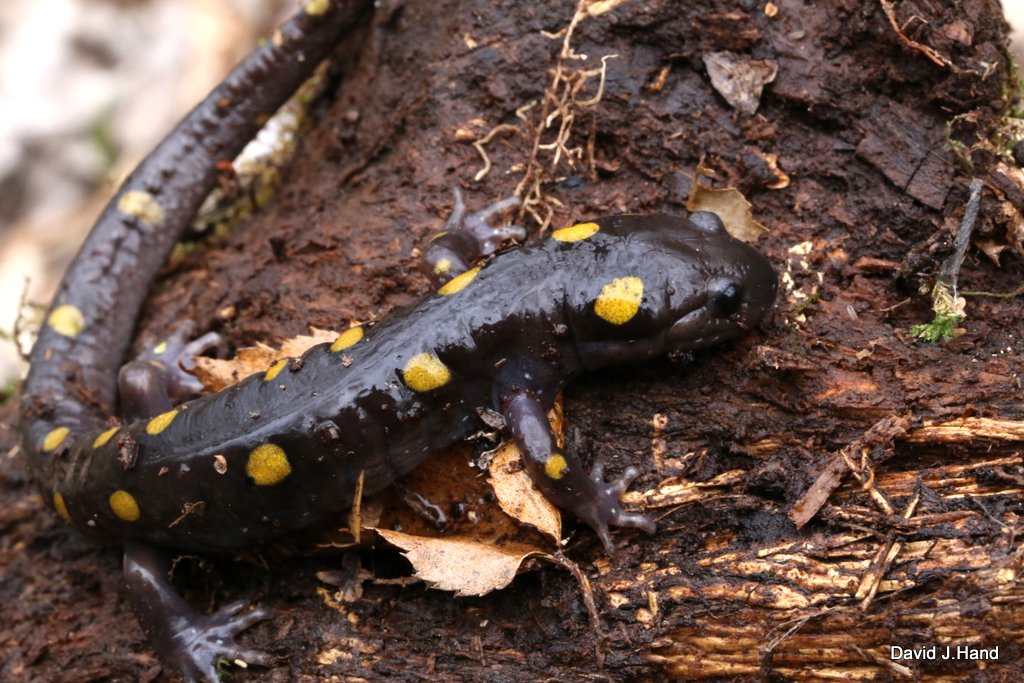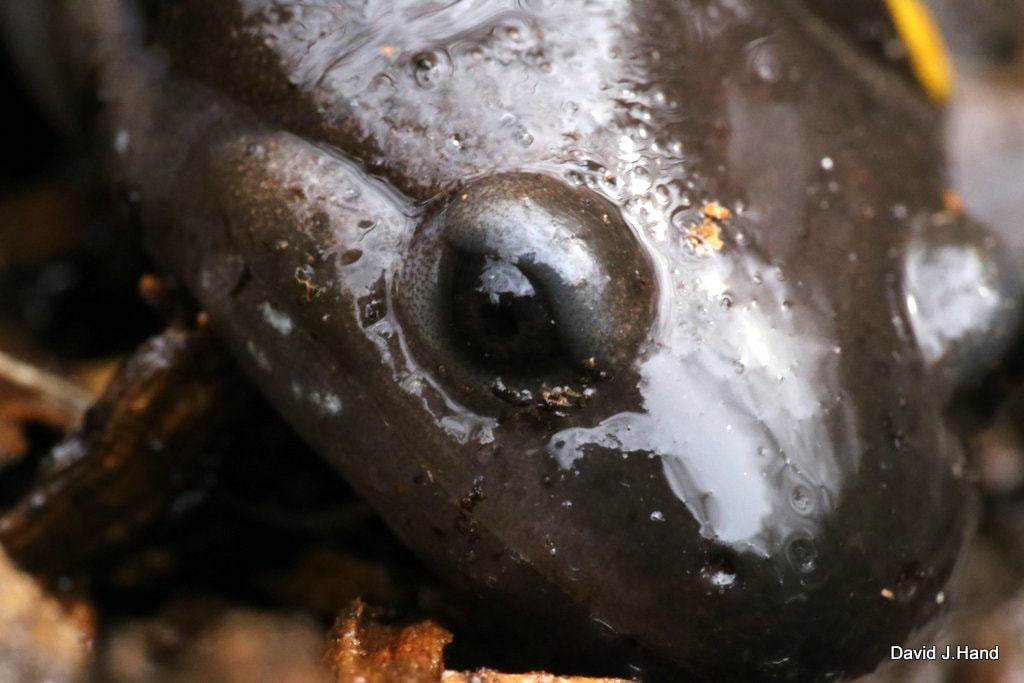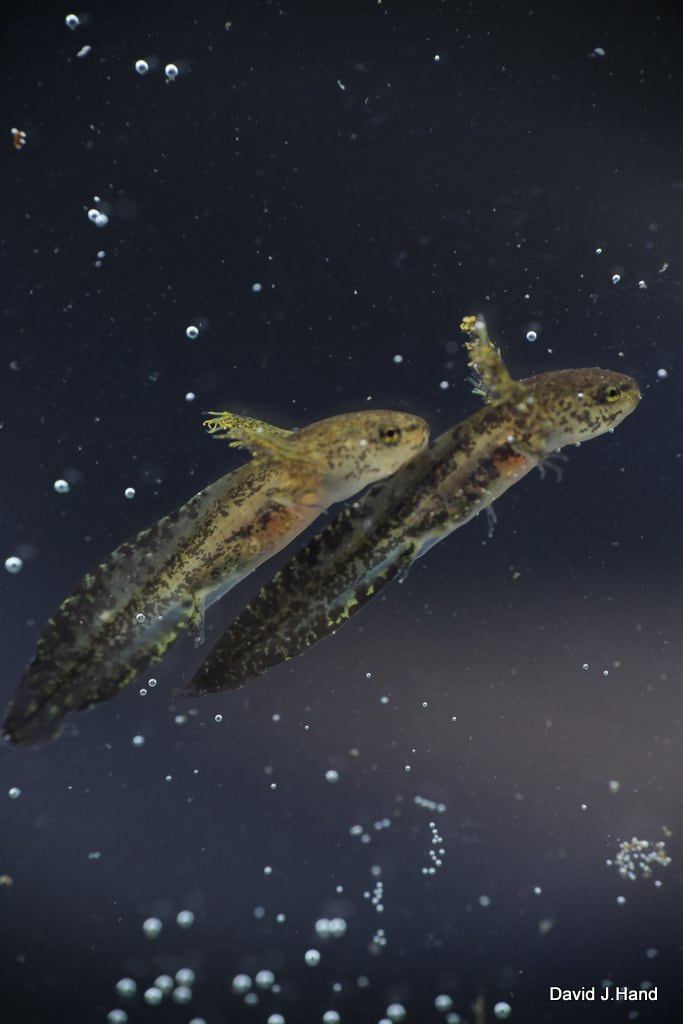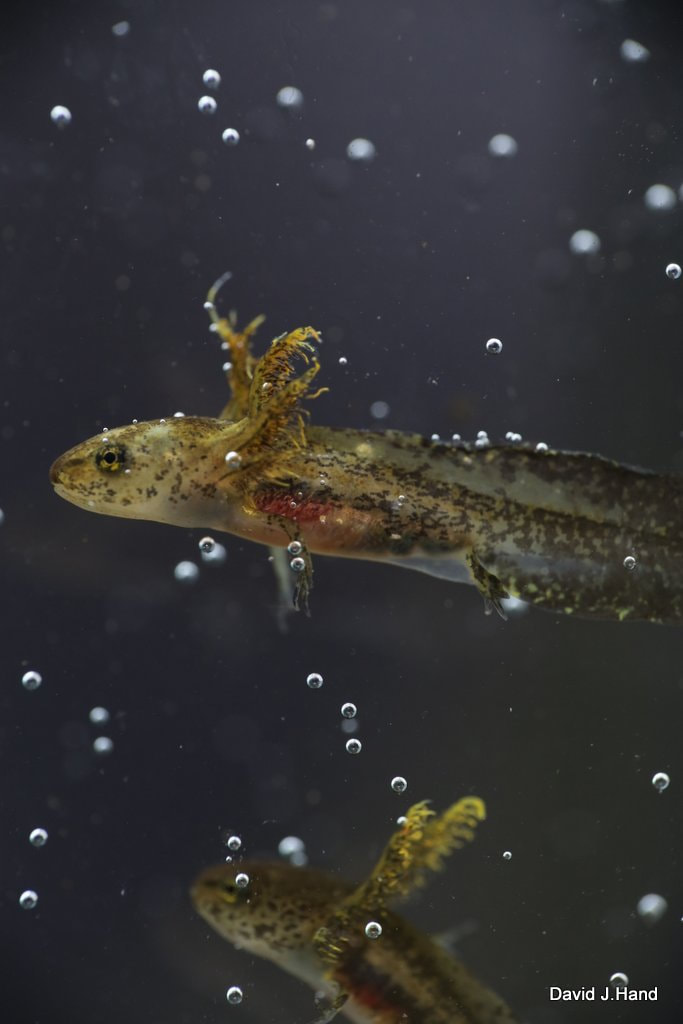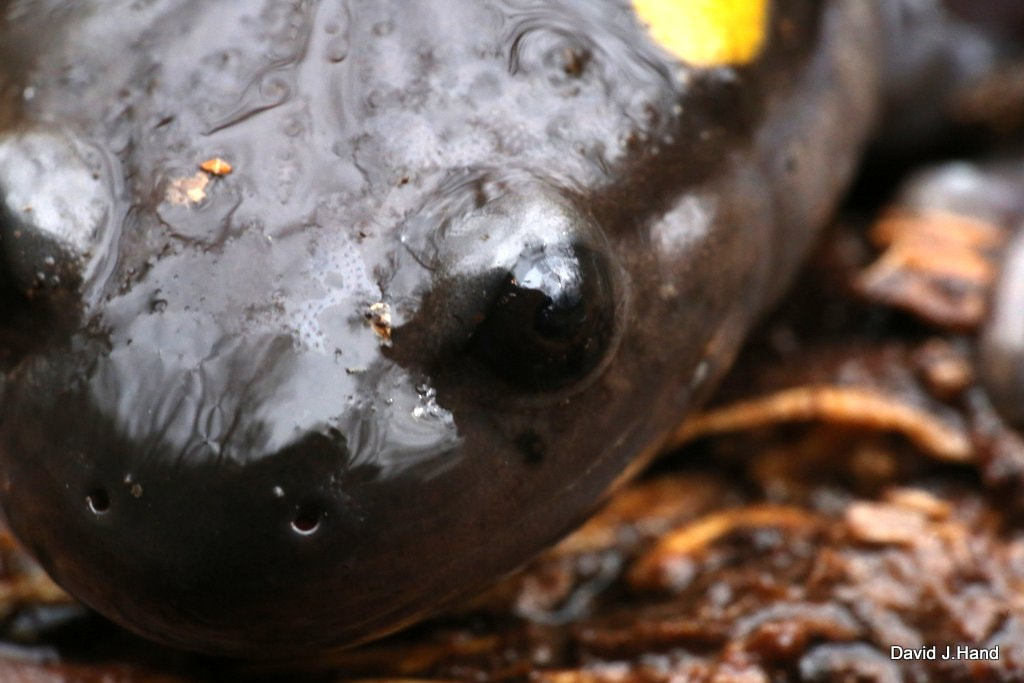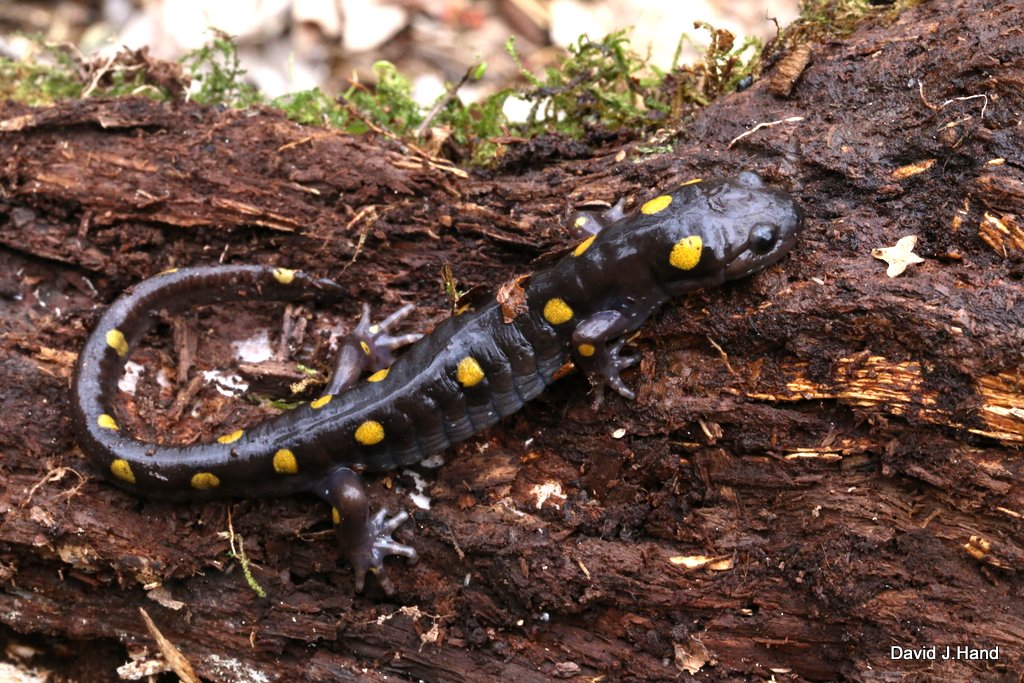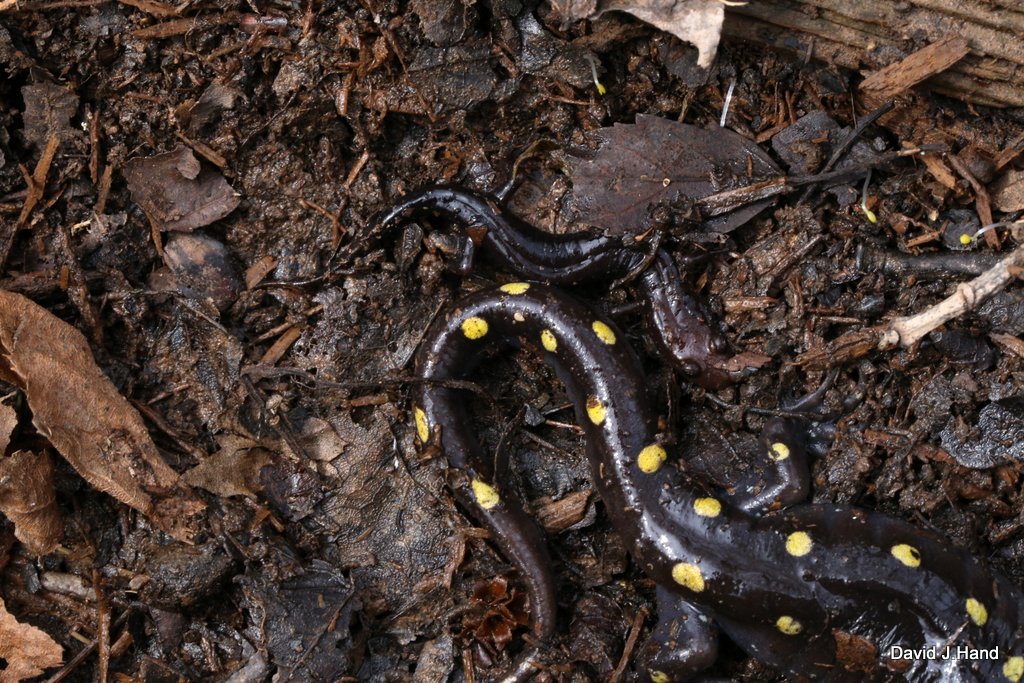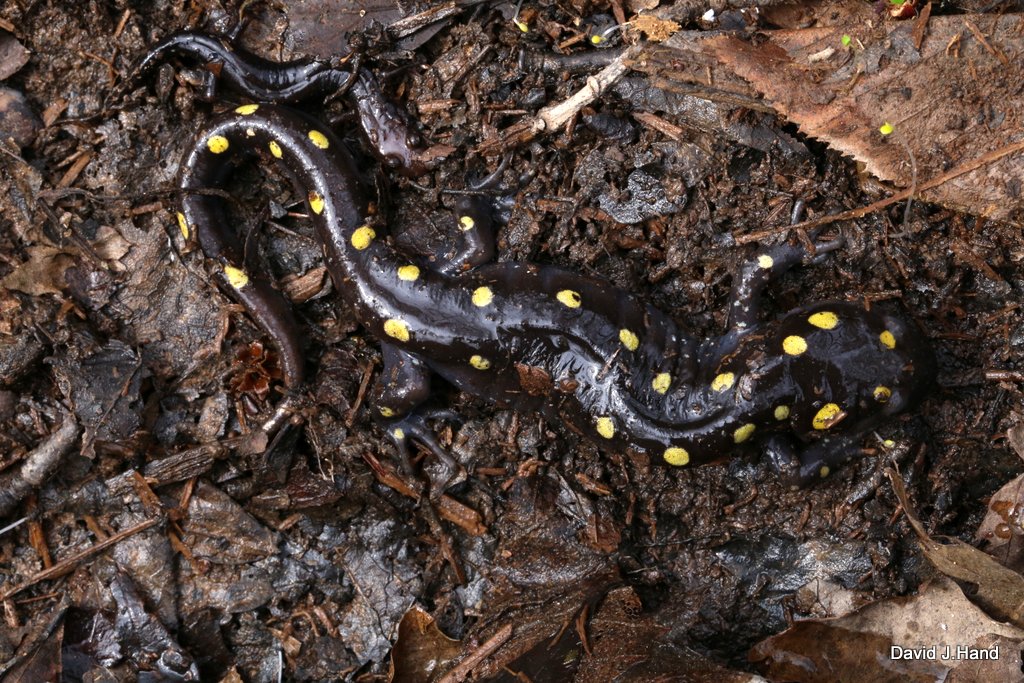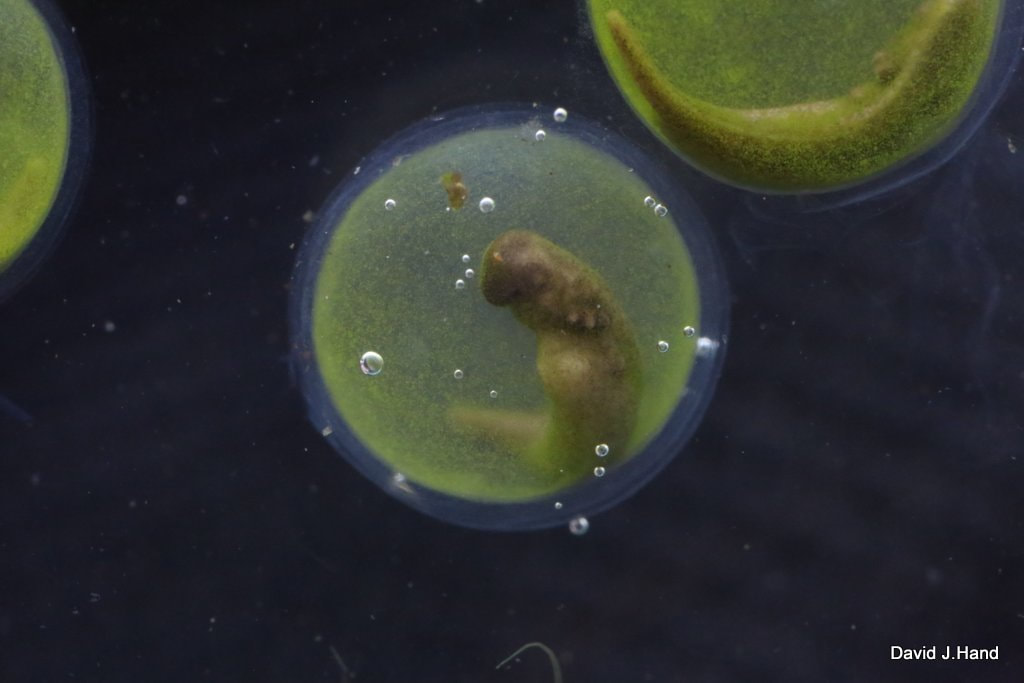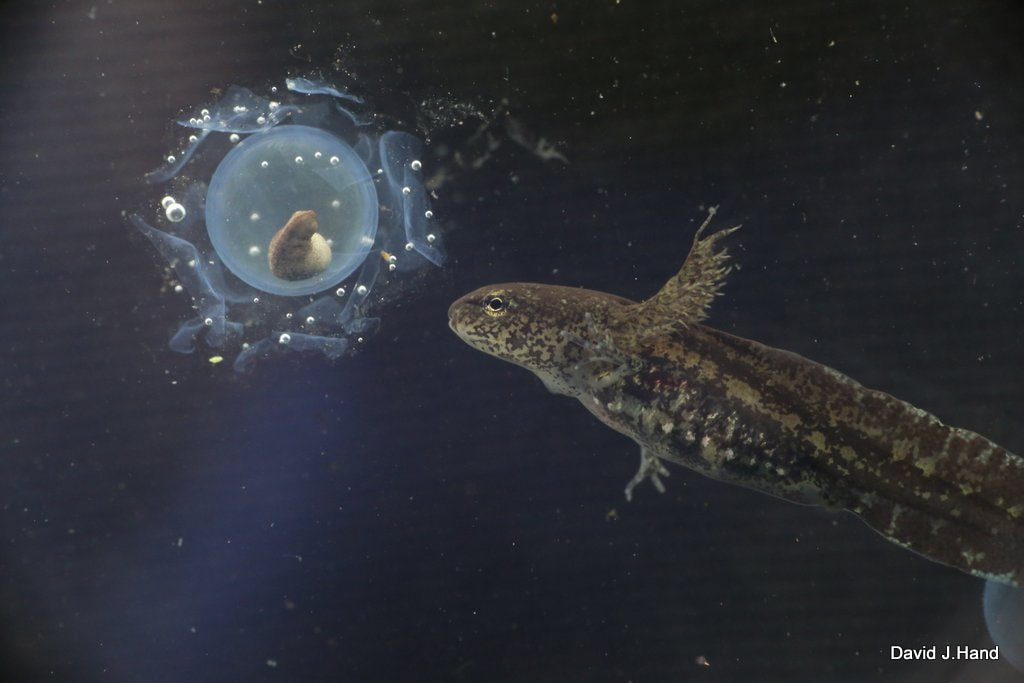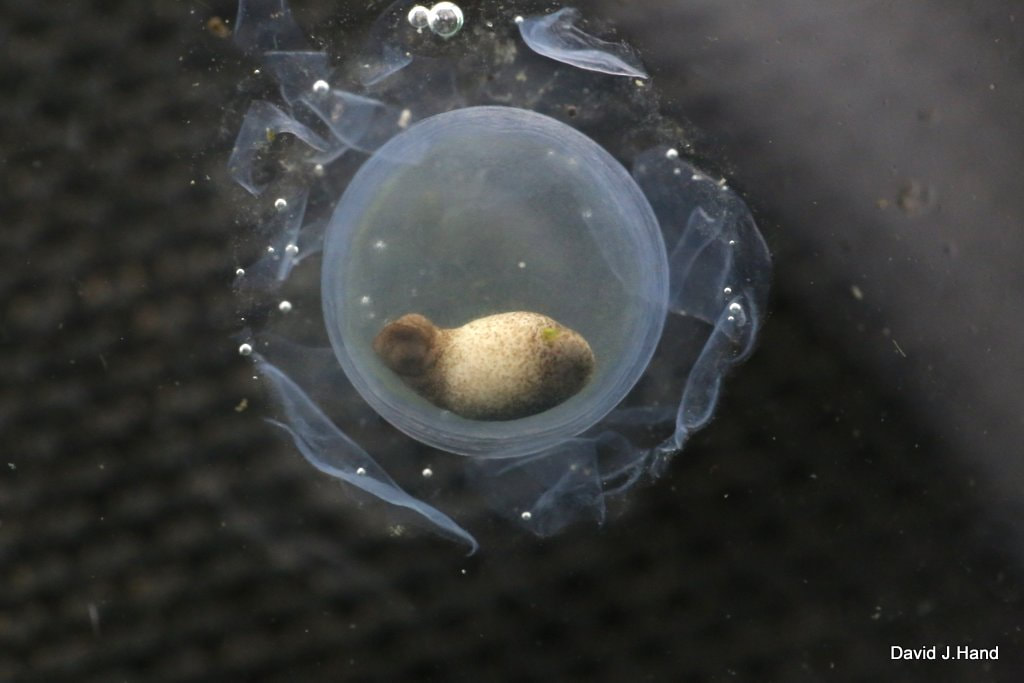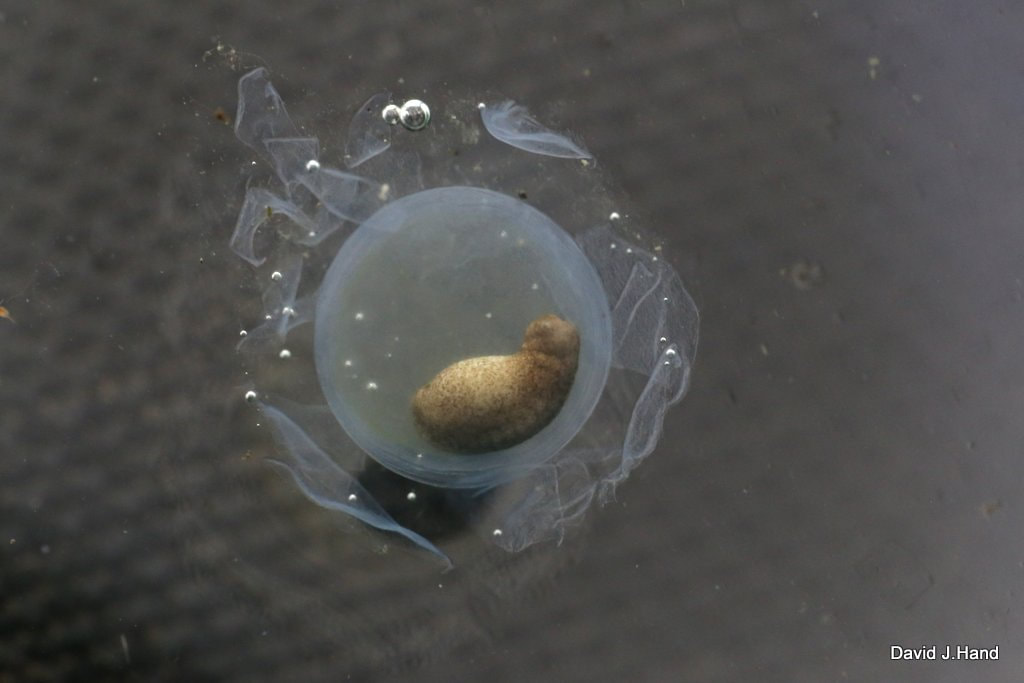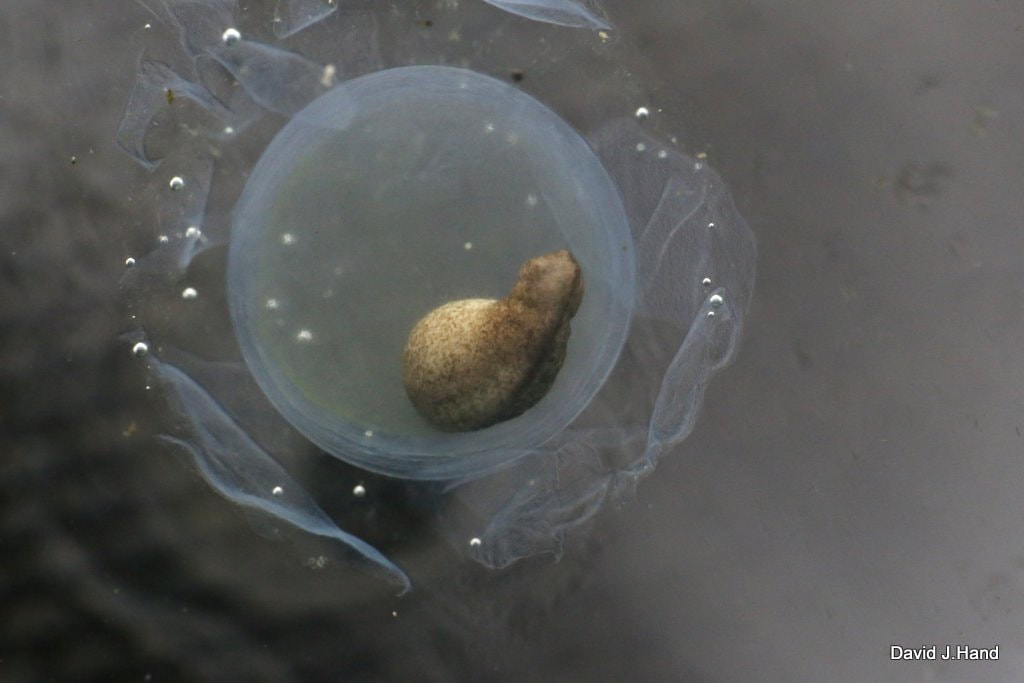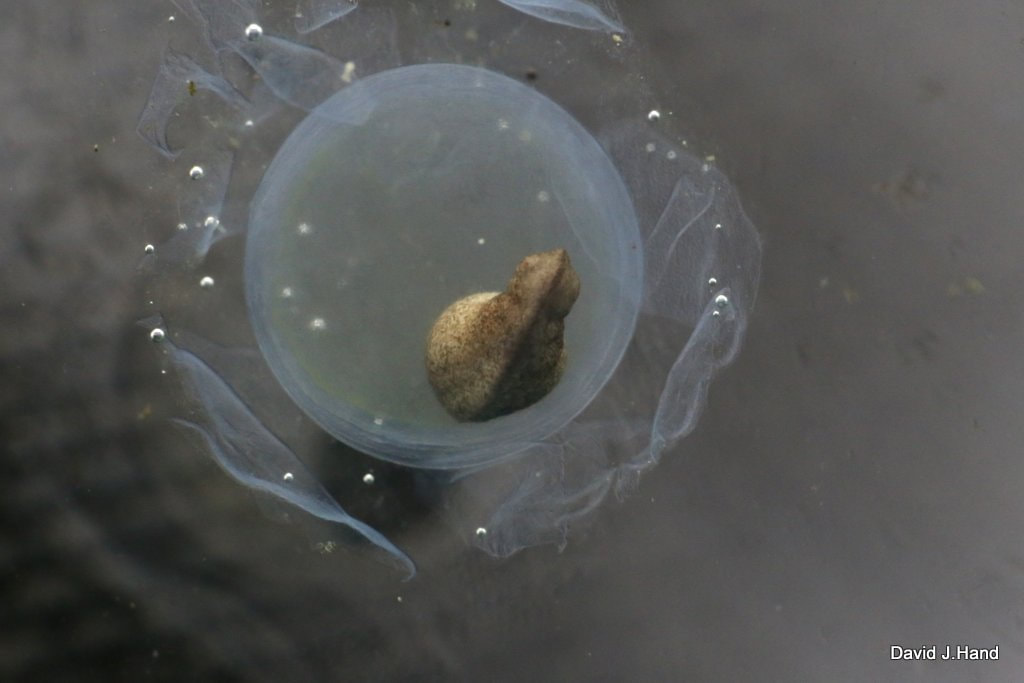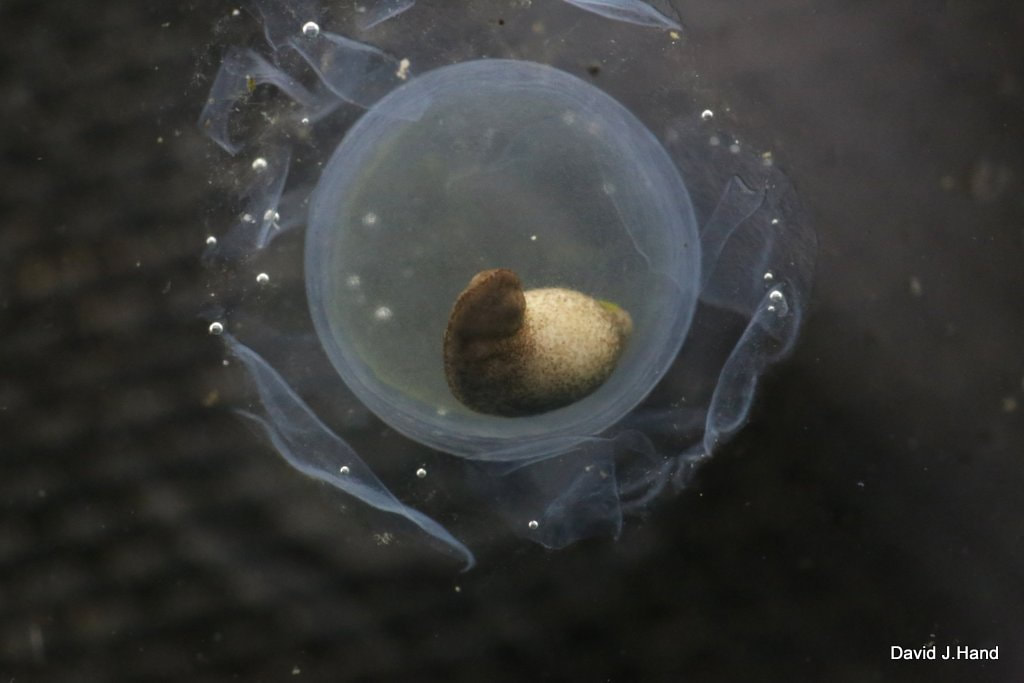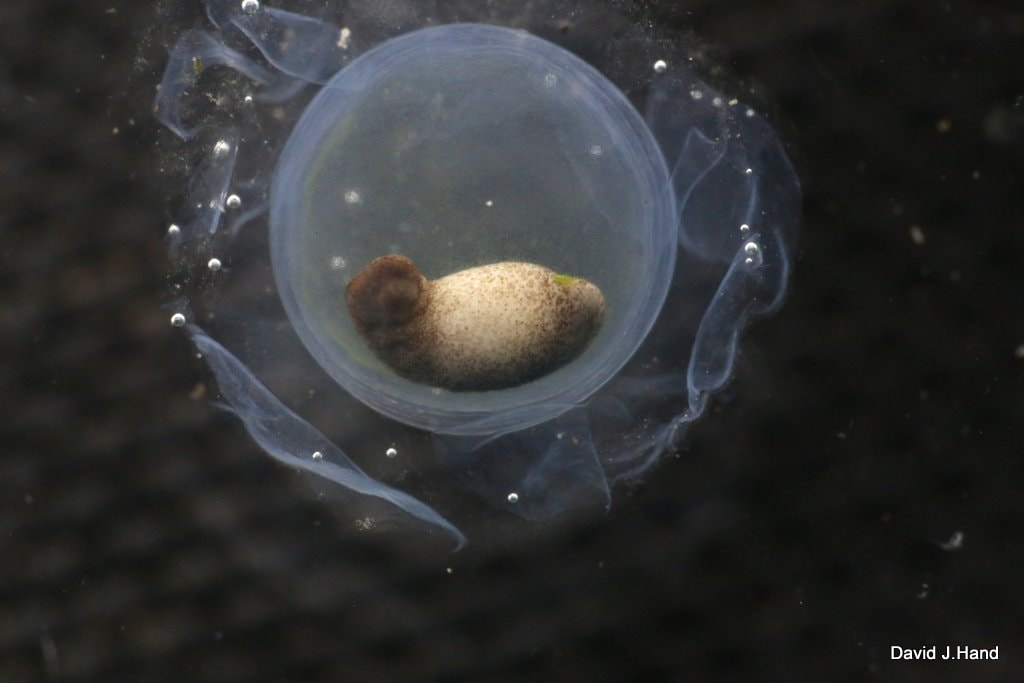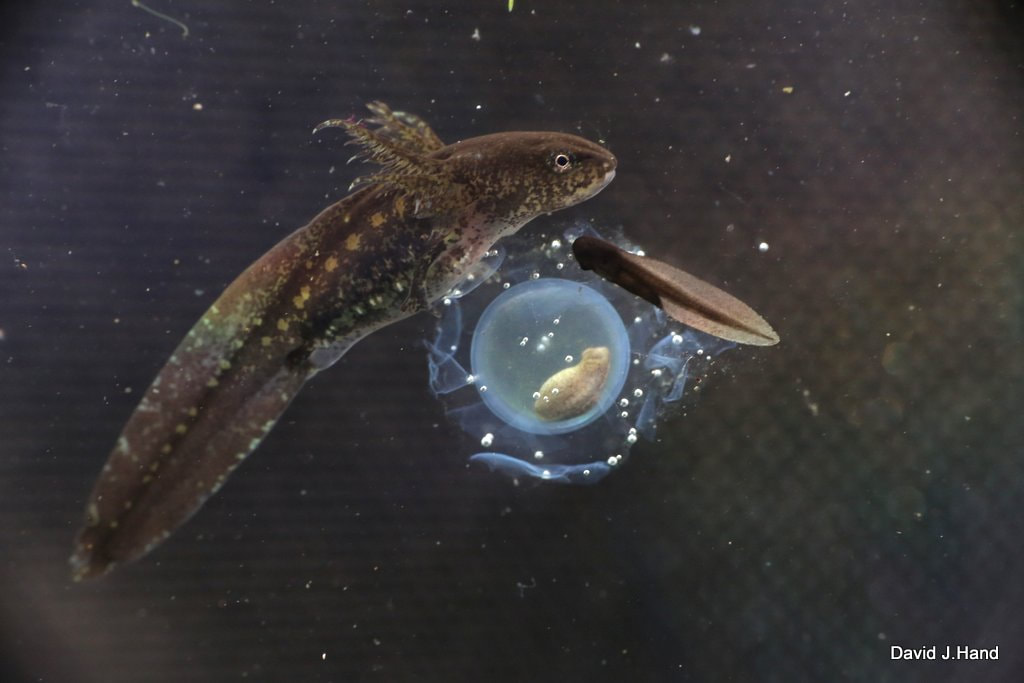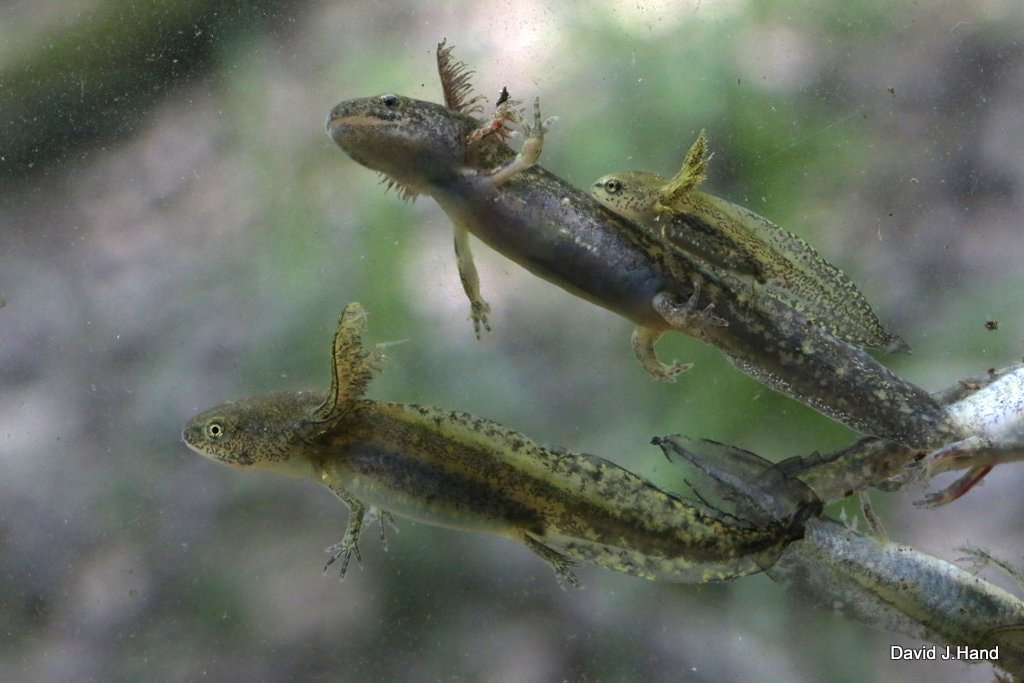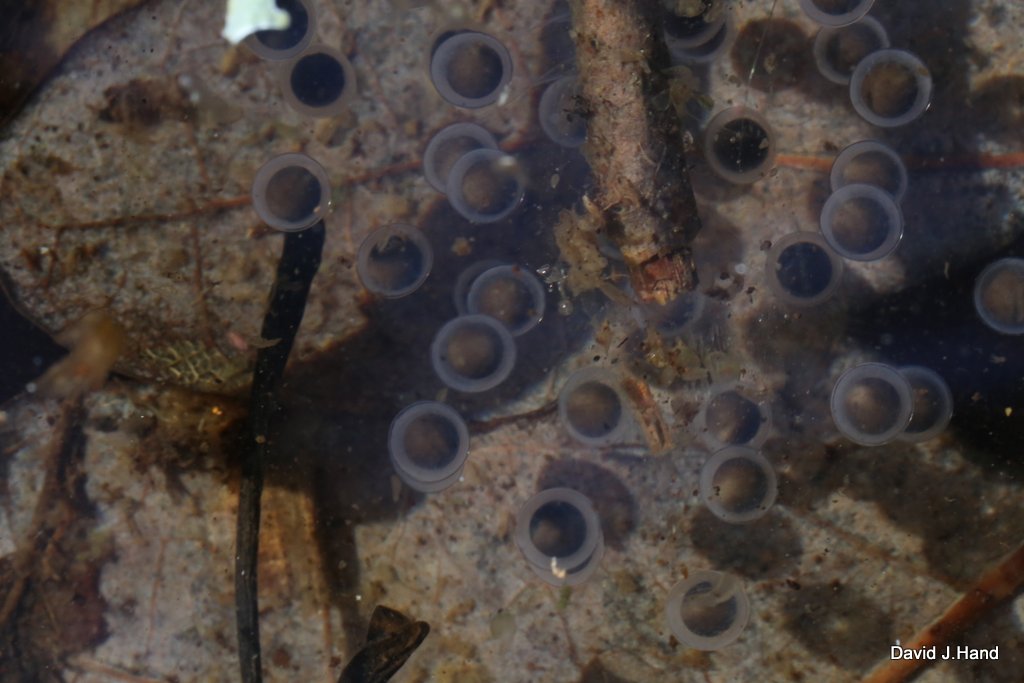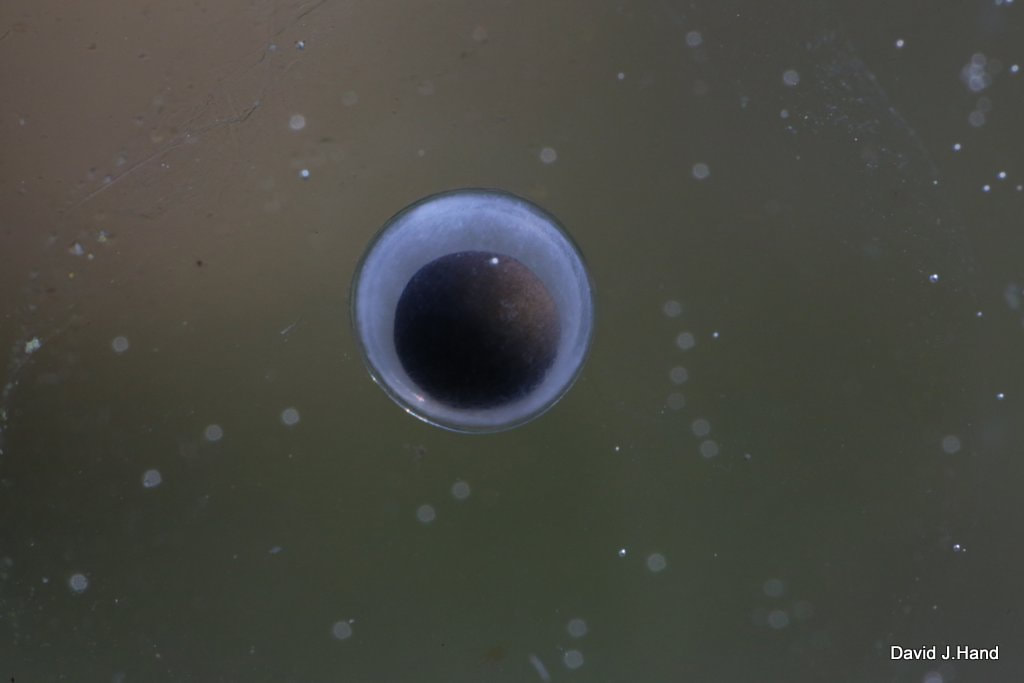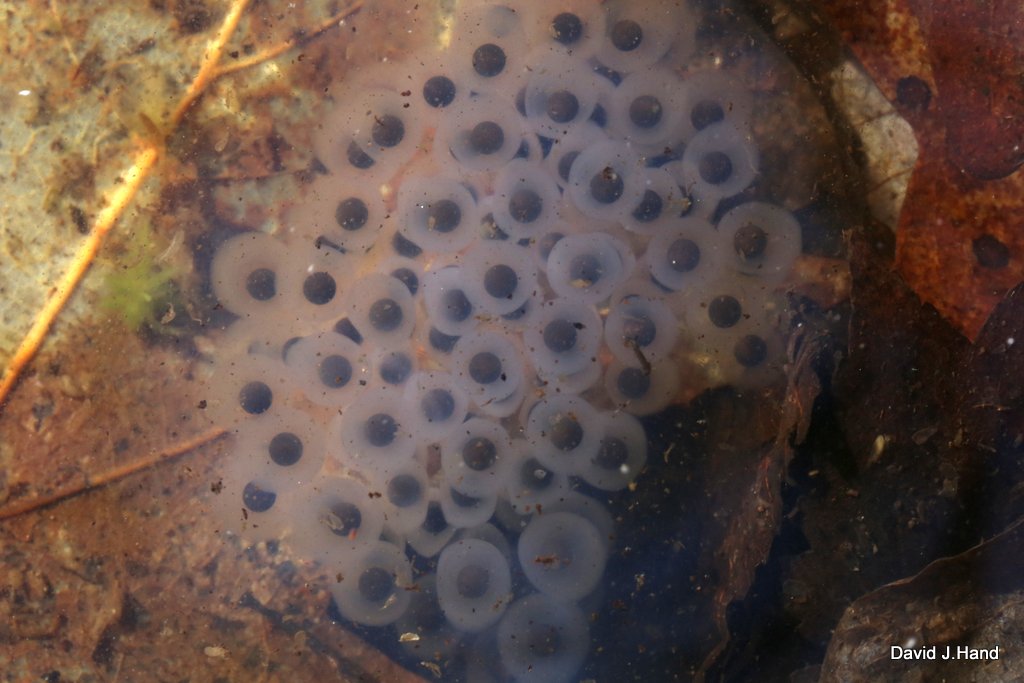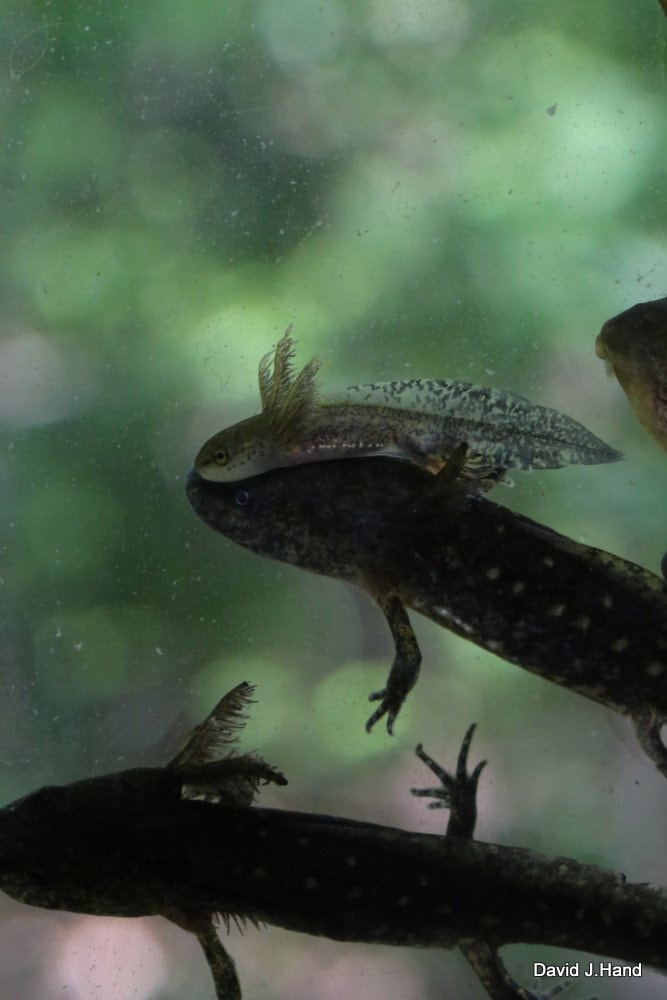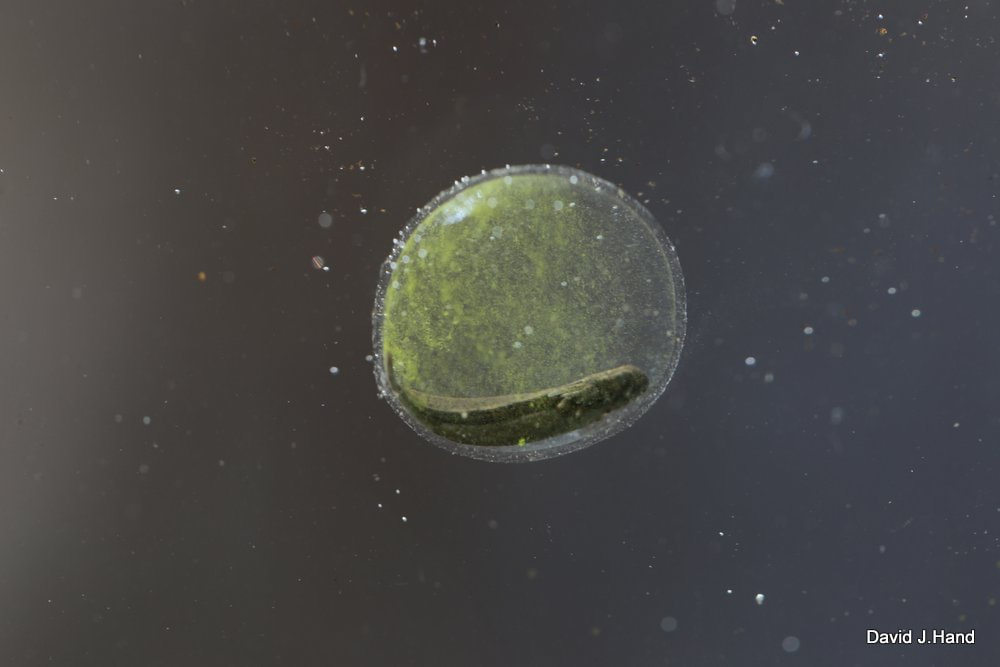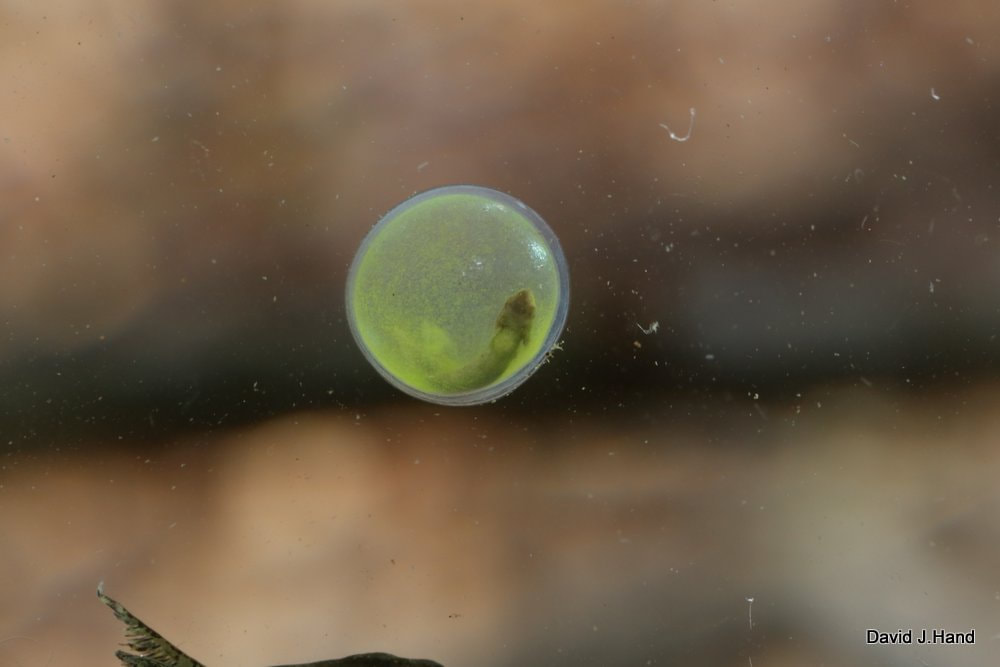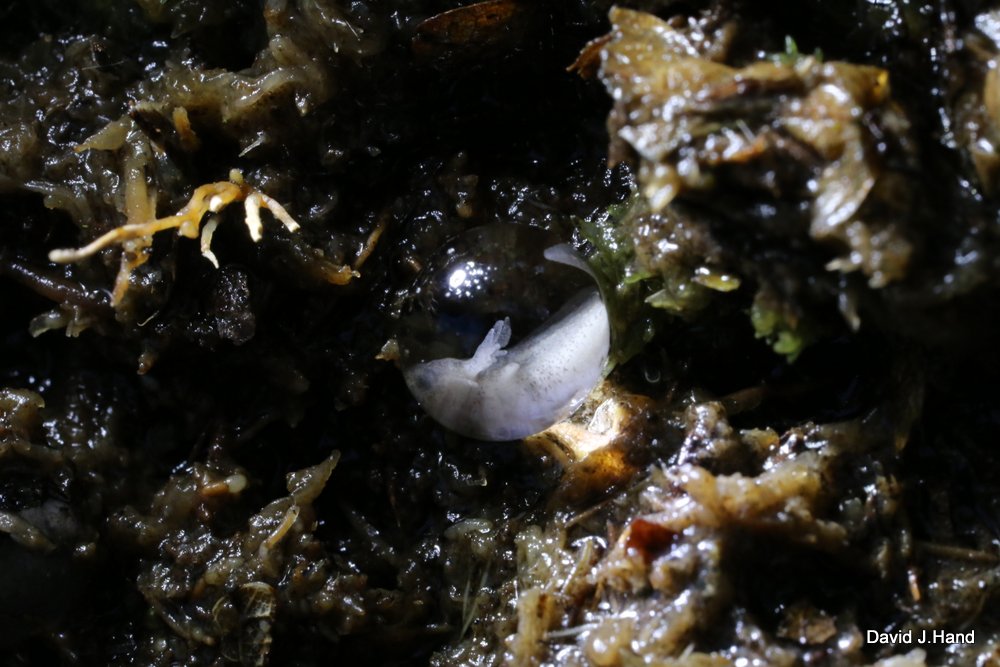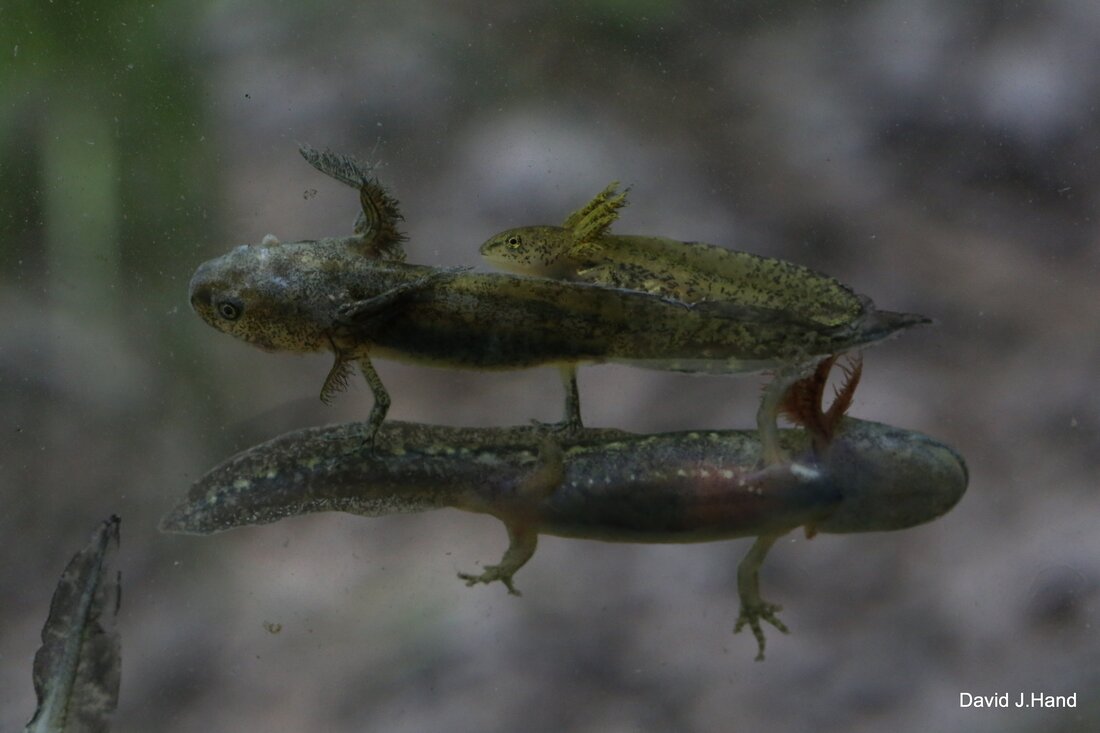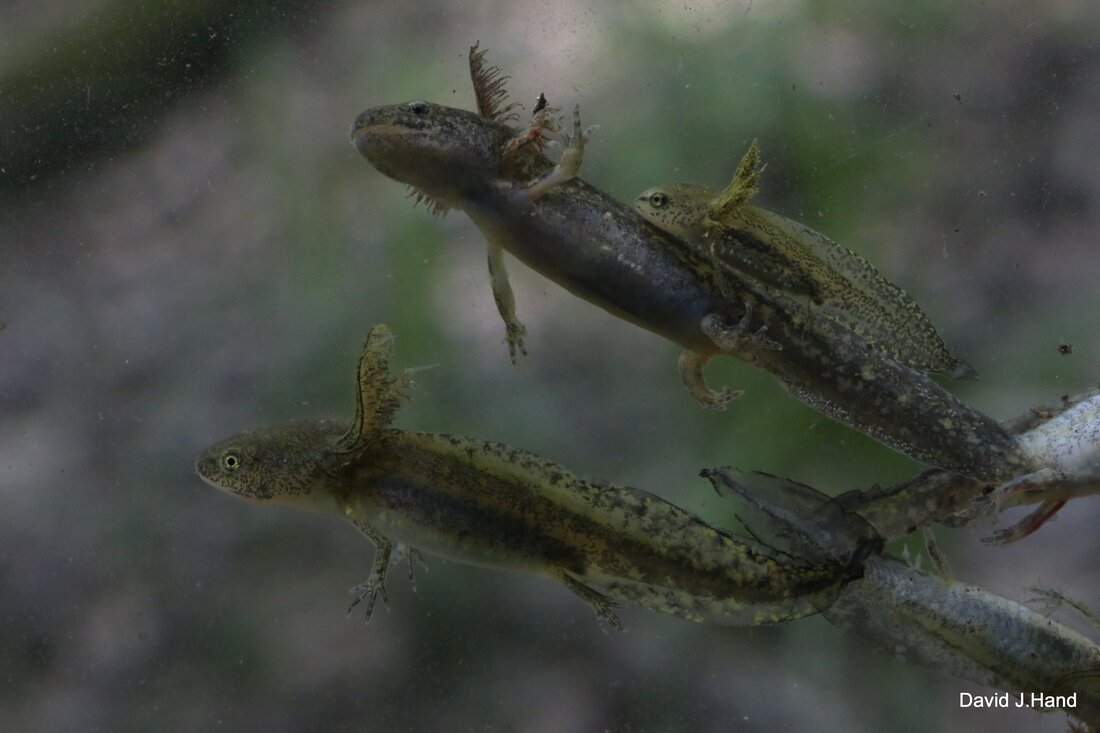Spotted Salamander 2 [Ambystoma maculatum]
Please remember while out herping in Pennsylvania you need to have a current fishing license and please please remember to follow decontamination procedures as not to spread germs,diseases and unwanted fungus to these important areas!If you not willing do follow these procedures,you should not be out!I personally always wear protective gloves [Nitrile], even if I don't handle salamanders and I do try to never touch them.I also spray myself [boots,waders,gloves,net,photographic tank...] with a chlorhexidine solution.
[Chlorhexidine, is a disinfectant and antiseptic that is used for skin disinfection]
[Chlorhexidine, is a disinfectant and antiseptic that is used for skin disinfection]
One month old Jefferson Salamander Larvae [top] with one week old Spotted Larvae [bottom]. [Ambystoma jeffersonianum & maculatum]. Perry County, Pa. 4-29-24. The Spotted larvae are approximately 10 mm in length, notice their large balancers.
One week old Spotted Salamander larva compared to a five month old Marbled Salamander larva. Perry County, Pa. 4-29-24. [Ambystoma maculatum & opacum]
One week old Spotted Salamander larva compared to a five month old Marbled Salamander larva. Perry County, Pa. 4-29-24. [Ambystoma maculatum & opacum]
A comparrision of larvae at different stages of development. Top is a five month old Marbled Salamander larva, middle [3] are 1 month old Jefferson Salamander larva, and bottom is a week old Spotted Salamander larvae. [Ambystoma opacum & jeffersonianum & maculatum]. Perry County, Pa. 4-30-24
Jefferson Salamander embryos on the left and Spotted Salamander embryos on the right, in the middle are Jefferson embryos that did not develop. Tioga County. Pa. 4-6-24
Spotted Salamander stage 20 of embryonic development and approximately 11 days old. Notice you can clearly see the developing spine and you can just make out the eye. Tioga County, Pa. 4-6-24 [Ambystoma maculatum]. Also notice the algae [Oophila amblystomatis] in the egg, it is the first known within cell partnership ever observed in vertebrates. The algae produces oxygen which the embryos need and the embryos produce nitrogen that the algae feeds on. Even as adults this same algae can be found residing inside the salamaders cells. A truly amazing partership known as "endosymbiotis". Also of interest I have noticed for a number of years and have documented an algae inside the eggs of Jefferson Salamanders, but scientist have yet to discover the same within cell relationship. But it it is there for a reason so I think it is only a matter of time before the same relationship is dicovered.
From Left to right,Jefferson Salamander, Spotted Salamander, Eastern Red Spotted Newt. Tioga County, Pa. 3-16-24
Male Spotted Salamander [Ambystoma maculatum]. North Central, Pa. 3-16-24
Female Spotted Salamander [Ambystoma maculatum]. Dauphin County, Pa.. Tell me she is not smiling!
Three quarters on the Pennsylvania Ambystoma salamander larvae tree, all in one vernal pool! 30 week old Marbled Larvae [top] 8 week old Jefferson [middle] 4 week old Spotted [bottom]. Pa. 5-19-23. Ambystoma opacum, A. jeffersonianum, A. maculatum
8 week old Jefferson Salamander larva [Ambystoma jeffersonianum]. Of the three Ambystoma species, Jefferson, Marbled, and Spotted, there is no mistaking Jefferson at this age. They are wider and have a chunkier appearance and also have a distinct line separating the white of the underside and the grey green of the side. They can also have very little if any spotting along the side as Marbled or Spotted will have at this age, also notice those longer dainty toes [compared to Spotted and Marbled], a sure sign of Jefferson. Notice too the Hind limbs are just starting to make an appearance. Pa. 5-19-23
Two week old Spotted Salamander larva. Pa. 5-7-23 [Ambystoma maculatum]
24 week old Ambystoma opacum larva with a two week old A. maculatum larva. Pa. 5-9-23
Just a few weeks ago this pool was all but dried up and I feared the worst for the Salamander larvae in it, there are Jefferson, Spotted and Marbled here. After some recent rains the pool is now just about full and larvae were seen everywhere, rain just in the nick of time, what a wonderful sight! Pa. 5-9-23
Newly hatched larvae, Spotted Salamander [left] and Jefferson Salamander [right]. Pa. 4-24-23 [Ambystoma maculatum & jeffersonianum]
This newly hatched Spotted Salamander larva is off the a rough start. Notice it has no balancers and a bite mark on its right side that removed the gills. But also notice the "forks" of its developing forelimbs. No to worry even these tiny larvae can regenerate missing body parts at an alarming rate, and I am sure it will be just fine, if it can avoid all the dangers waiting for it in a vernal pool. [Ambystoma maculatum], Pa. 4-24-23
|
|
|
It is wonderful to get out in nature and learn something new and I have learned a lot on this day. I have always thought that the coal region should be explored for amphibians, to see if these areas, once ravaged and dug, striped for coal long ago, not to mention the damage done to streams and water, are now possibly being used and holding populations of amphibians. I have noticed most of "coal holes" have water at the bottom of these holes or coal stripping's, and I have been very curious about these places. So yesterday was the start of much overdue exploring that I hope to do of these now reclaimed and grown over lands in my own back yard of Schuylkill County. At my very first stop at what was once a "test hole" for coal, I was very excited [I could not believe my eyes!] to see the water teaming with life, from tadpoles to Spotted Salamander egg masses. Most of the egg masses were out of water at this pool, as it was down 4 to 5 feet, thinking these eggs were no longer viable, again I leaned something new, even the egg masses far from water and looking very dried out, were still very much viable and alive as the embryos were seen moving inside the eggs. I rescued all the egg masses that I could find by putting them back in the water and I am sure they have hatched as they were fully developed. So lesson learned, egg masses out of water are not always dead, even eggs out of water for extended periods. Also what a wonderful discovered to find these coal mined lands can and are being used by amphibians, and to find out how resilient and adaptable these creature can be. I did see other deeper coal holes that I could never possibly reach also full of Spotted Salamander eggs and frogs of all kinds [unfortunately tires too]. So when driving through these regions and you think like I did, that there isn't any chance of these places and pools at the bottom of old abandoned mines and coal holes, holding life, think again! My wonder and admiration and respect for the natural world to over come all the damage that mankind has done and continues to do to our planet, is truly remarkable! Schuylkill County, Pa. 4-27-23
Another spring and another bad situation developing here in Pennsylvania. Very little spring rain and a winter with next to no snow leads to devastation like this. This is one of the few vernal pools that I know that contain Marbled, Jefferson, and Spotted larvae. In the small pools there are many large Marbled larvae, large for this time of year having hatched only some 12 weeks ago in early December. But remembering larvae metamorphosis speeds up when pools start to dry up and oxygen levels drop. They are developing fast and their lungs are functioning as they are coming to surface for frequent gulps of air, you can see their tiny ripples on the surface of the drying pools. They, the Marbled, stand a chance of completing their metamorphosis to land but the newly hatch Jefferson and Spotted [egg masses with embryos exposed to the air, you could see the ready to hatch embryos moving inside their eggs] have no chance of surviving this year once again, unfortunately. Pa. 4-24-23
At approximately 9 days old these Spotted Salamander embryos are in what is called the neural stage "the neural folds are fused along the entire length of the embryo to form a suture. A head fold begins to become apparent." Pa. 4-14-23. Notice the difference in the egg structure between the Spotted eggs [1&2], and the Jefferson egg picture [3]. Each has what I refer to as 3 "shells' or membranes that make up the egg. But notice the greater distance between the first and second membrane in the Spotted egg, compared to that Jefferson egg which has all three membranes tight together [appearing as one], and no spacing. This is a good way to tell the difference between egg masses in the field, at least between Jefferson and Spotted. The distance from the Jefferson embryos always appears right up to the edge of the egg membrane [appearing to fill the whole egg], whereas Spotted there is always a gap between the outer edge of the egg membrane and the embryo. [Ambystoma maculatum & jeffersonianum]
I have always found balancers on the heads of the Ambystoma salamander larvae that I am familiar with, Jefferson, Spotted, Marbled, fascinating. They provide stability for larvae until their forelimbs can provide balance and locomotion, and in the meantime balancers, located on either side of the head, act as stabilizers keeping the larvae upright and from sinking. When the forelimbs become developed enough and the balancers are no longer needed they are absorbed into the larvae. I have long noticed what I thought was a connection between how developed the forelimbs were at the time of hatching and the size of the balancers. These pictures show a correlation between forelimbs at hatching and the size of the balancers. The first two pictures [5&4] show Jefferson larvae at the time of hatching that have no developed forelimbs only what I refer to as "post" where the forelimbs will eventually be. Notice how large the balancers are, as these larvae need them to help navigate and stay "balanced" until forelimbs appear. The third picture [3] shows a Spotted larvae right after hatching, notice the forelimbs are underdeveloped but much more developed than that of the Jefferson. If you look close you can see tiny digits where the toes will be. Again you have large balancers on the head but not as large as that of the Jefferson larvae. The Spotted larvae will also depend on their balancers for balance and locomotion as they try to navigate in their new watery home. Then we come to the Marbled larvae pictures 1&2. Notice they hatch with completely developed forelimbs, you can clearly see their toes even on the embryo inside the egg [2]. Notice their balancers are tiny, even hard to see. When Marbled hatch they are already able to propel themselves through the water and balancers are not needed or at least very little. I can't help but wonder about the fact that that Marbled show very tiny balancers, when they aren't really needed, isn't a reflection of evolution and a time when Marbled larvae had much larger and more pronounced balancers for their needs at a time long ago. I think these pictures show a direct correlation in forelimb size at hatching and balancer size. Balancers are an amazing adaptation that is provided by nature and evolution to help newly hatched larvae as they try to negotiate and maneuver in their new watery home until their forelimbs are developed and are strong enough and the balancers are no longer needed.
Male Spotted Salamander showing some orange spotting in the spot on his chin. [Ambystoma maculatum]. Dauphin County, Pa. 4-7-23
One of the most beautiful patterned Spotted Salamanders that I have ever encountered. A male, found in my friends yard under some boards in a "sea of worms". In one of the pictures he was doing some defensive posturing, which up till now I have never witness this behavior in person. He was released unharmed. [Ambystoma maculatum]. Dauphin County, Pa. 4-7-23
A male Spotted Salamander [Ambystoma maculatum]. Dauphin County, Pa. 4-7-23
A male Spotted Salamander showing defensive posturing, holding his tail in the air and undulating it back and forth. [Ambystoma maculatum]. Dauphin County, Pa. 4-7-23
A male Spotted Salamander showing defensive posturing, holding his tail in the air and undulating it back and forth. [Ambystoma maculatum]. Dauphin County, Pa. 4-7-23
One of the most beautiful patterned Spotted Salamanders that I have ever encountered. A male, found in my friends yard under some boards in a "sea of worms". In one of the pictures he was doing some defensive posturing, which up till now I have never witness this behavior in person. He was released unharmed. [Ambystoma maculatum]. Dauphin County, Pa. 4-7-23
An unfortunate sight, a female Spotted Salamander didn't or couldn't reach the vernal pool in time. I have never run across this before and have no idea what could have happened. Predation does not seem involved as she was not eaten, although a great deal of her tail is missing. Notice some of her eggs have been expelled, possibly in her last act as she knew she was dying. Pa. 3-21-23 [Ambystoma maculatum].
Female Spotted Salamander [Ambystoma maculatum]. Spotted Salamanders and other amphibians are on the move to their breeding pools, so please be careful and aware on rainy damp nights while out driving. This female was full of eggs and was happy to make it to her pool and gave me a good wink! Pa.. Imagine for 20 years or more these salamanders not only return to their same specific pools but use the same route to and from these pools year after year. Scientist are still trying to unlock the secrets of how they find and use the same trails year after year. I suspect it is their powerful sense of smell, and their keen ability to distinguish different scents around them. When observing Spotted, Jefferson and Marbled salamanders looking for a mate and they come into contact with one another it only takes a quick, almost unnoticeable to the human eye, vent sniff and they have already determined if they have found the right partner. A small example of their truly remarkably keen sense of the world around them that you and I can never fully appreciate or understand. And isn't that just fine!
Spotted Salamander [Ambystoma maculatum] Pa.
Spotted Salamander [Ambystoma maculatum]. Pa. 4-5-19
Two female Spotted Salamanders bursting with eggs [Ambystoma maculatum]. Pa.
Spotted Salamander [Ambystoma maculatum]. Pa.
Spotted Salamander [Ambystoma maculatum]. Pa.
Spotted Salamander [Ambystoma maculatum]. Pa.
Looking back on our summer trip to Northern New Hampshire, I had visited a pool formed in an old logging road and a spring. The last time I was at this remote location it was fall and there were a great many tiny larvae and like many locations in that area, they were nowwhere near ready to metamorphose to land. I concluded that maybe they take two years to complete metamorphosis [I have seen this here in Pa. at a spring fed pool with Spotted]. I was hopeful when getting to the pool this year that I would see larger examples of larvae, but just like in 2017, only very tiny larvae and even eggs with embryos and it was July 7. I believe these to be Spotted [Ambystoma maculatum]. But here in Pa. Spotted hatch with developed forelimbs and I documented this year that Jefferson hatch with their forelimbs not developed only little post where the limbs will be. You can see on these hatched larvae the forelimbs are under developed. Perhaps the hatched ones are Jefferson and ones still in the eggs are Spotted [notice that eggs are full of algae, unique to Spotted], notice too the large gap between the inner and outer egg membrane in picture 5 [a good indicator of Spotted eggs]. I did see a number of larvae and embryos with a black circle around their eyes, something that I have never witnessed before and cannot say what it is. I think it is interesting to see the large balancer on the left side of larva's head 2 & 3 compared to the right side, I have seen this a lot in many species of larvae. I have read that salamanders are pool specific, meaning that they use the same pools from year to year. So my guess is that they were using this wet area long before the logging road was put in many years ago. Or because of the water pooling in the ruts, did this offer a new area for salamanders and frogs to breed. The things that I like to ponder and think about, and it's okay to never really know the mysteries of amphibians and their lives deep in the forest.
Ambystoma larvae found in a tiny pool in Northern New England. 7-11-22
Finding Ambystoma larvae in moose tracks in Northern New England. Listen to Boreal Chickadee giving me a scolding at the beginning.
The beautiful coloration of 6 week old Spotted Salamander larvae [Ambystoma maculatum]. Dauphin County, Pa. 6-9-22. The hind limbs, almost fully developed, have come a long way from two weeks ago [picture below] when they were barely visible. The growth rate of Spotted larvae is truly incredible as they must a hurry to complete metamorphosis before their pool dries up in the summer heat. There is a real advantage the Marbled larvae has by hatching in the fall and having all fall, winter, and spring to grow and complete metamorphosis.
4 week old Spotted Salamander larva pictured above and below [Ambystoma maculatum]. Notice the hind limbs are just starting to show. Dauphin county, Pa. 5-31-22
Above and below. 28 week old Marbled Salamander larva with 4 week old Spotted salamander larva. [Ambystoma opacum and Ambystoma maculatum]. Central Pa, 5-31-22. For scale the A. opacum is 2 3/4" or 6.985 cm
A 4 week old Jefferson Salamander larva [Ambystoma jeffersonianum] shown with a one week old Spotted Salamander larva [Ambystoma maculatum]. Notice the tiny digits of the fore toes are becoming more pronounced on the Spotted, but the balancers are still in place and being used to help the larva in locomotion till the forelimbs become more developed and stronger. Notice the broad head of the Jefferson and those long toes a sure sign of Jefferson, also notice the hind limbs are just starting to make an appearance. North Central, Pa. 5-20-22
I feel the pictures that I took earlier this spring clearly showed that Jefferson larvae [Ambystoma jeffersonianum] hatch without functioning forelimbs, but rather just tiny points were the forelimbs will eventually be. These pictures [above and below] show a newly hatched Spotted Salamander Ambystoma maculatum], they also seem to hatch without functioning forelimbs as well, but a little more developed than the Jefferson larvae at this stage. You can make out the tiny digits developing at the ends of the forelimbs. Another good reason for the balancers, as seen on the head of the larva, for assisting the larvae in balance and locomotion, till the forelimbs become completely developed. Also seen to the left of the larva is what is left of a Spotted egg casing, the vernal pools are full of such empty casings at this time.
This Spotted Salamander [Ambystoma maculatum] embryo will hatch anytime now, notice the inner egg has split. Also notice the larva is in a sea of algae. This is a special algae, Oophila amblystomatis, that lives inside the cells of the larvae and provides oxygen which the embryos need and in turn the algae needs lots of nitrogen and a place to stay which the embryo provides. This is the first such partnership, known as endosymbiosis , ever observed in vertebrates.
Spotted and Jefferson egg masses. The Spotted are the opaque ones at the beginning and end. The Jefferson are ready to hatch at anytime, in fact I witnessed some larvae out of the eggs and around the egg masses. Jefferson almost always lay their eggs sooner than Spotted, even laying them under the ice covered pools in some instances. North Central, Pa. 4-25-22
Newly hatched Wood Frog Tadpoles [Lithobates sylvaticus] feeding on Spotted Salamander [Ambystoma maculatum] eggs. Pa. 4-11-22. It does not take long after hatching for them to locate eggs to feed on..
Spotted Salamander egg and developing embryo. This is referred to as stage two of the cleavage stage. Dauphin County, Pa. 4-11-22 [Ambystoma maculatum]
Spotted Salamander eggs [Ambystoma maculatum]. Pa. 4-12-22
Two gravid female Spotted Salamanders [Ambystoma maculatum]. Dauphin County, Pa.
Two male Spotted Salamanders [Ambystoma maculatum] on their way to to a vernal pool. Just waiting for that right warm rainy night. Dauphin County, Pa. 3-10-22. Notice how much darker the one male is compared to the other.
A picture of what I like to refer to as "snub nosed" Spotted Salamander [Ambystoma maculatum]. Lacking the larger more rounded and protruding nose usually encountered on Spotted Salamanders, like the one pictured below. This was taken in Pa. in 2017
One handsome guy [above and below]! Spotted Salamander [Ambystoma maculatum]. Dauphin County, Pa.
Spotted Salamander from a few years ago, it was rescued from a small artificial pool and could not climb out. [Ambystoma maculatum]. Dauphin County, Pa.
|
Spotted Salamander larvae [Ambystoma maculatum], N.H. 7-6-21. And the tiny pool they were found in. Every year but one this tiny pool has had salamander larvae in it. It also has Blue Spotted as well. I find that every available pool of any size are being used by Ambystoma salamanders for breeding, in this area of the country. Even tiny pools like this one, associated with a remote road. A wonderful sight to see, as salamanders are opportunist using every available resource at their disposal for perpetuating their species. In many years these pools dry up in the summer heat and the larvae die, not being able to complete their metamorphosis to land. But every now and then the weather conditions are just right and the pools have sufficient water all summer and the larvae are able to complete metamorphosis to juvenile and then to adult salamanders, as every spring they are back as these same pools laying their eggs with the unending urge to reproduce. Each species and their larvae that depend on such pools, has to struggle every year to survive and perpetuate their kind. Even in an uncertain world these struggles and fights to survive are taking place all around us, even in the tiny remote pools of New Hampshire.
|
Two Spotted Salamander [Ambystoma maculatum] larvae showing different stages of regeneration. The larva below has recently lost its left forelimb and regeneration has started to occur. The larva above had lost its left hind toes and regeneration is almost complete, you can see the tiny digits of the toes are almost equal to the toes on the right side of the larva . These two larvae most likely lost limbs from other larvae who can and do prey upon each other. Coos County, N.H. 7-4-21
A nice collection of Spotted Salamander Larvae from New Hampshire [Ambystoma maculatum]. Coos County, N.H. 7-4-21
A four week old Spotted Salamander larva [Ambystoma maculatum].Pa.5-25-21.Notice how transparent it is underside, easily seeing the heart, stomach, and intestines.
Spotted Salamanders [Ambystoma maculatum].Tioga County,Pa.4-26-21.Much like other Ambytoma species, [Marbled, Blue Spotted, Jefferson.....] their individual patterns [spots and colors] are unique to each individual. These two female Spotted are a good example, they have completely different spot patterns. Much like a finger print each individual carries his or hers own uniqueness throughout their lives. Individual salamanders can be recognized year after year returning to the same vernal pools for breeding, in some cases up to 20 years! Nature can be so wonderful and amazing and we have so much more to learn
Two female Spotted Salamanders [Ambystoma maculatum].Potter County,Pa.4-26-21
Male Spotted Salamander [Ambystoma maculatum].Tioga County,Pa.4-26-21
Male Spotted Salamander [Ambystoma maculatum].Tioga County,Pa.4-26-21
Male Spotted Salamander [Ambystoma maculatum].Tioga County,Pa.4-26-21
Spotted Salamander [Ambystoma maculatum].Tioga County,Pa.4-26-21
Of the seven Spotted Salamanders found this day, this was the only male, a handsome fellow. A little on the thin side after breeding season.[Ambystoma maculatum].Tioga County,Pa.4-26-21. Little did we know this would be our Molly's last trip with us salamander hunting.
Of the seven Spotted Salamanders found this day, this was the only male, a handsome fellow. A little on the thin side after breeding season.[Ambystoma maculatum].Tioga County,Pa.4-26-21. Little did we know this would be our Molly's last trip with us salamander hunting.
Of the seven Spotted Salamanders found this day, this was the only male, a handsome fellow. A little on the thin side after breeding season.[Ambystoma maculatum].Tioga County,Pa.4-26-21. Little did we know this would be our Molly's last trip with us salamander hunting.
A female Spotted Salamander [Ambystoma maculatum] with Juvenile Allegheny Mountain Dusky Salamander [Desmognathus ochrophaeus].Pa.4-26-21
A female Spotted Salamander [Ambystoma maculatum] with Juvenile Allegheny Mountain Dusky Salamander [Desmognathus ochrophaeus].Pa.4-26-21
The best day that I ever had finding Spotted Salamanders, seven all together, 6 females and 1 male [These two are females].5 around one fast drying pool. If we don't rain and lots of soon most of the pools I am familiar with, the larvae won't make it. The same thing happened last year, none of the Jefferson and Spotted larvae made it through to metamorphosis to land. It's a hard life being an amphibian- they say "that's nature" but it is a hard thing to witness. I saw great many Spotted and Jefferson eggs drying in the sun. Pa.4-26-21.These are two females [Ambystoma maculatum]
Developing Spotted Salamander embryo in its sea of algae [Ambystoma maculatum]. Notice the developing gills, eye, mouth and forelimb. The giant head at this stage, reminds me of a baby sperm whale.Pa.4-27-21
24 week old Marbled Salamander larva [Ambystoma opacum], Checking out a fast developing Spotted Salamander embryo [Ambystoma maculatum].If you look close you can see the developing eyes and spine of the embryo.4-12-21
Spotted Salamander [Ambystoma maculatum] embryo approximately 14 days old. It can take 4-7 weeks for embryos to develop to the hatching stage. You can clearly see the eyes and spine developing. You can also see the endosymbiotic algae [Oophila amblystomatis] on the skin of the embryo. Endosymbiotic means that the algae actually takes up residence eventually inside the cells of the adult salamander, mostly in the adult salamanders digestive track. The following is from an article by Valerie Ross "Each species benefits from the presence of the other. In order to develop normally, salamander embryos need oxygen, which the algae produces. The algae needs lots of nitrogen and a place to stay, and the salamander cells meet both criteria. This is the first endosymbiosis -ever observed in vertebrates." Amazing to think about two organisms helping each other in the same body. I am sure we will be hearing a lot more about this as scientists study this relationship and I believe it will be found to occur in more and more amphibians as studies progress. I would also like to say that I never pull eggs apart for the sake of pictures. I do find them apart sometimes and wonder if predators pull the eggs masses apart. Some separate eggs seem milky and dead while others, like this one seem very much alive and developing in its eggs surrounded by a protective gel. This embryo was very active, changing position every 30 seconds or so.
24 week old Marbled Salamander [Ambystoma opacum] larva with newly hatched Wood Frog tadpole [Lithobates sylvaticus].Also picture Spotted Salamander egg and approximately 14 days old embryo [Ambystoma maculatum].You can clearly see the developing eyes and spine of the embryo.4-13-21
From top to bottom,4 week old Spotted Salamander larva [Ambystoma maculatum],32 week old Marbled Salamander larva [Ambystoma opacum],8 week old Jefferson Salamander Larva [Ambystoma jeffersonianum].Pa.6-10-20
The difference between Jefferson Salamander eggs and egg masses [Ambystoma jeffersonianum] first two pictures.And Spotted Salamander eggs and egg masses [Ambystoma maculatum] the last two pictures.Notice on the Jefferson eggs,the embryo fills up most of the inner envelope,on the Spotted eggs the embryo fills a lot less of the inner envelope.The eggs masses of the Jefferson Salamander tend to be smaller with fewer eggs than that of the Spotted.It should also be noted that Blue-Spotted eggs and egg masses are very similar to that of the Jefferson.
Wood Frogs [Lithobates sylvaticus] and Spotted Salamander spermatophores [Ambystoma maculatum].Pa.3-19-21
32 week old Marbled [A.opacum] larva with a 6 week old Spotted [A.maculatum] larva.Pa.6-26-20.It won't take the Spotted larva nearly as long to reach the same size due in part to not over wintering like the Marbled has,over the winter and under the ice growth rate slows.But by hatching last fall and over wintering has given the Marbled lava a decided advantage in its survival strategy,by not only getting a head start on the other vernal pool competition [Spotted Salamanders for one] but also by being in the vernal pools already in spring,can feed on not only Spotted salamander eggs masses but also the Spotted larvae like this small larva pictured above.Like everything else in nature life can be hard even in a vernal pool but every creature has a strategy for survival but unfortunately not all are able to survive the challenges and make it.
These are three different Ambystoma embryos developing inside their eggs.First is a Jefferson,from left to right,[Ambystoma jeffersonianum].The second is Spotted [Ambystoma maculatum].The third is Marbled [Ambystoma opacum].Spotted and Jefferson lay their eggs in late winter and spring in water in eggs masses,whereas Marbled lay their eggs in fall on land in nests.Notice the algae inside the eggs of the Jefferson and Spotted.The following is from Valerie Ross "Spotted Salamanders embryos,a recent study found,have algae living inside their cells.While scientists have long known that the two species are symbiotic,each helping the other to survive,new findings show that the arrangement is more intimate than previously thought.It is the first such organism-within cell partnership-known as endosymbiosis-ever observed in vertebrates."! have also now read that the they are finding the algae living inside the adult Spotted salamanders cells as well!I think this is all very exciting,two organisms growing and living together as one,and depending on each other to survive.I have observed for many years and at different locations algae also inside the eggs of Jefferson's,as seen in the first picture.I have not read or heard of this symbiotic relationship happening in Jefferson Salamanders,but from my own observation believe it to be occurring in Jefferson's as well.
Three Ambystoma larvae species.Top,maculatum [Spotted].Middle,jeffersonianum [Jefferson].Bottom,opacum [Marbled].Pa.6-4-20
After many years of trying to get all three Ambystoma species of larvae [the three in our area,Pa.] in my photographic tank,I was finally rewarded last week.It was very exciting!I only know of two places that have all three,and it finally all came together.Top is maculatum [Spotted],about 4 weeks old,notice the line or strip from the eye to the nose,only seen at this earlier age.Middle opacum [Marbled],hatched last fall and is approximately 32 weeks old.Notice the grey,pigmented chin,only marbled larvae have this.Also notice metamorphosis to land is starting to be seen as the larva is losing it's aquatic tail and starting to take on the shape it will have for the rest of its life.Bottom is jeffersonianum [Jefferson],at 8 weeks old.At this age Jefferson are by far the heaviest of all larvae and again at this age they are thicker and more rounded and also notice the long fore toes a sure sign of Jefferson [In time the rear toes will be just as long].They also have a more aqua color appearance than either the Marbled or Spotted.They also have a more distinct line that separates the white of its belly and the coloring on their sides,found above their row of faint spots.Marbled always have the brighter row of spots followed by the Spotted and then by the Jefferson,which can be very faint.The reason the Jefferson and the Marbled are so close to the same size even though the age difference is so great is partly due to the fact that the Marbled larva body is changing due to metamorphosis and will be leaving the water to a life on land within the next few weeks,as stated before in the tail and also the body gets thinner as do all larvae at that time [metamorphosis].Marbled and Spotted larvae can be very hard to tell apart,but Marbled are almost always darker and as stated earlier have that grey,pigmented chin,whereas Spotteds do not.Anoth good way to tell is the time of year.Marbled having hatched the previous fall are always larger.Keep in mind that Spotted larvae on rare instances will over winter and metamorphosis the following year.Again look for the grey chin of Marbled,Spotted larvae will have a clean,white chin.Pa.6-4-20






